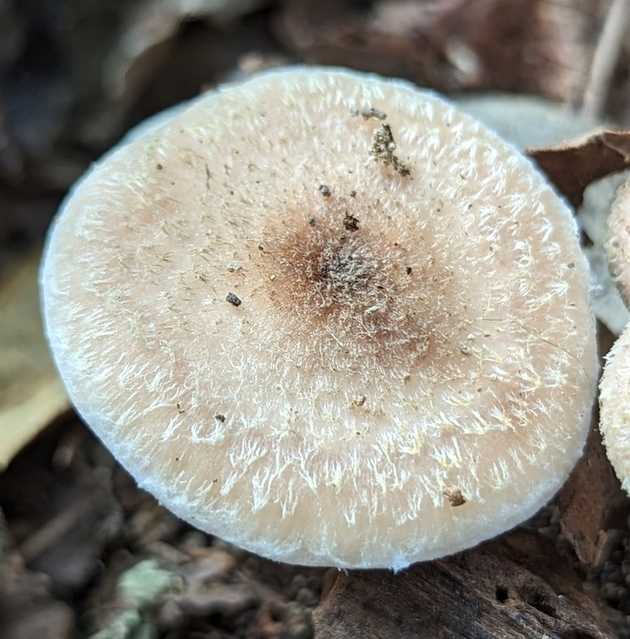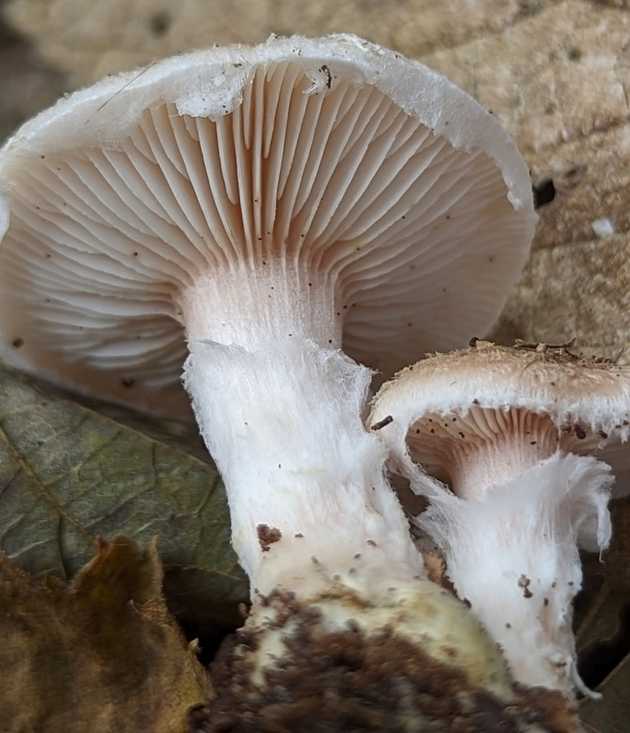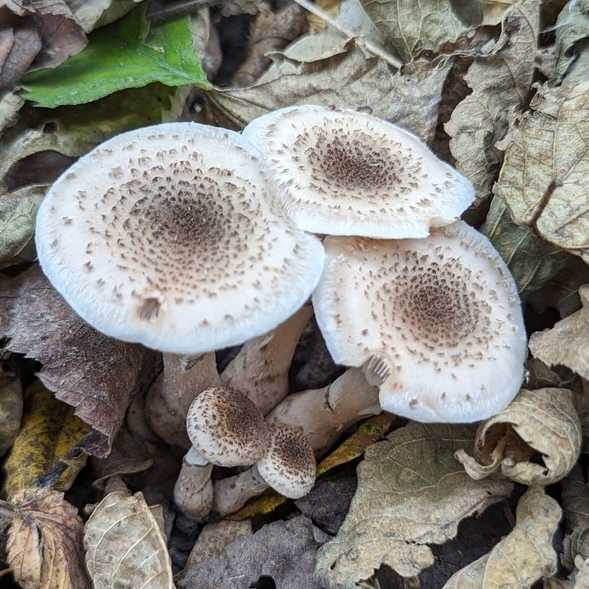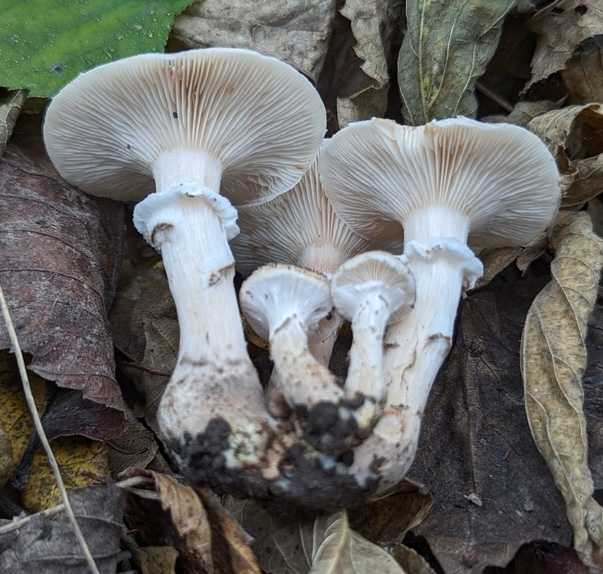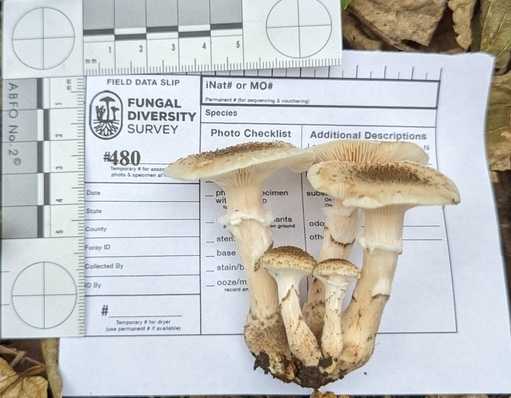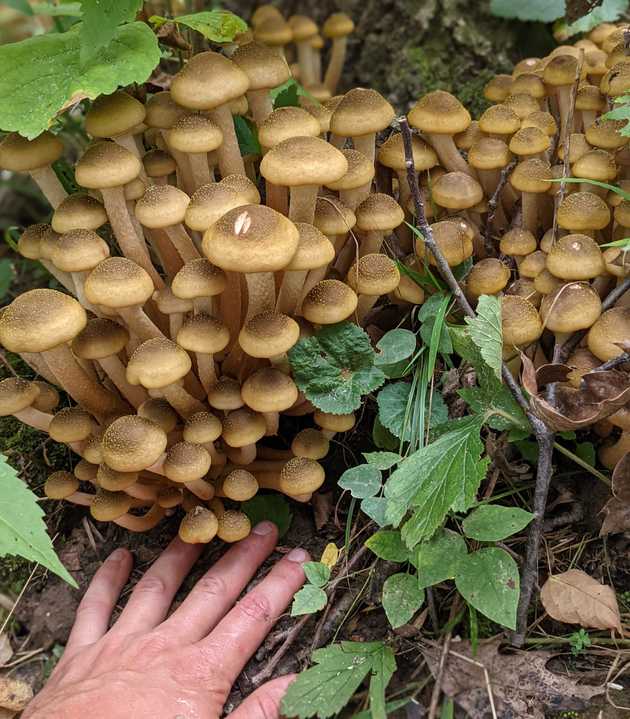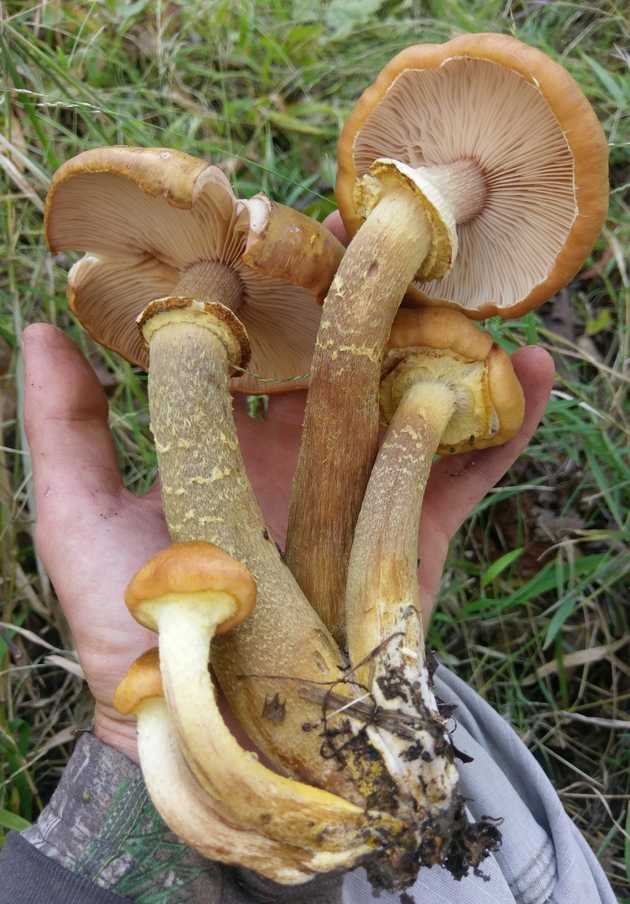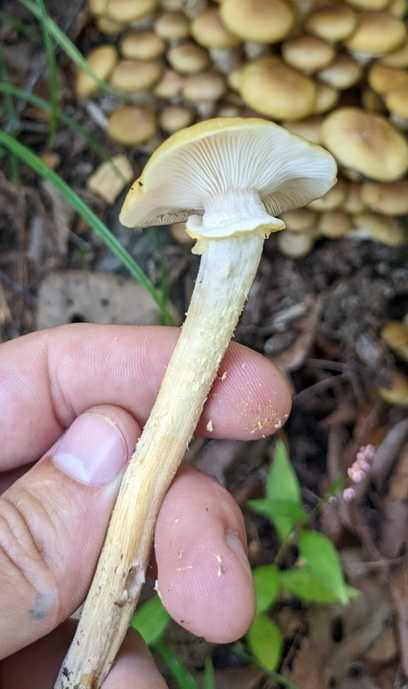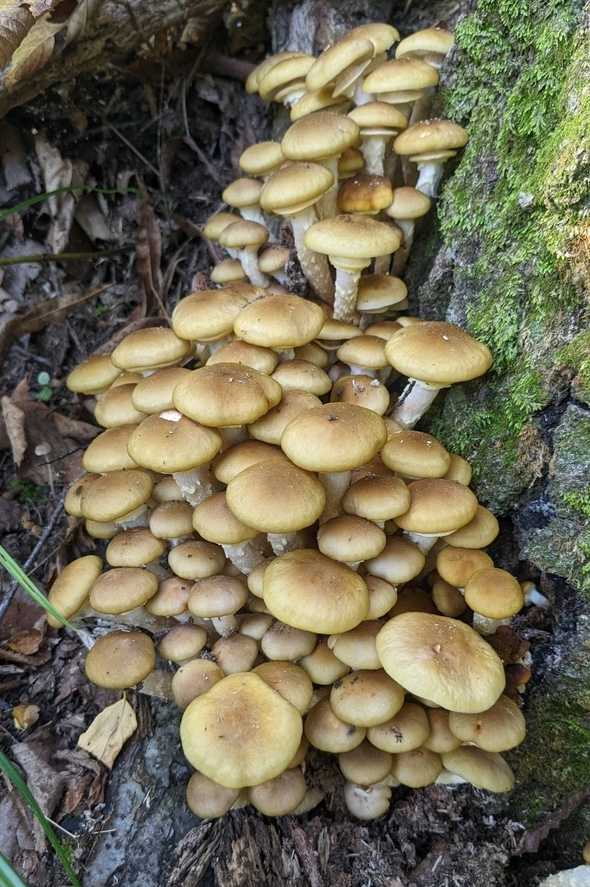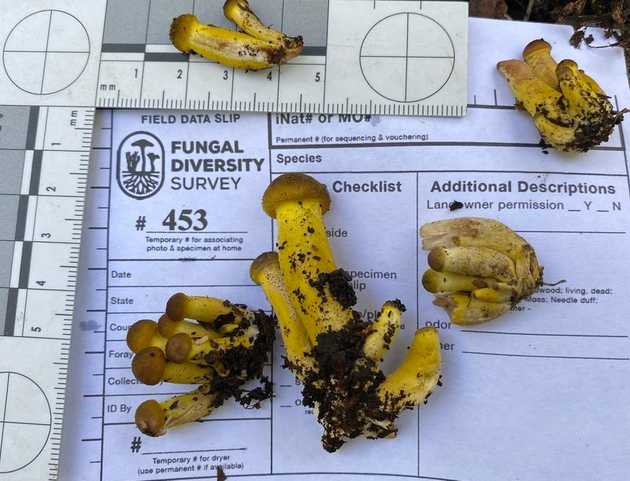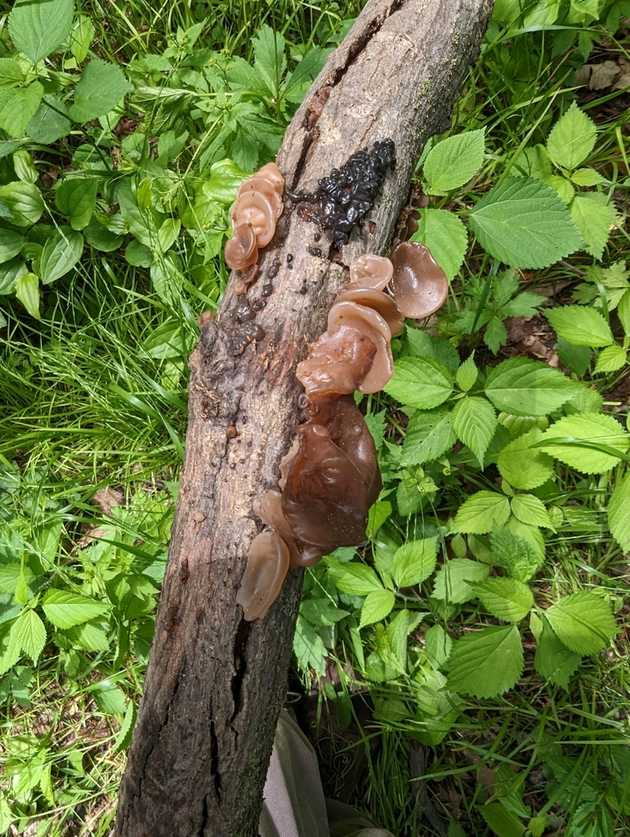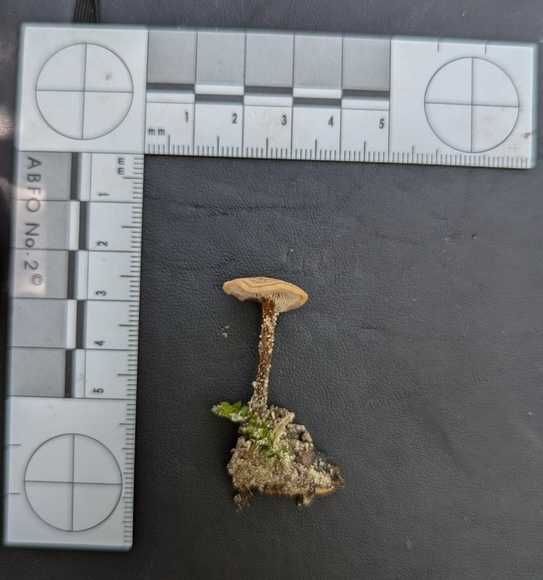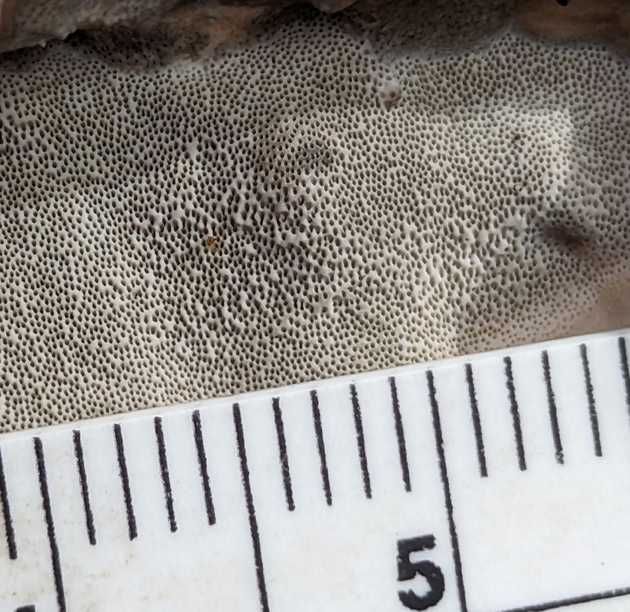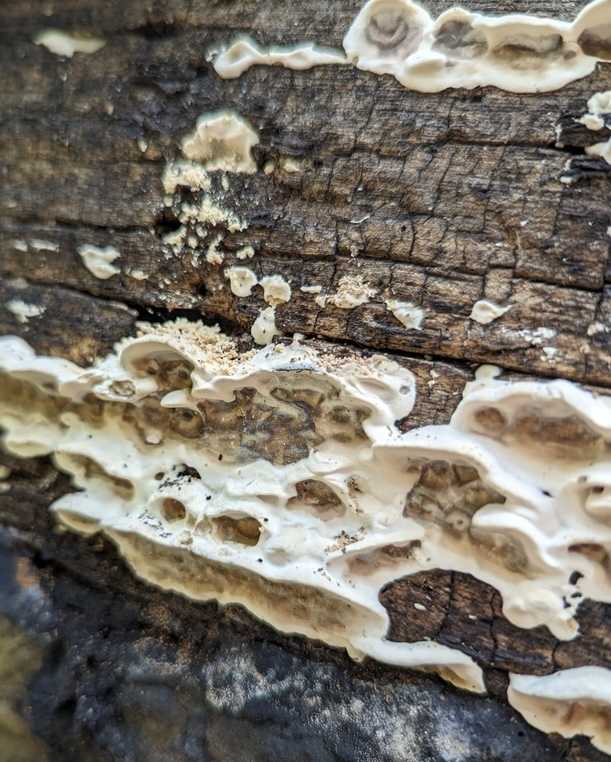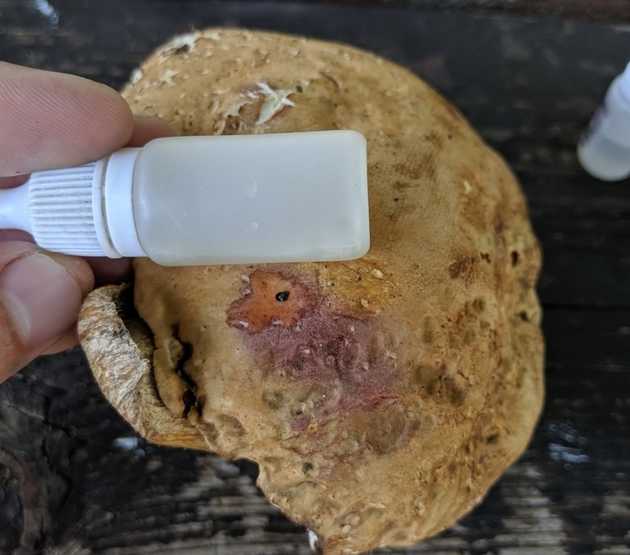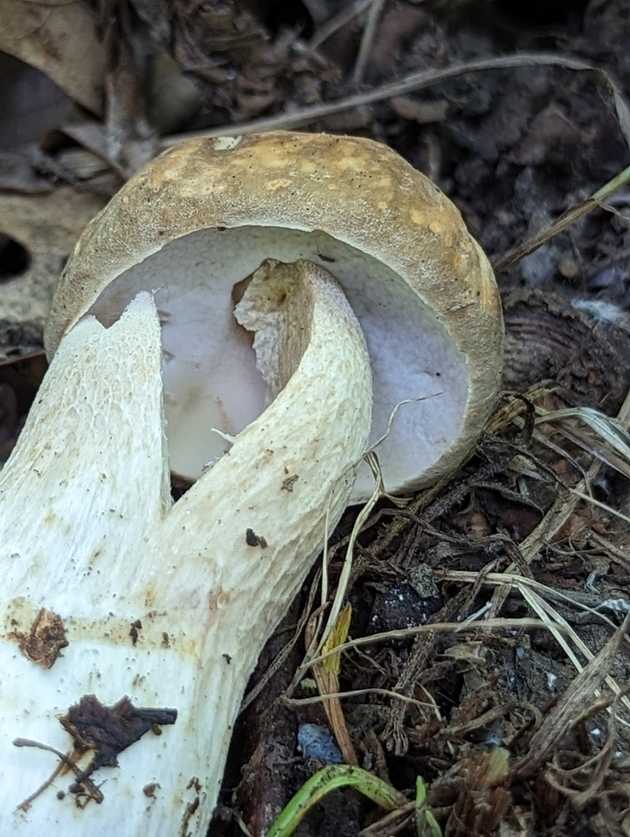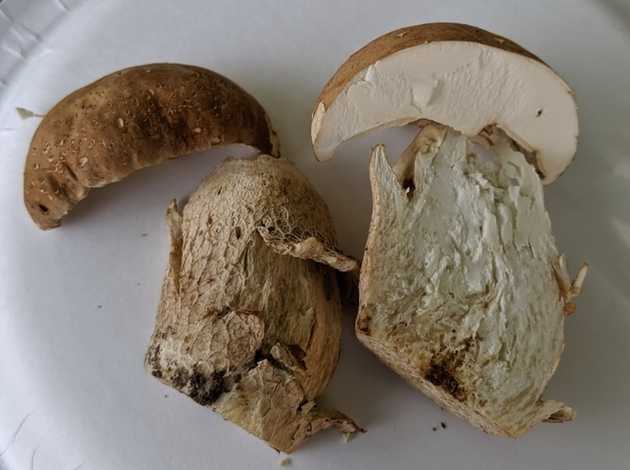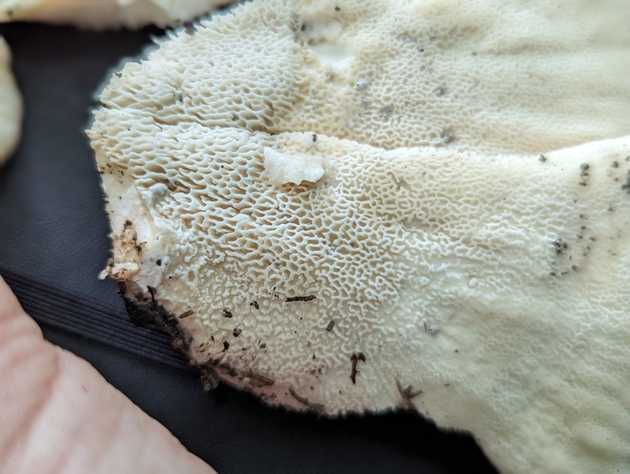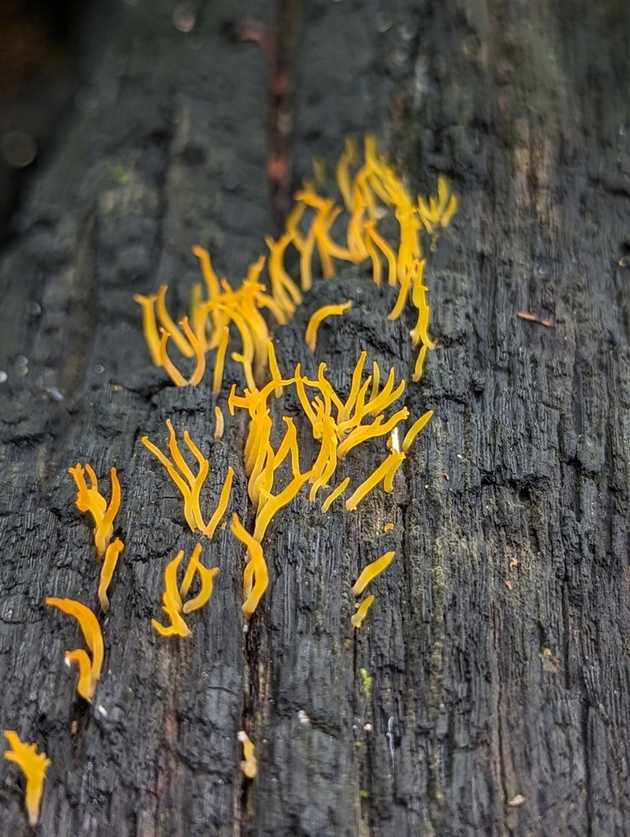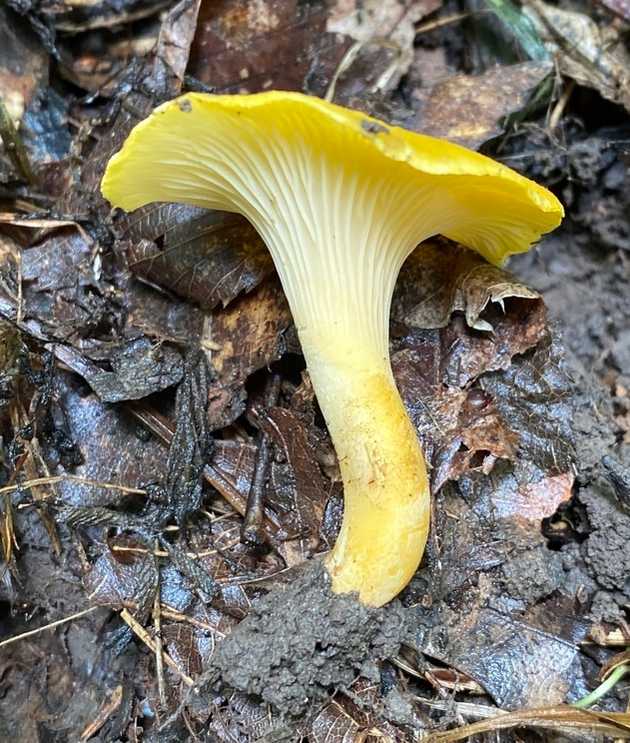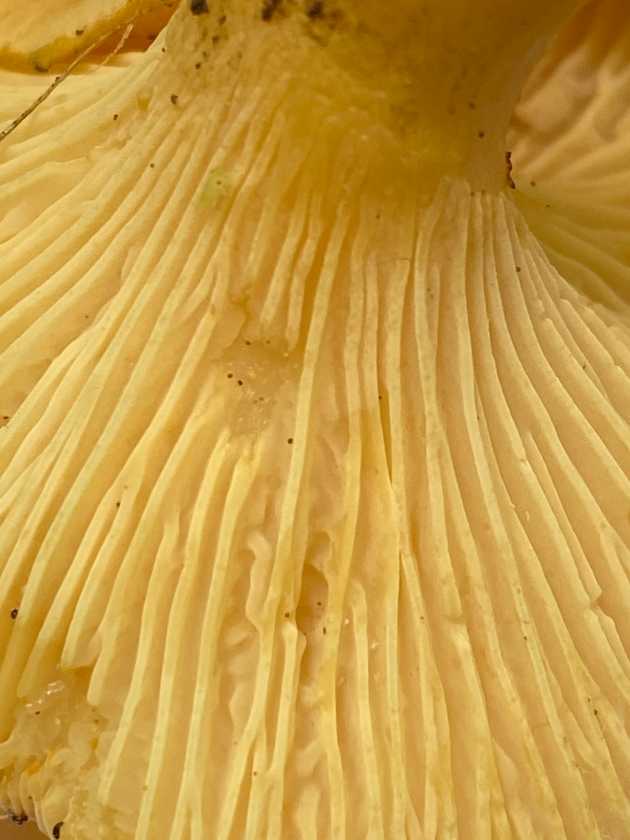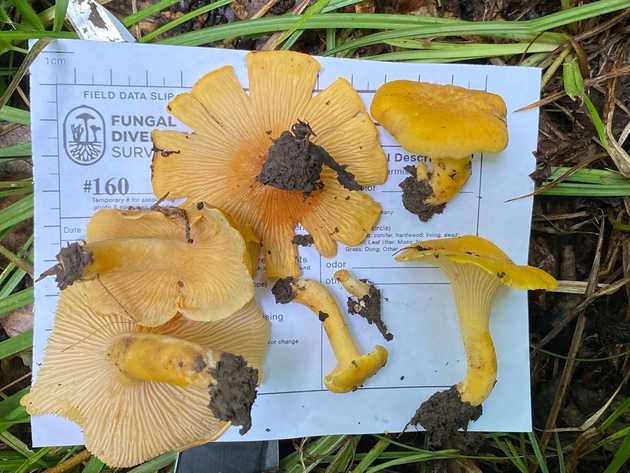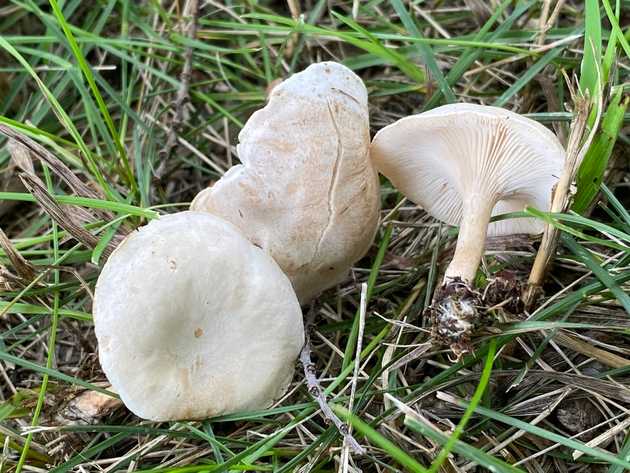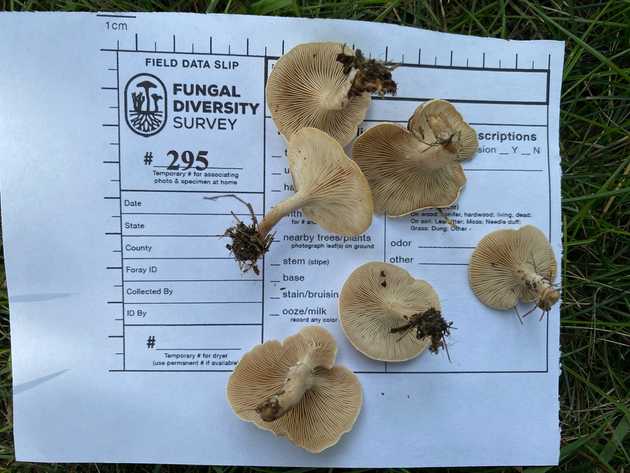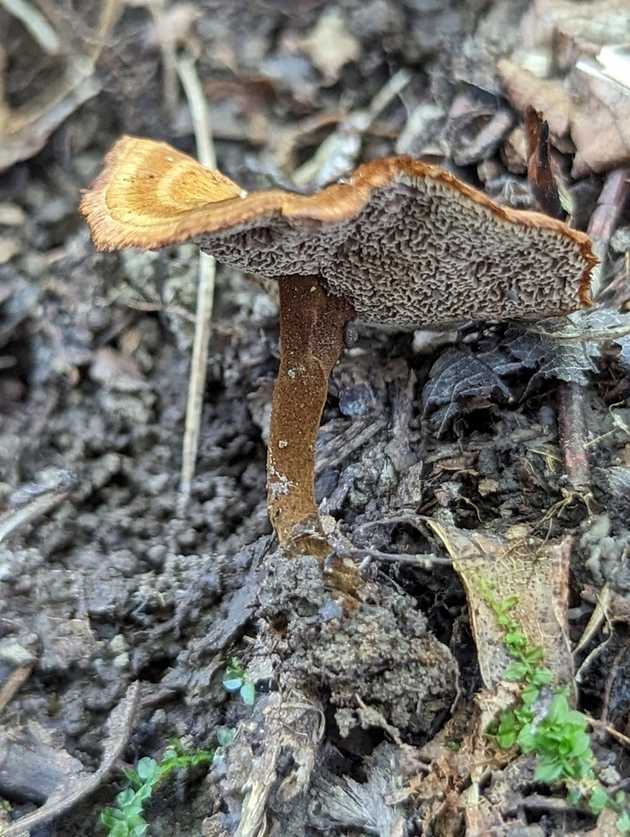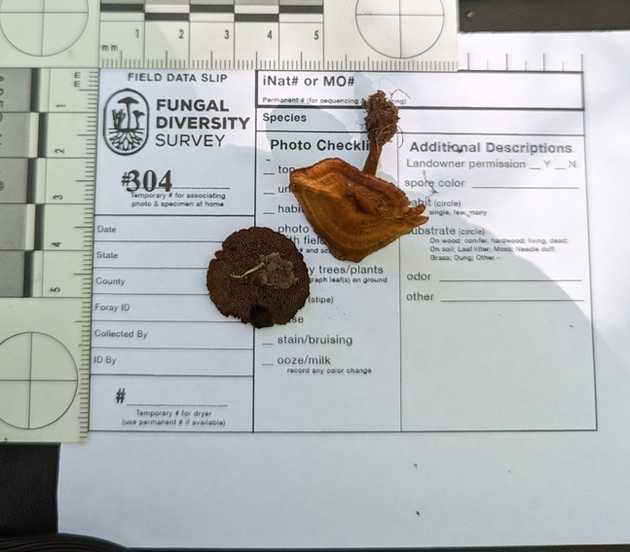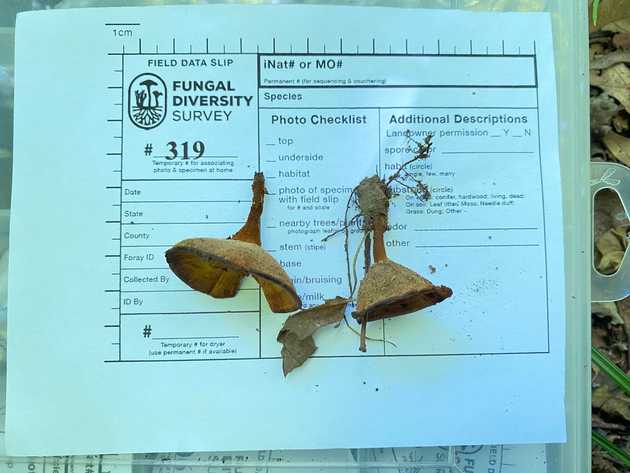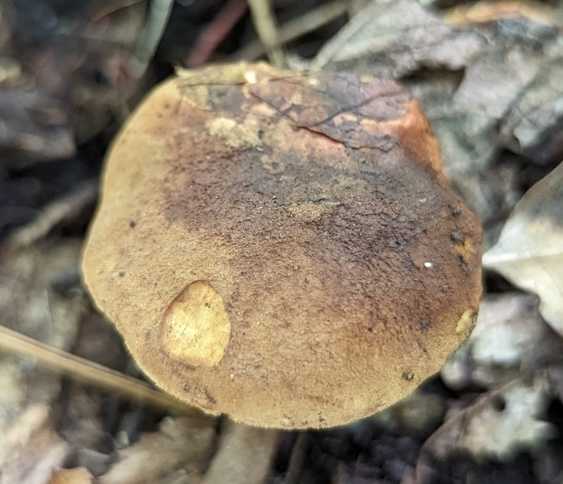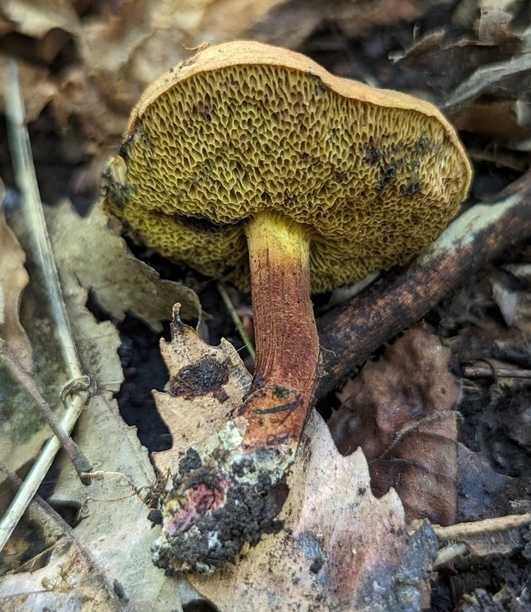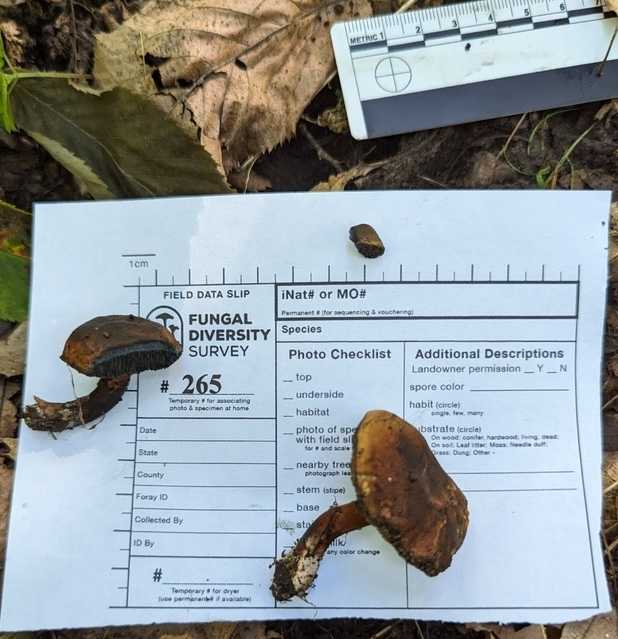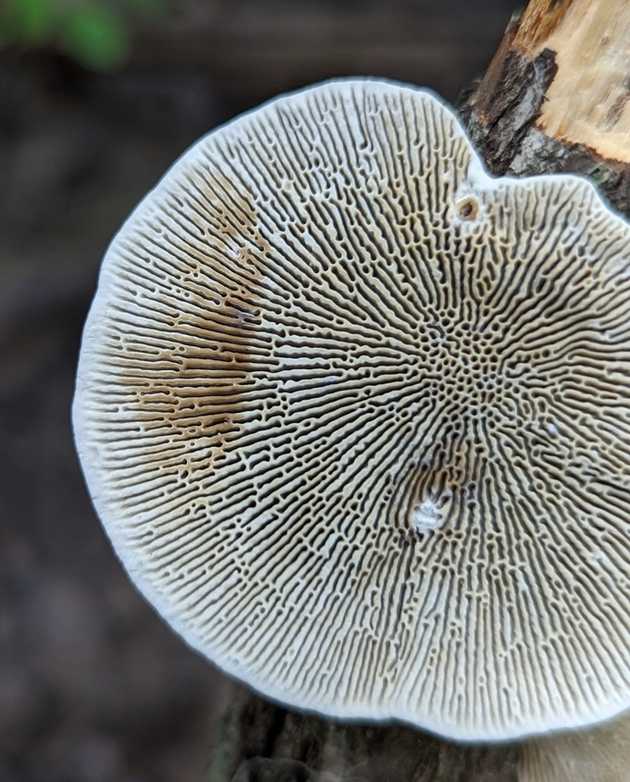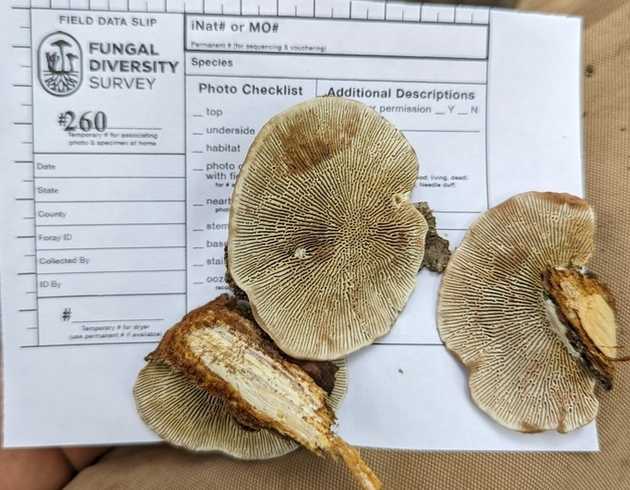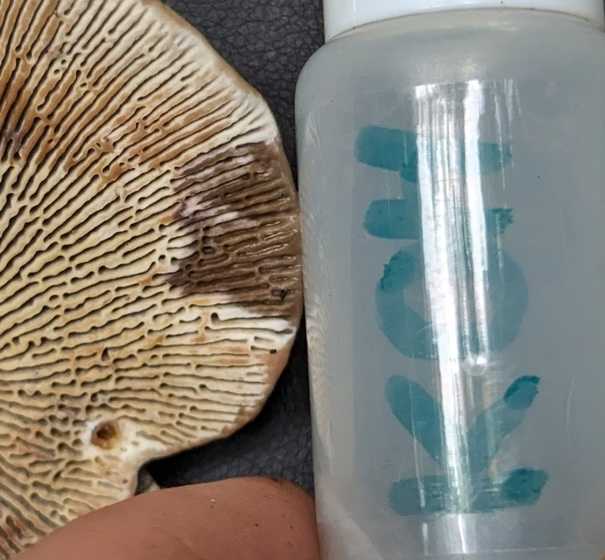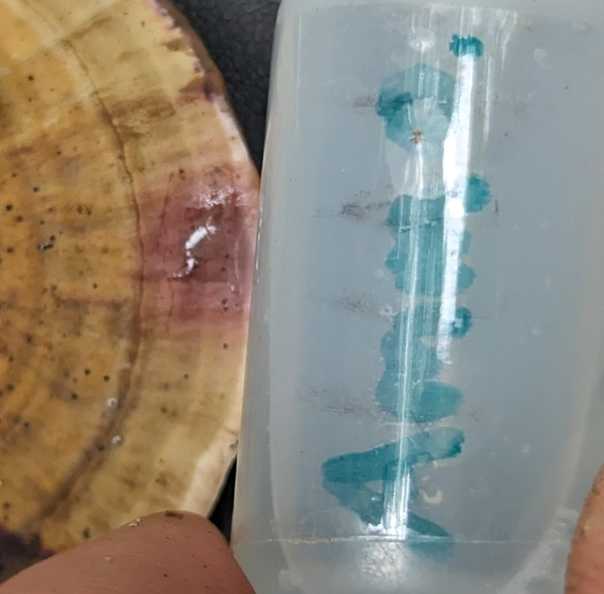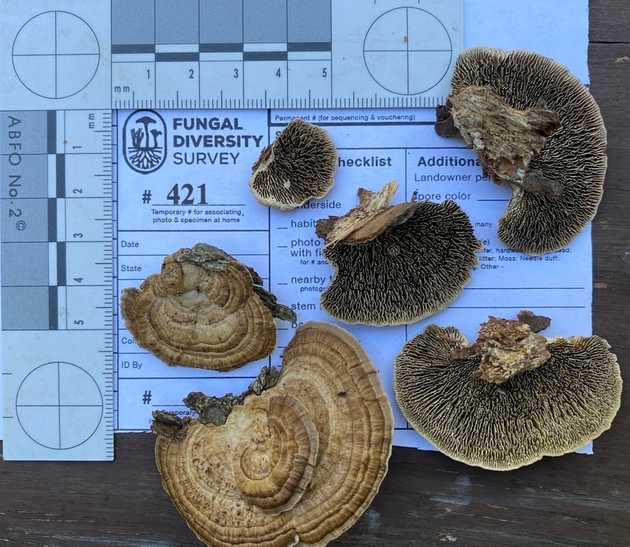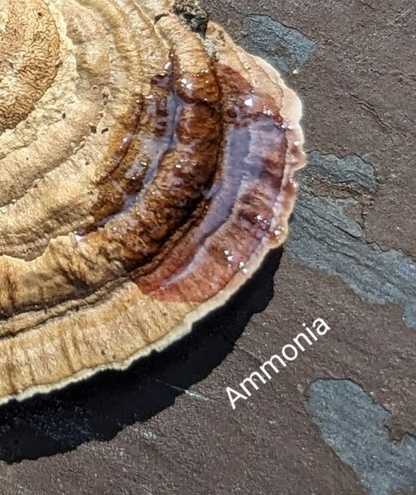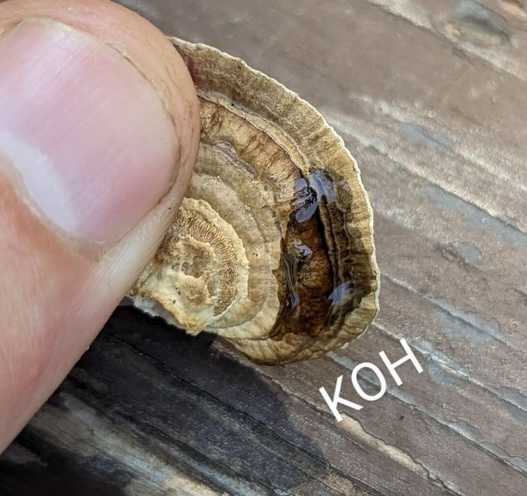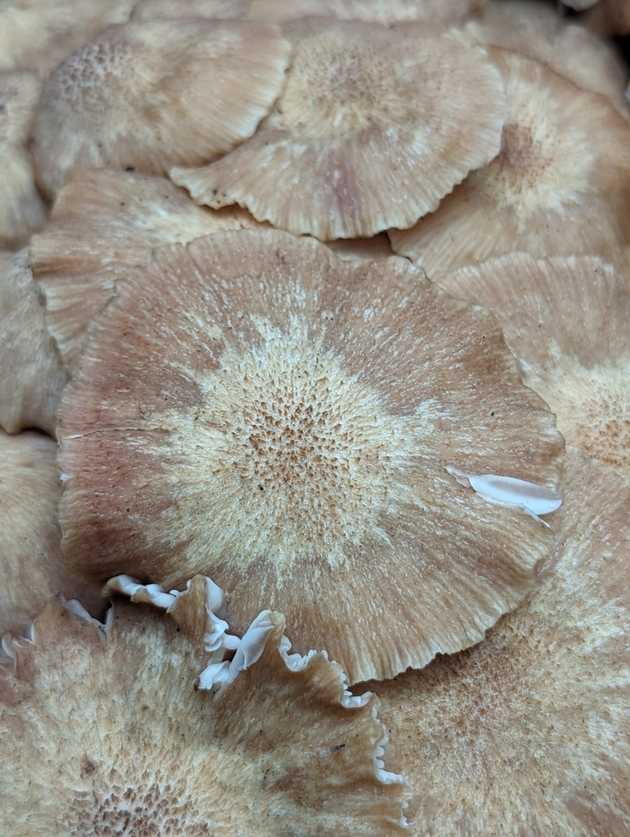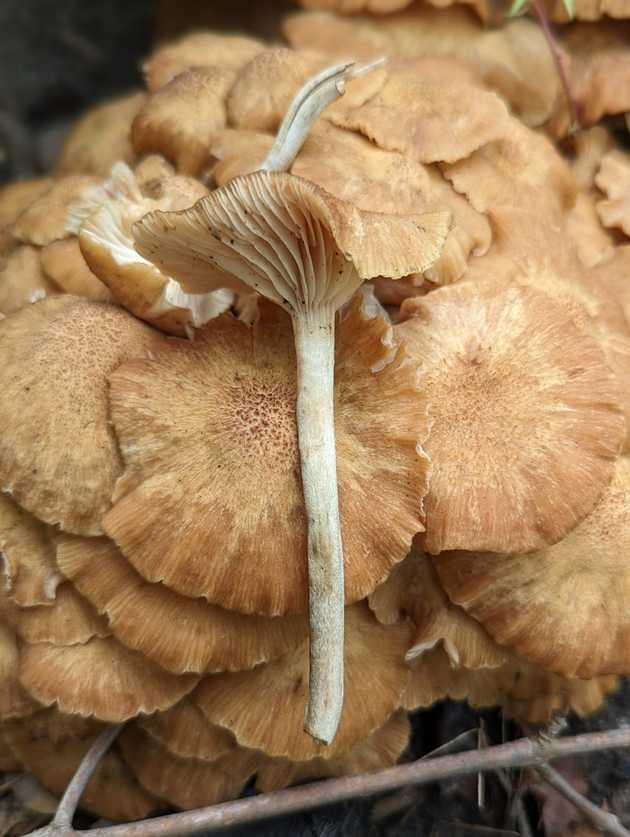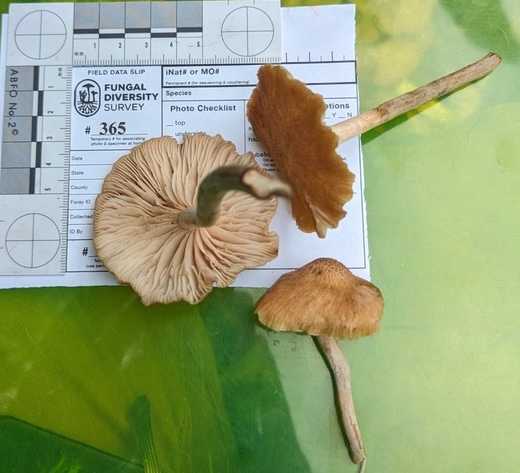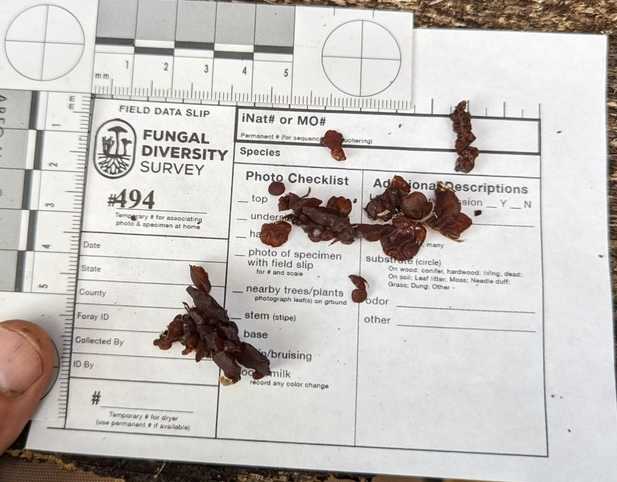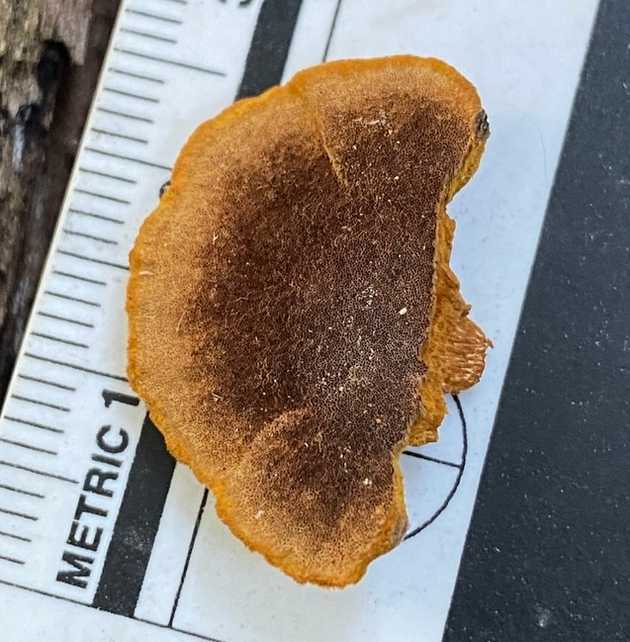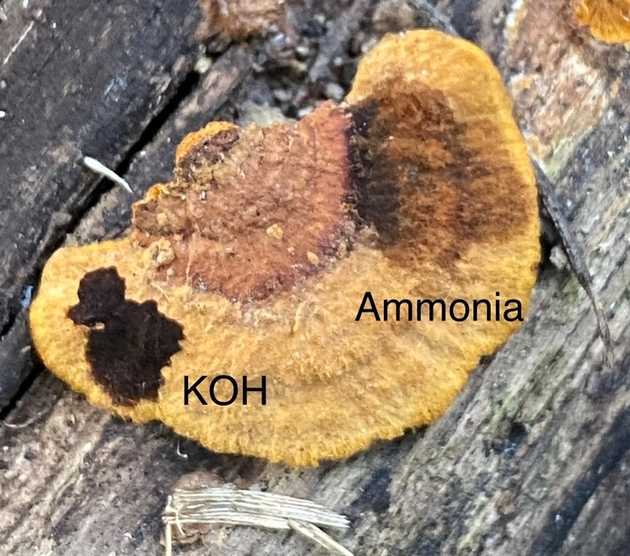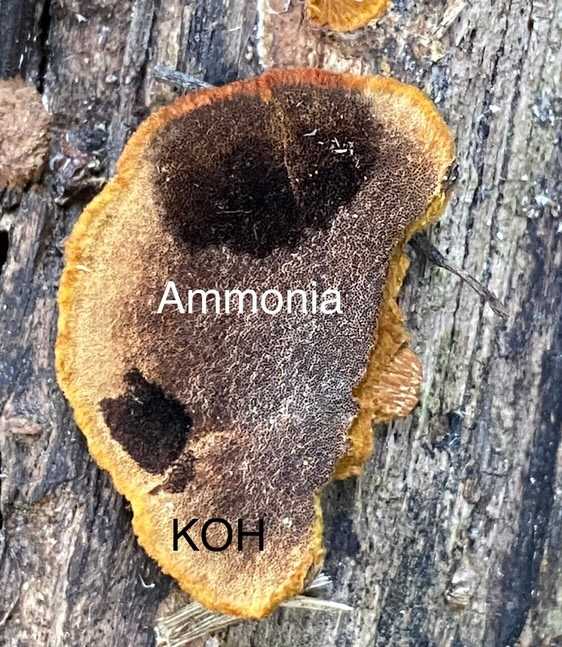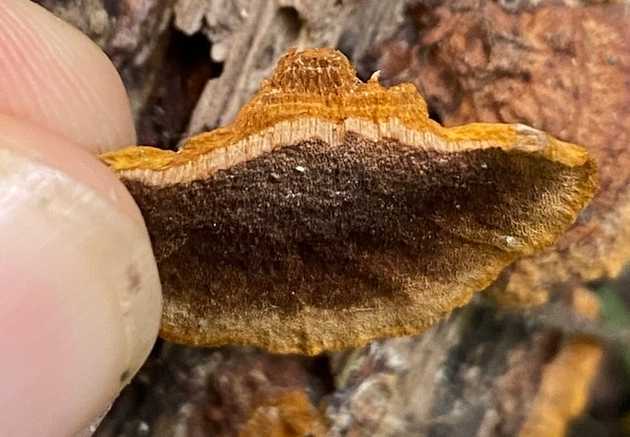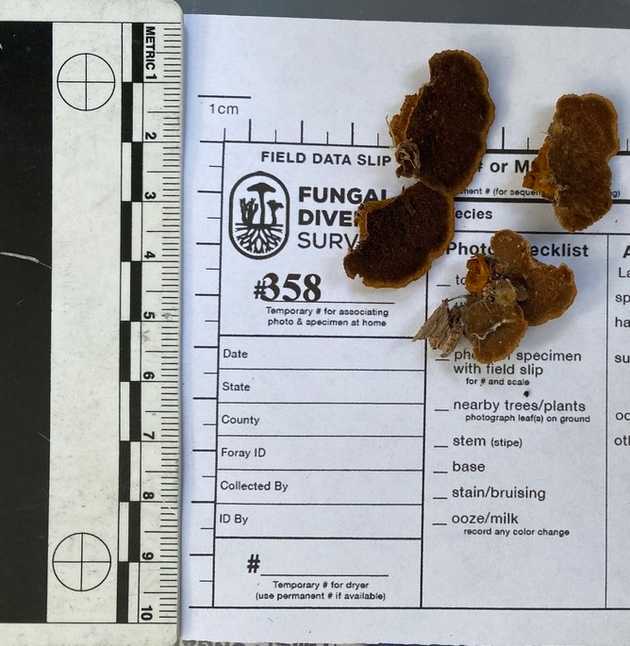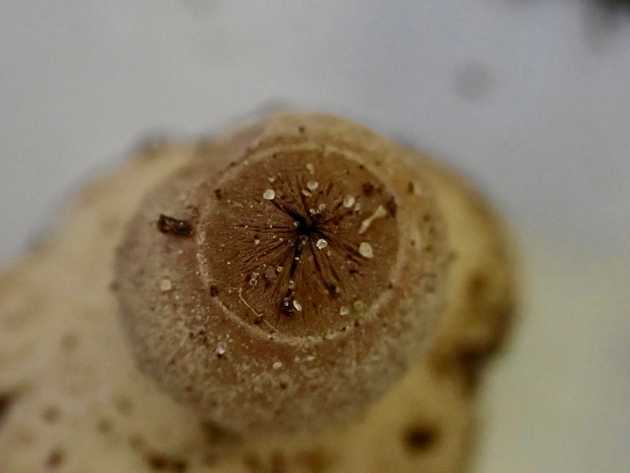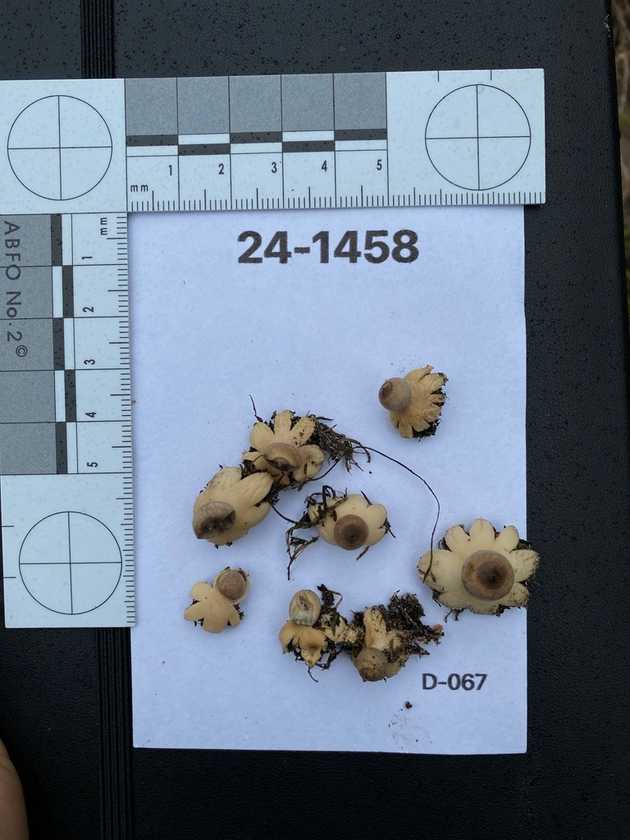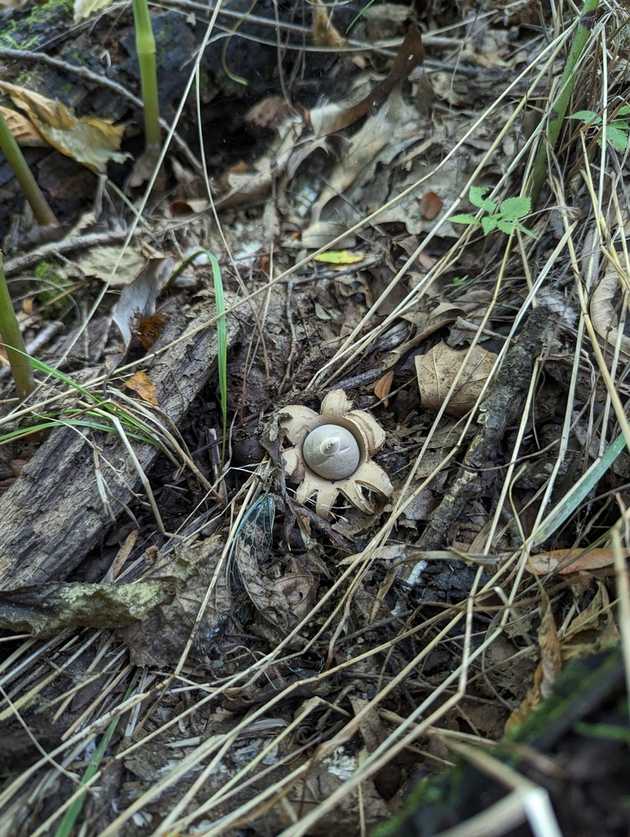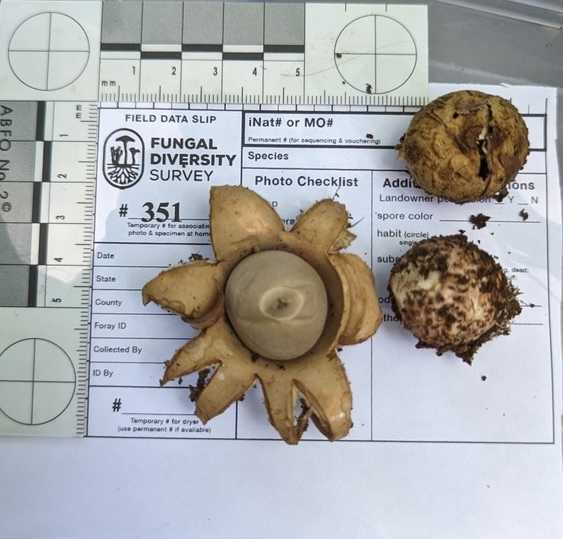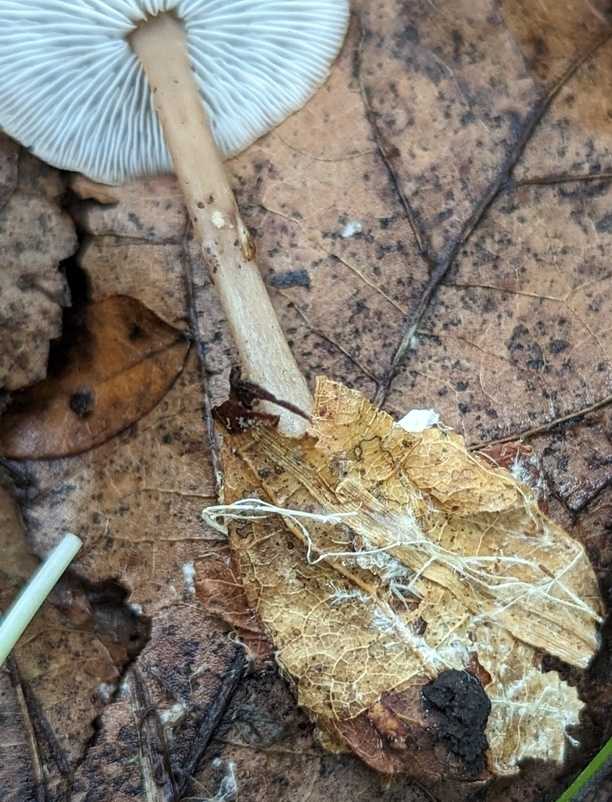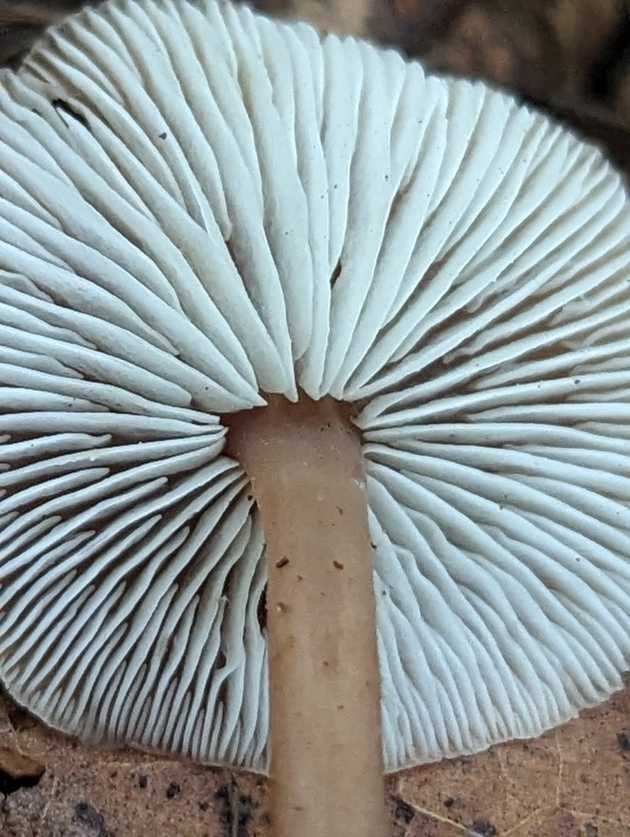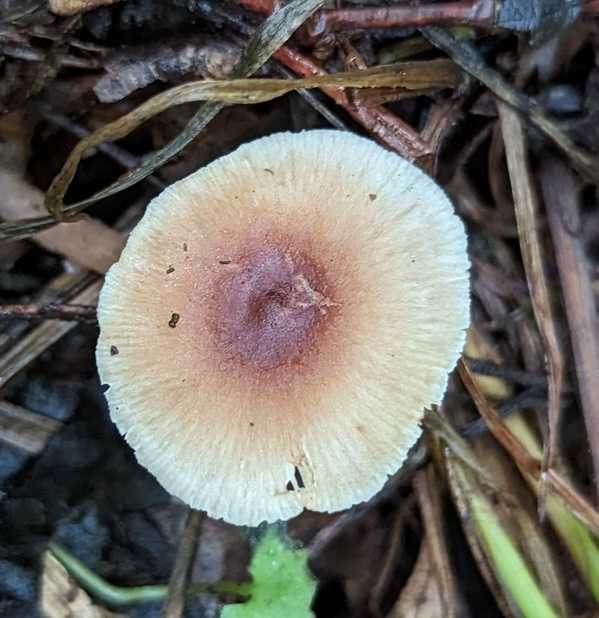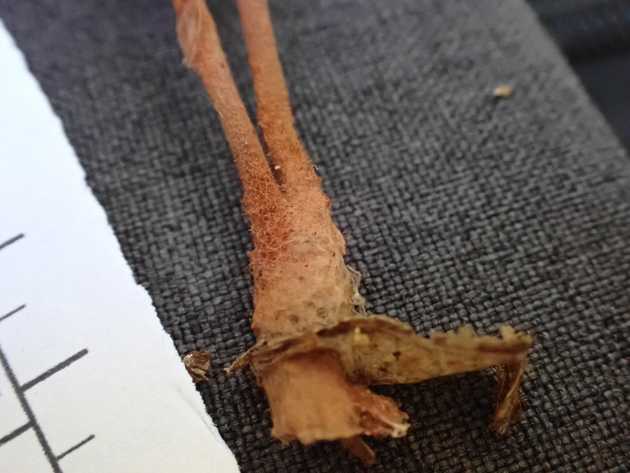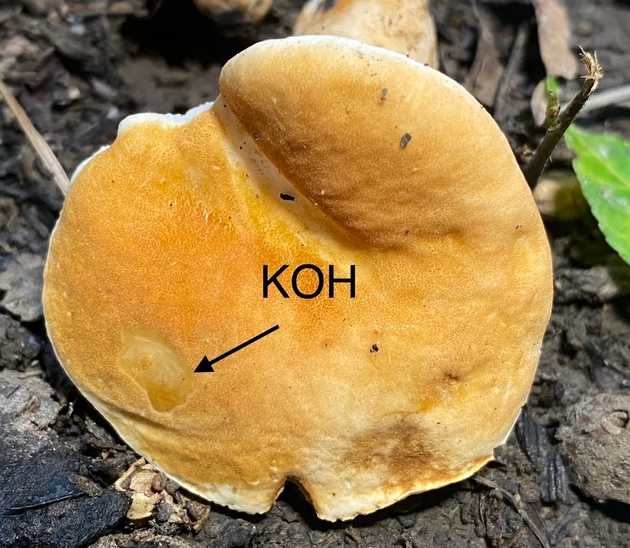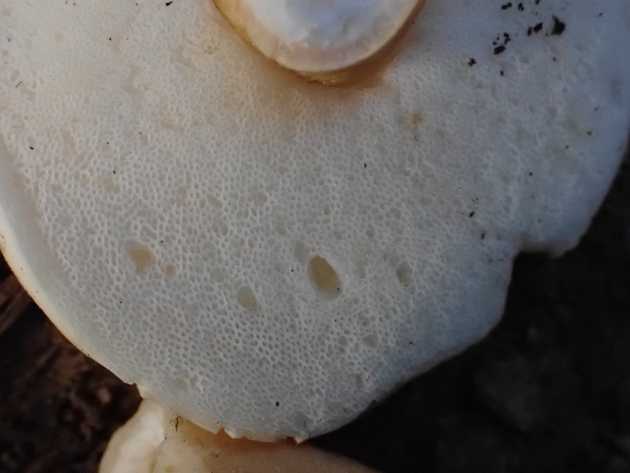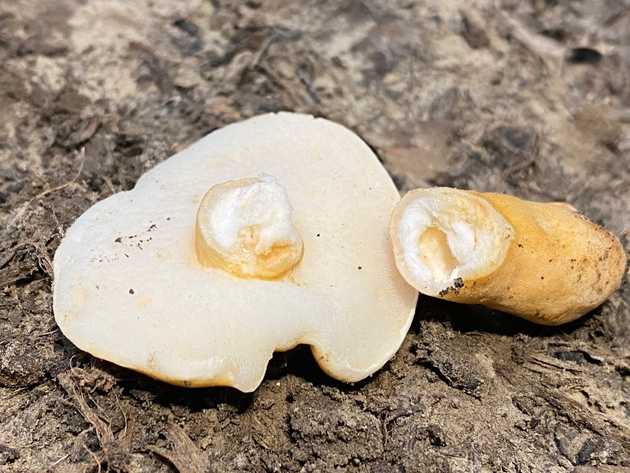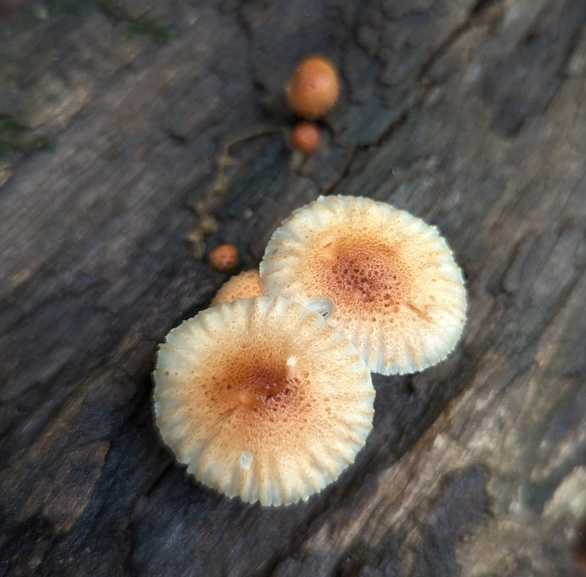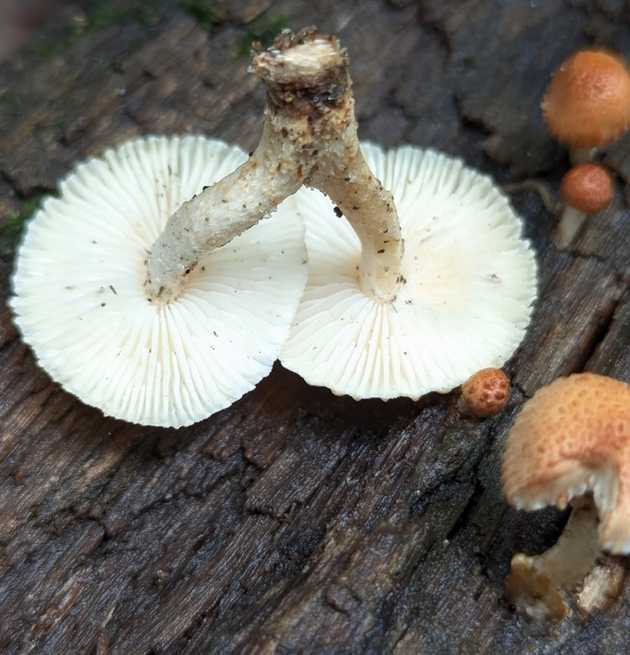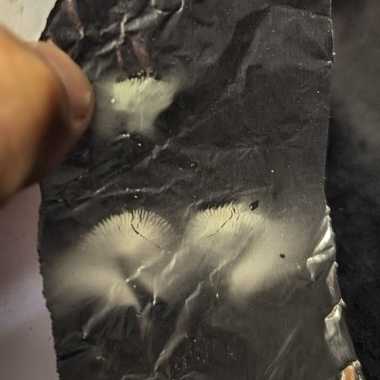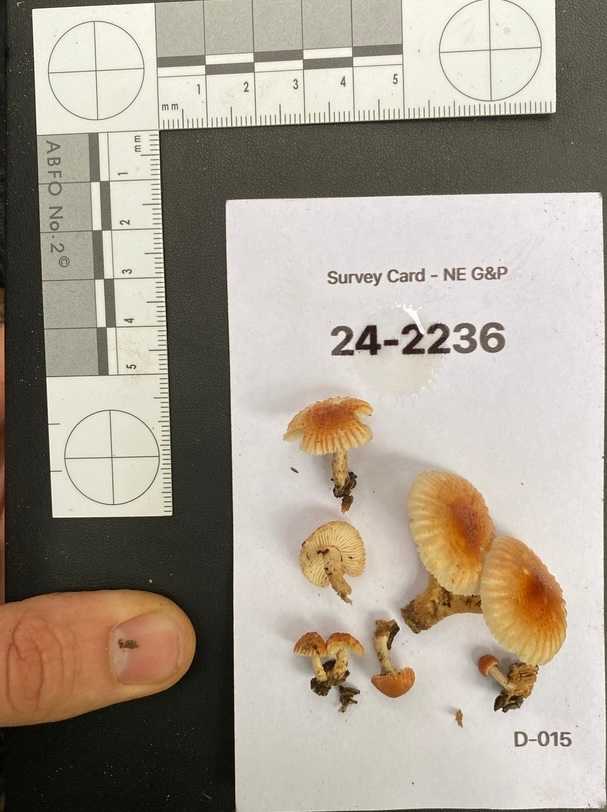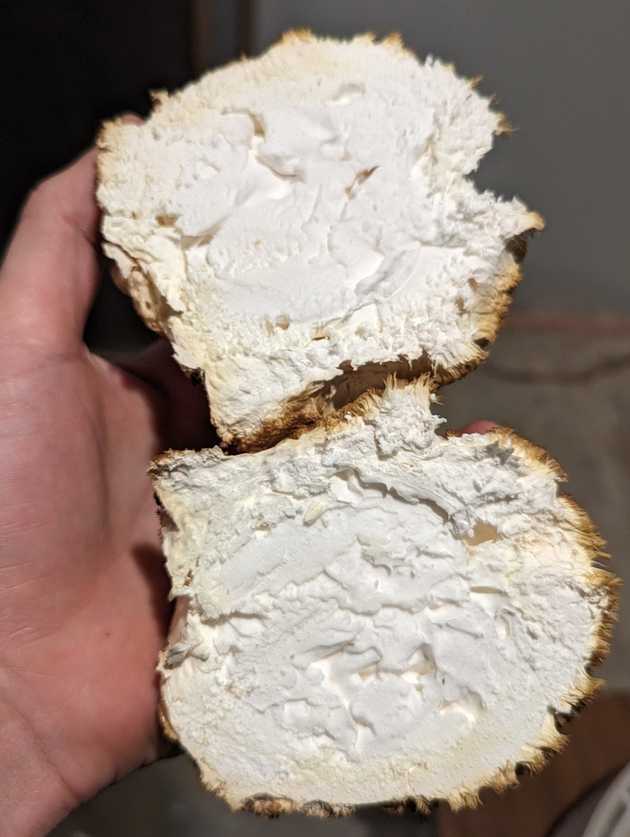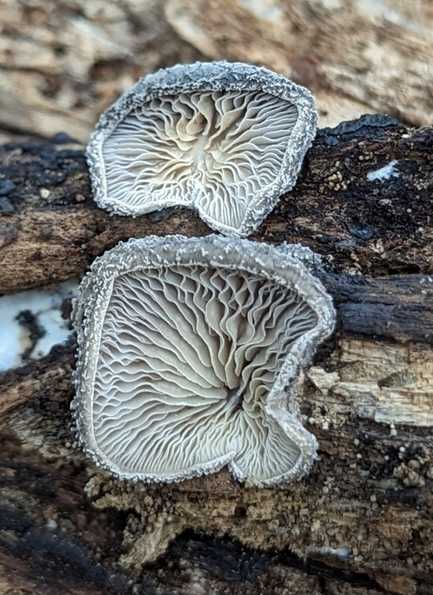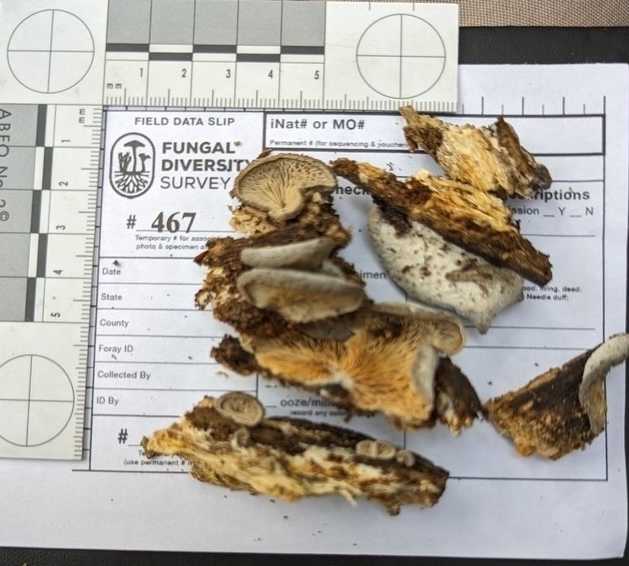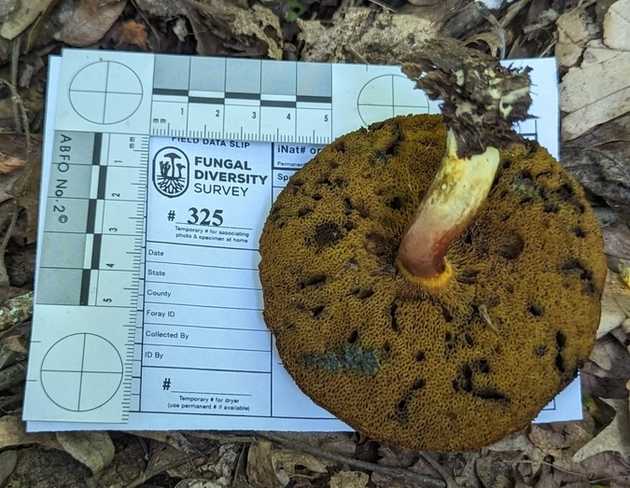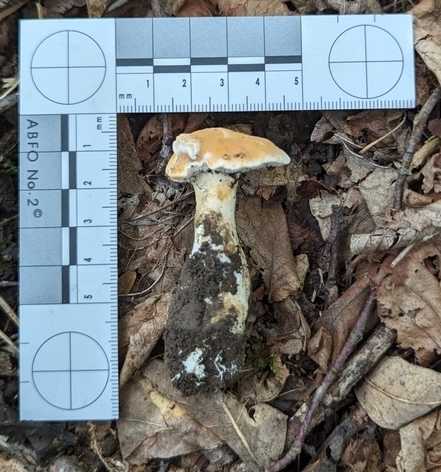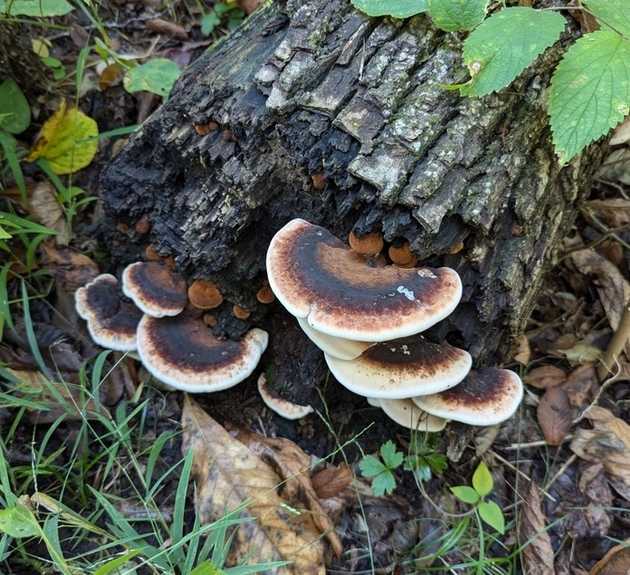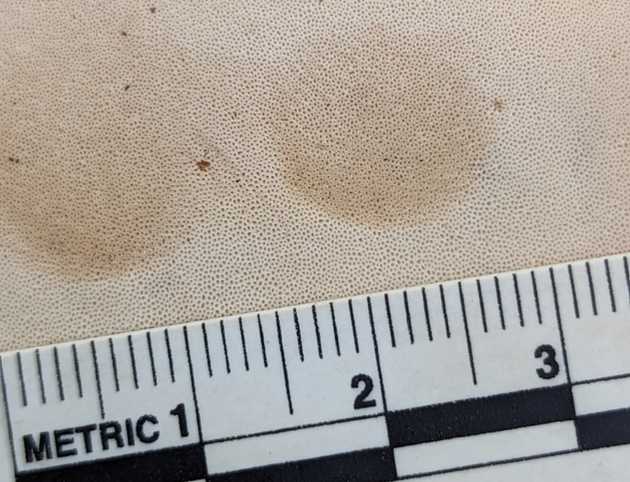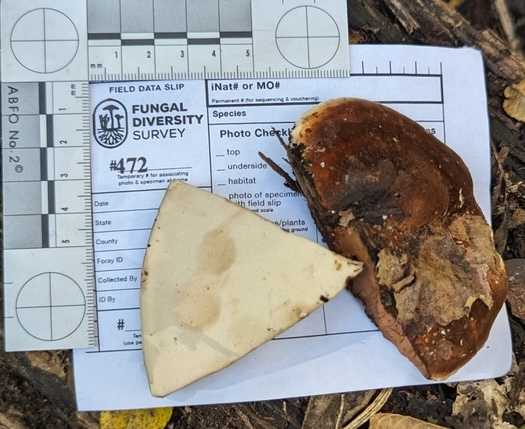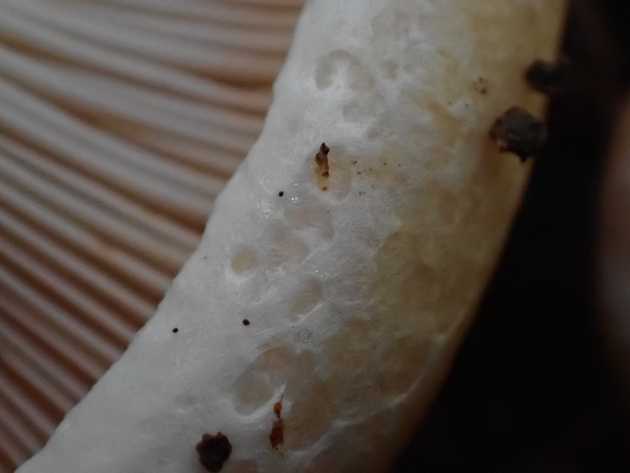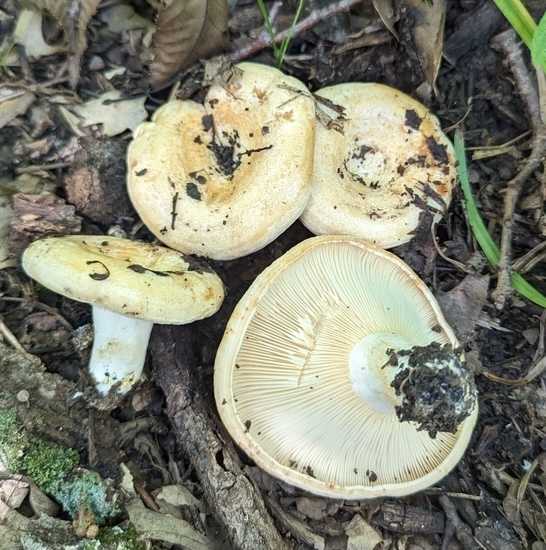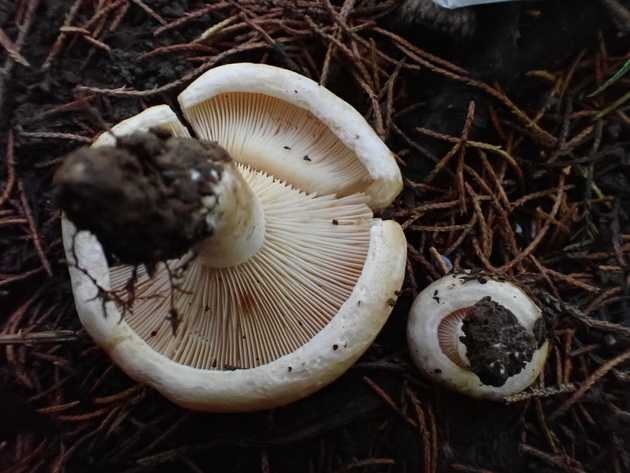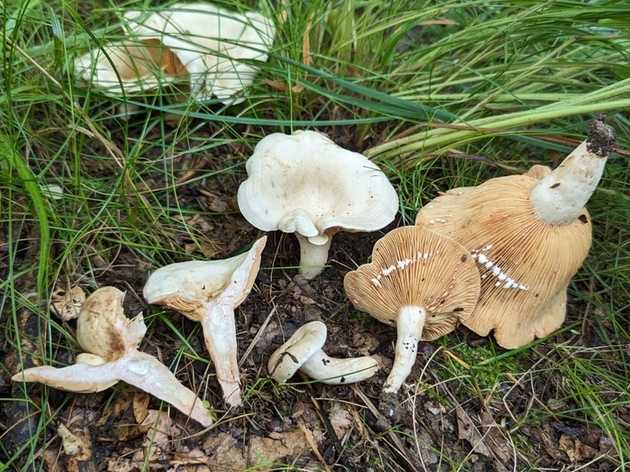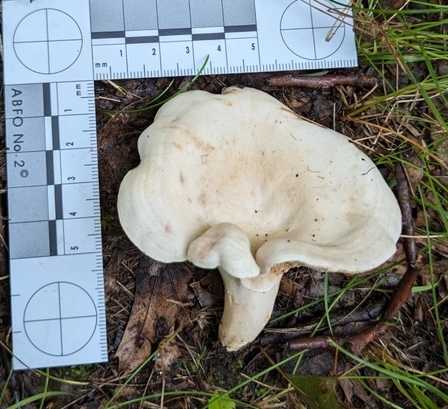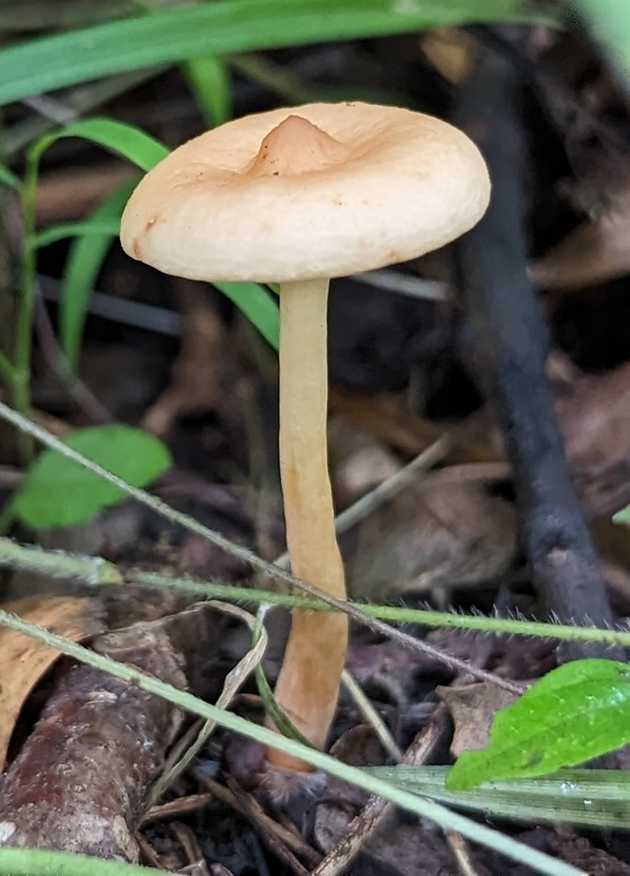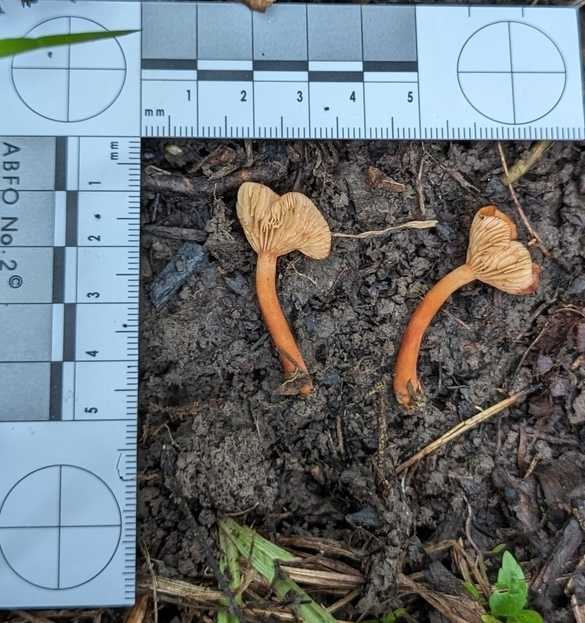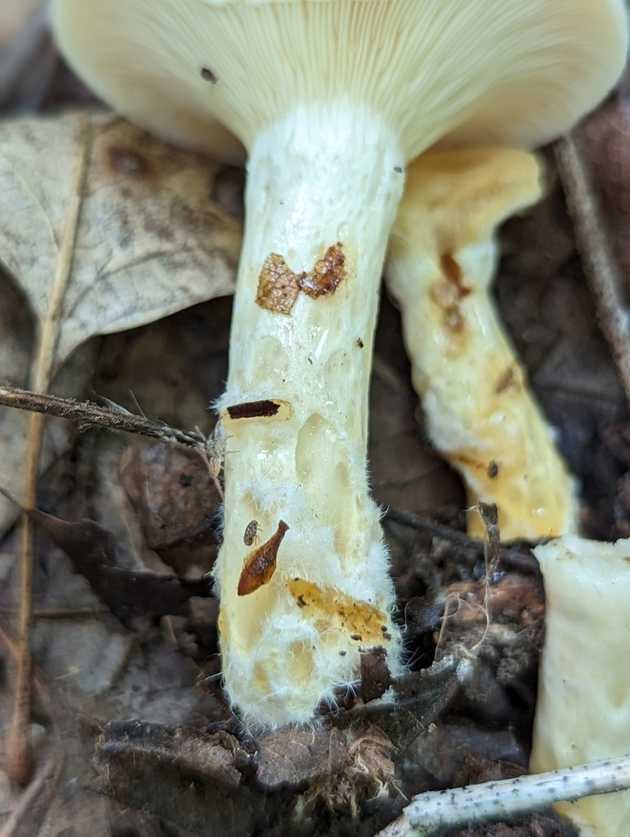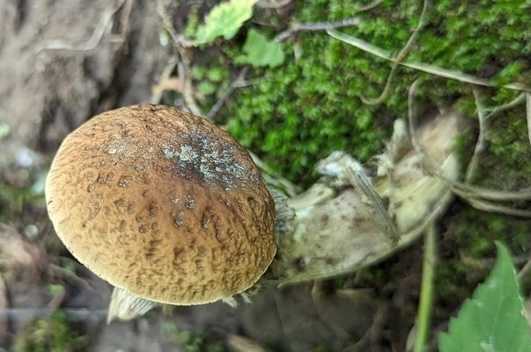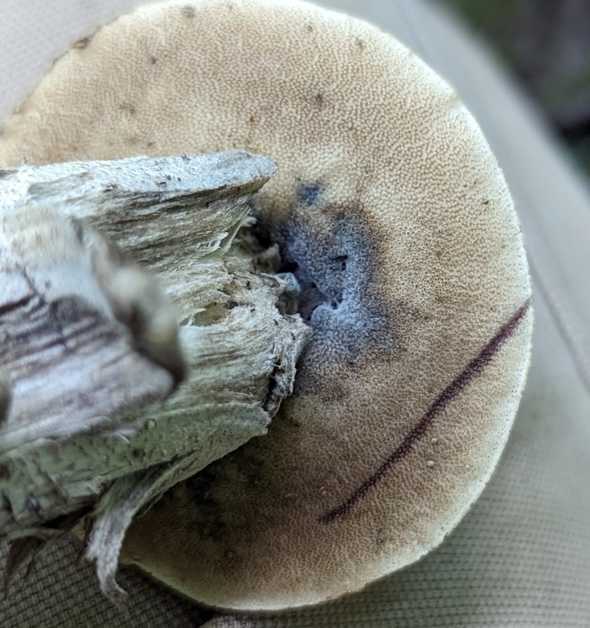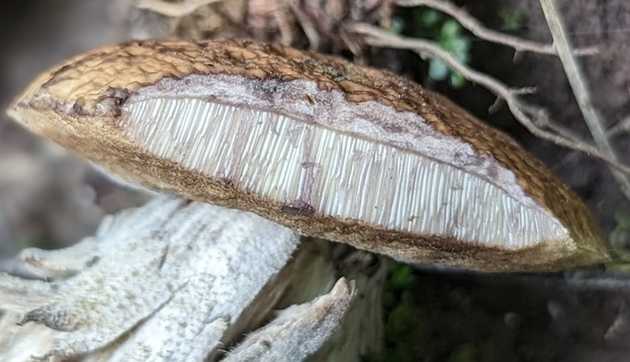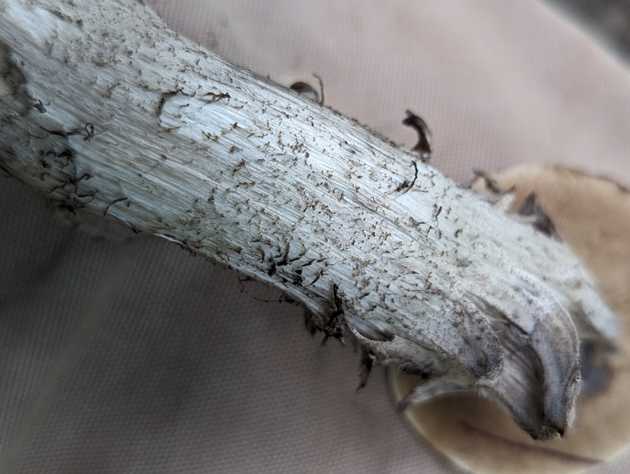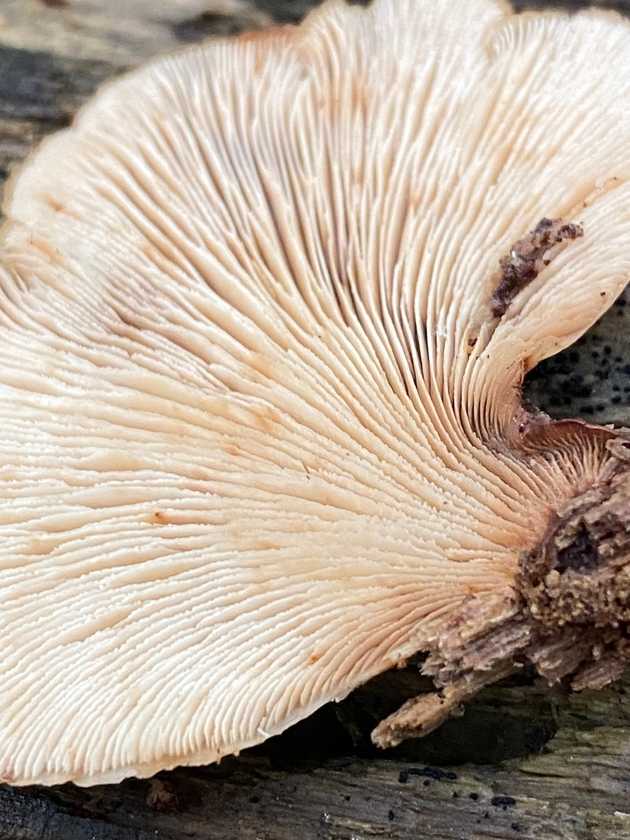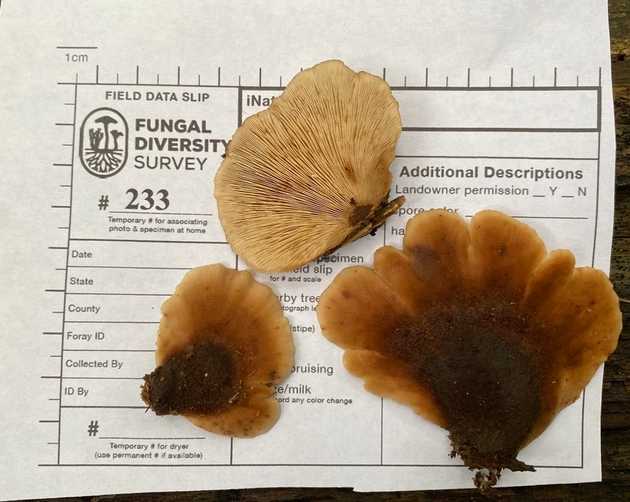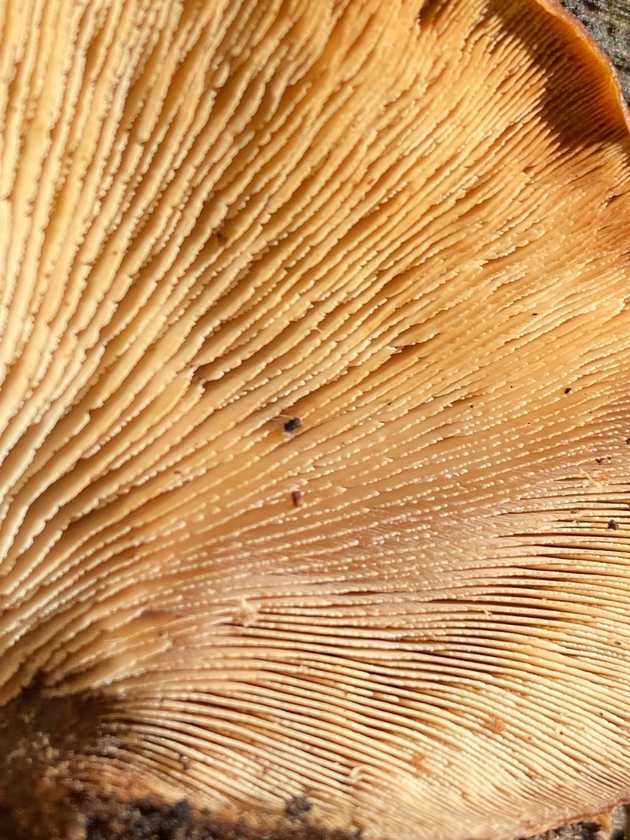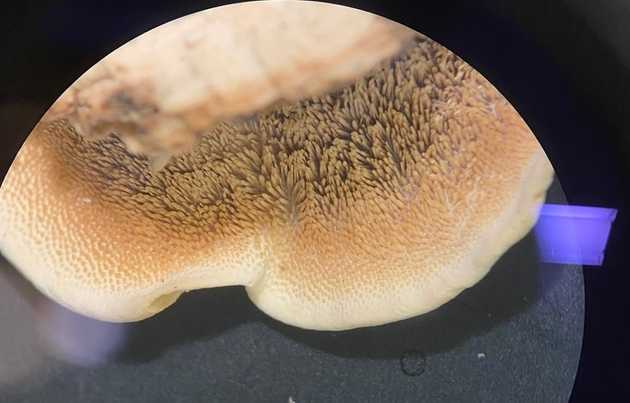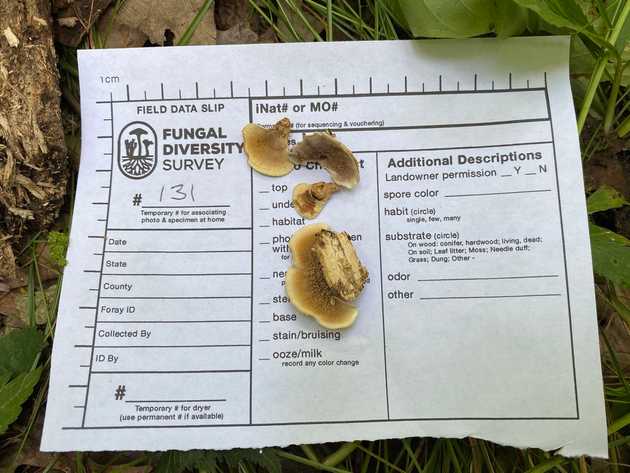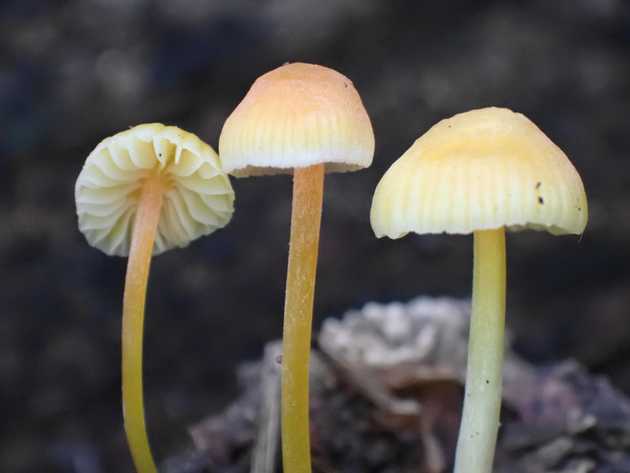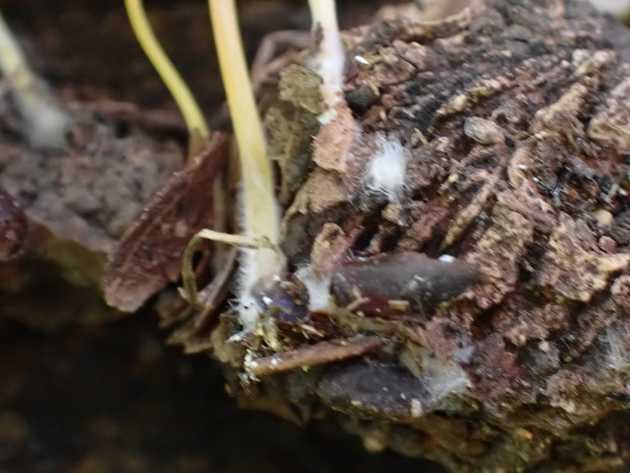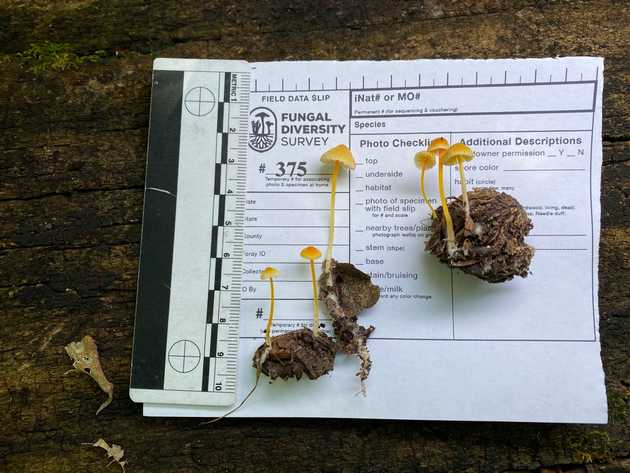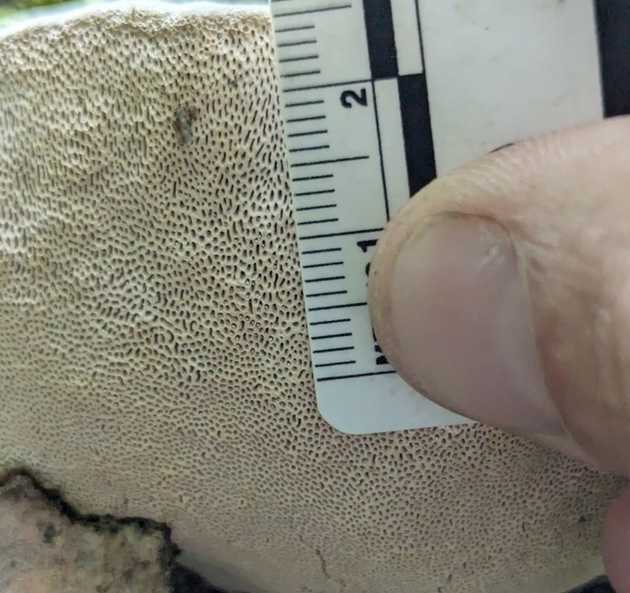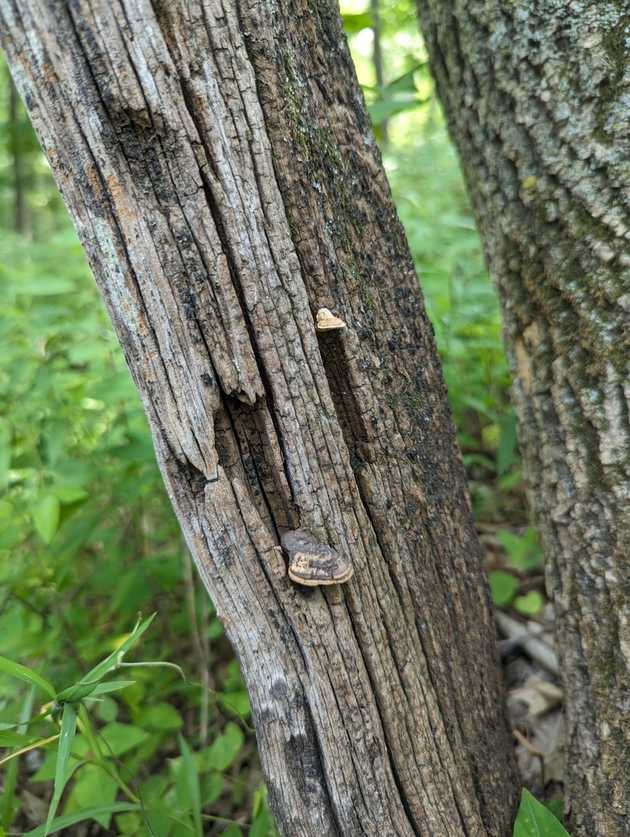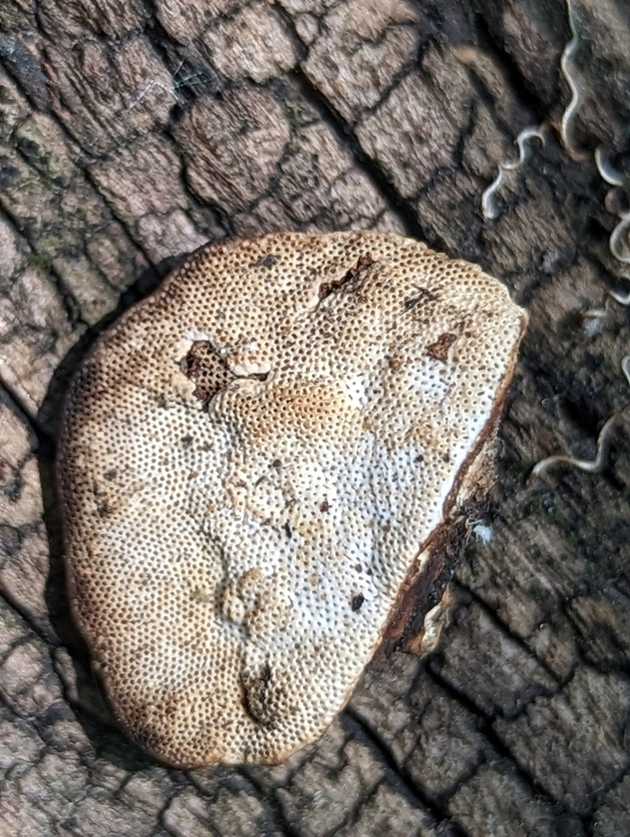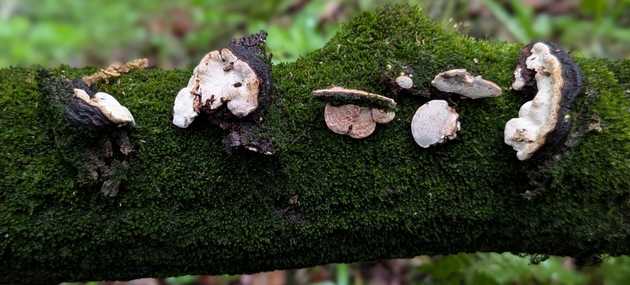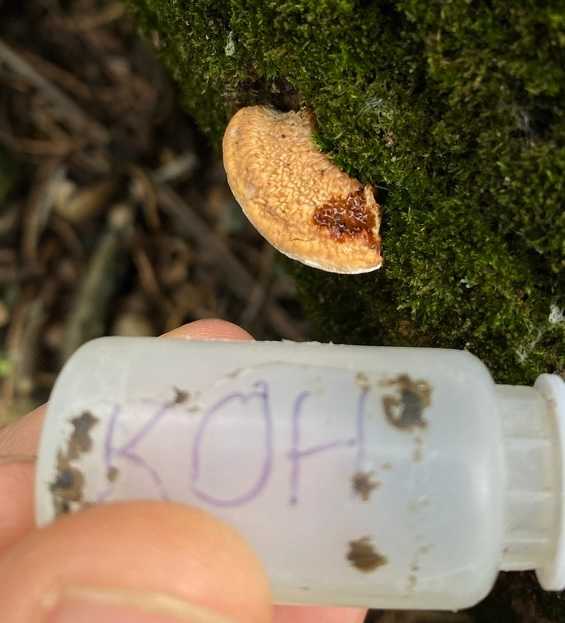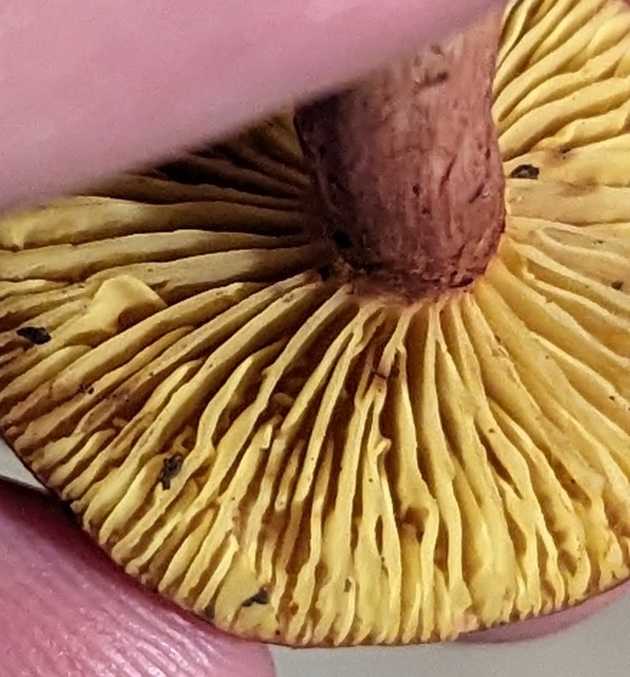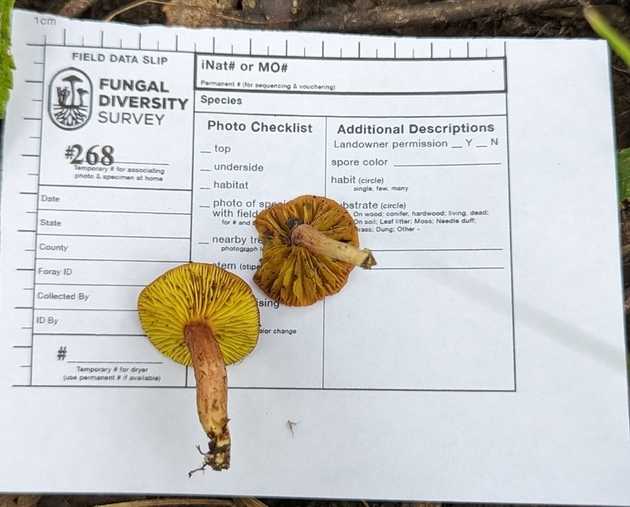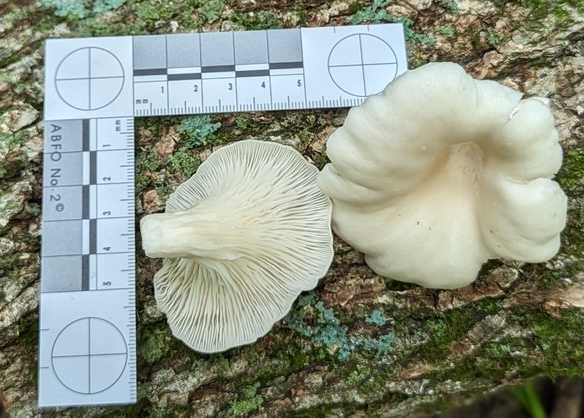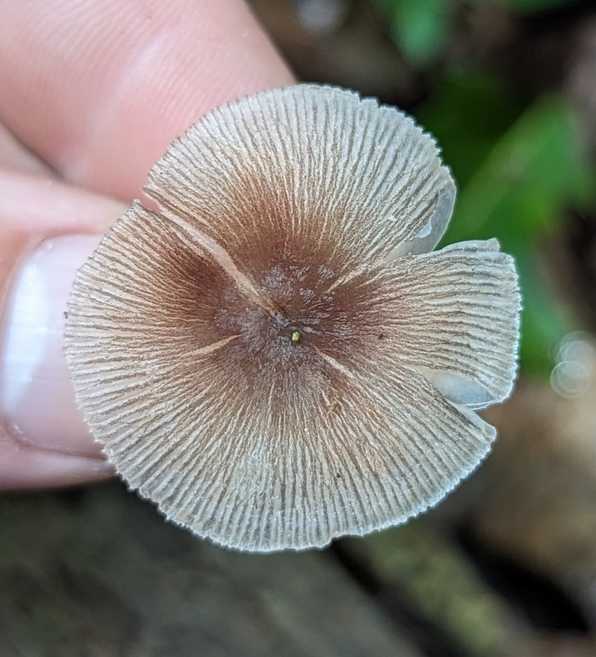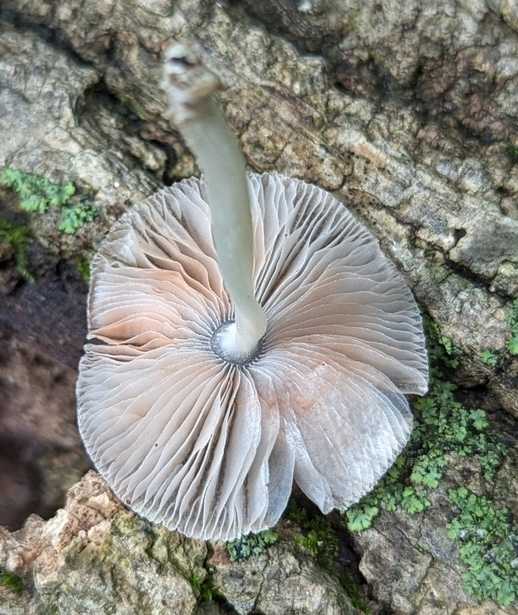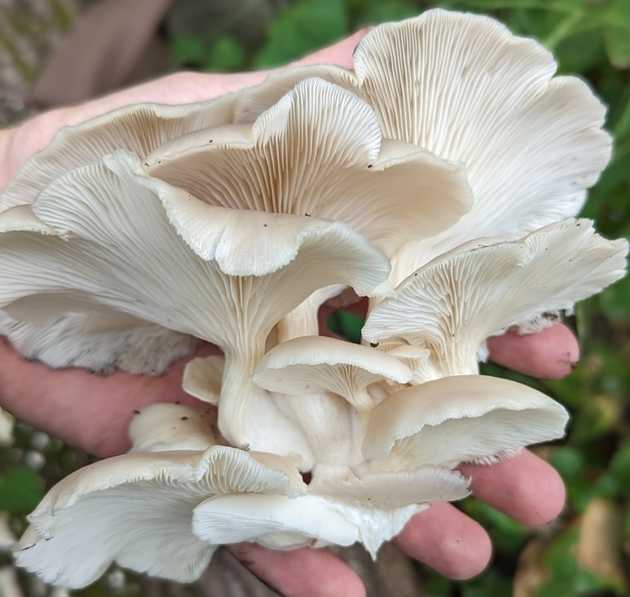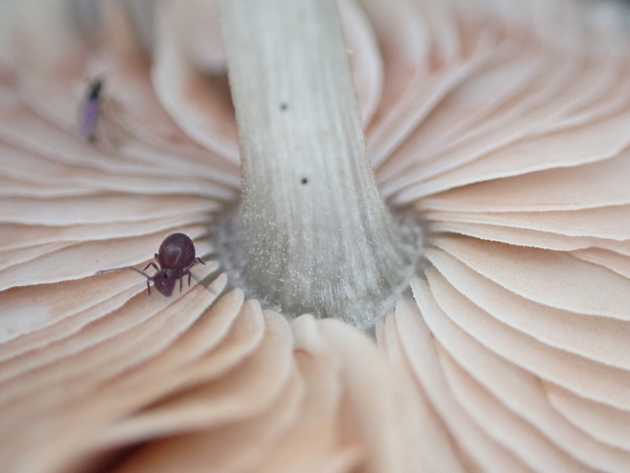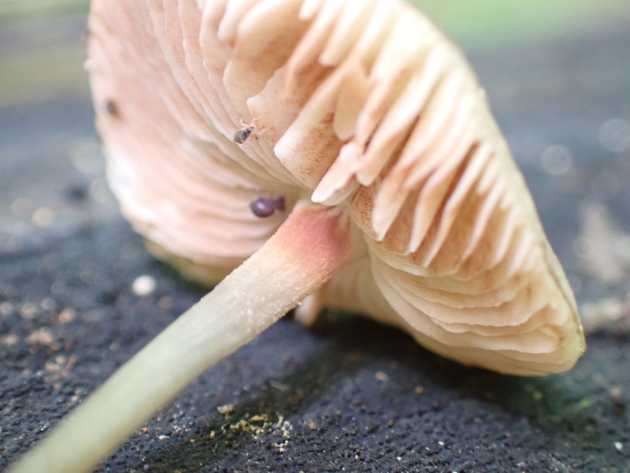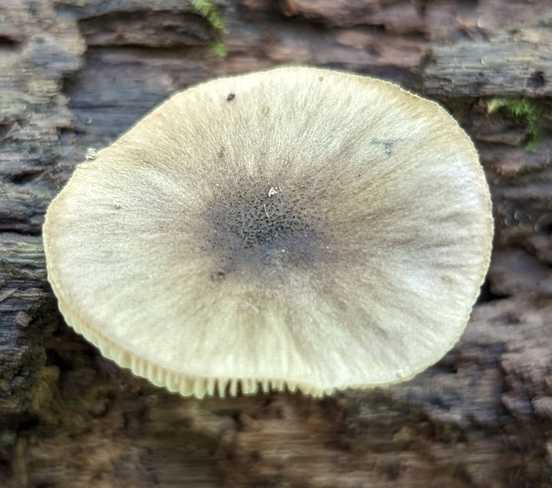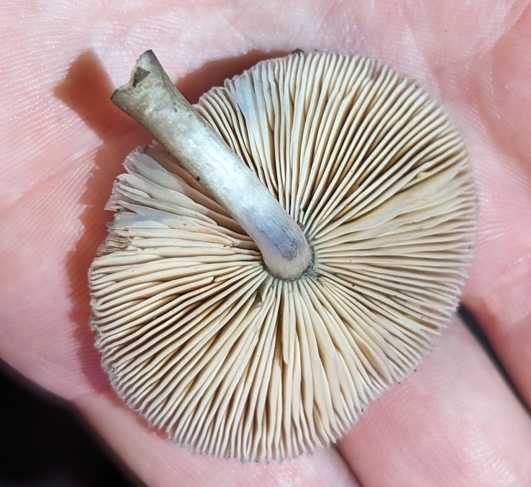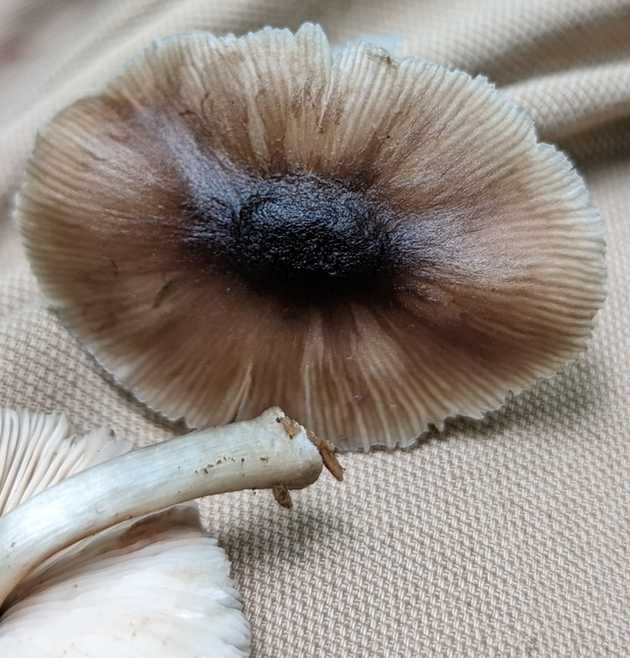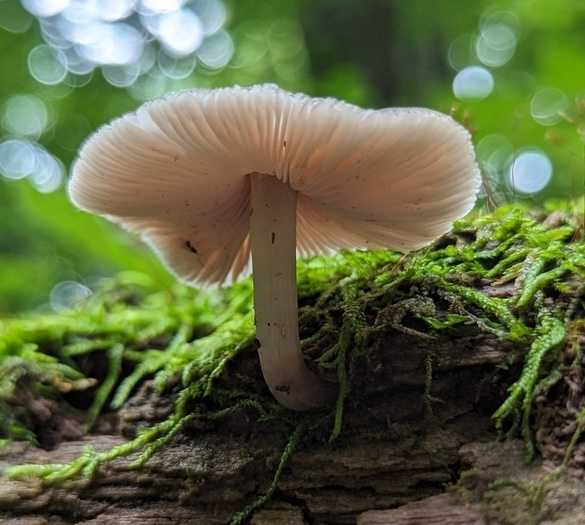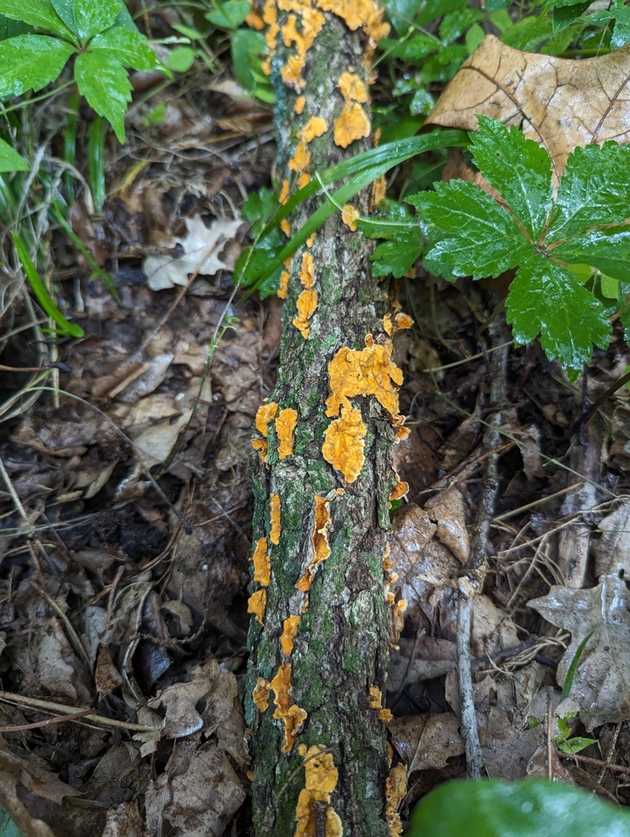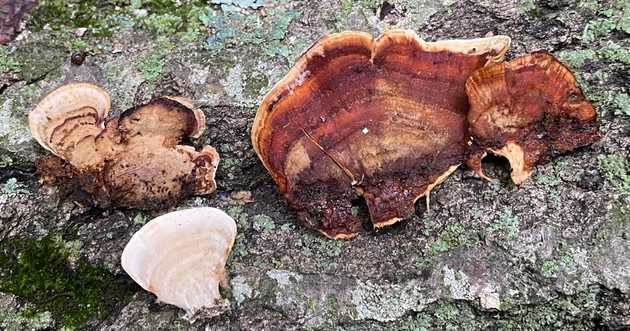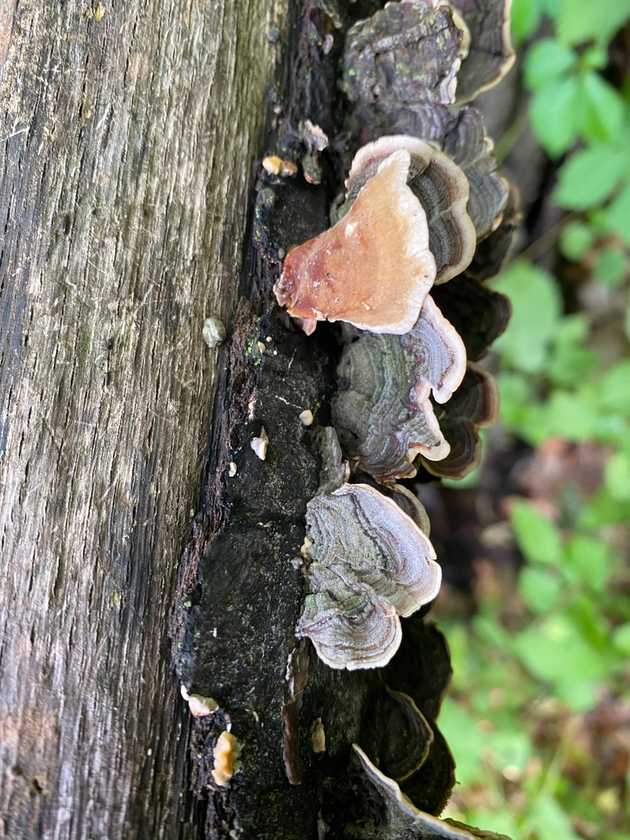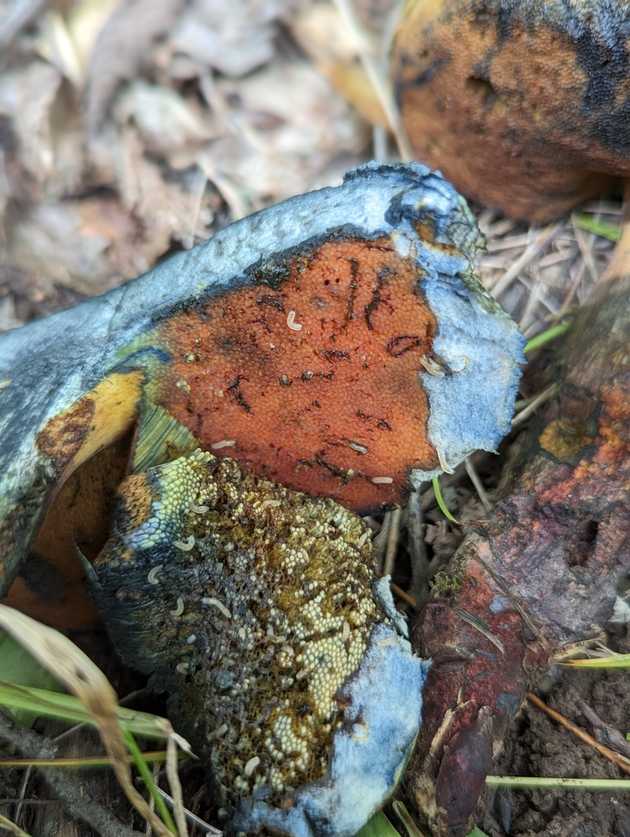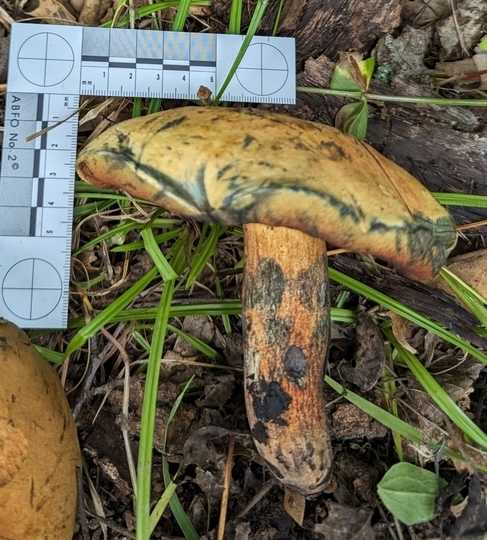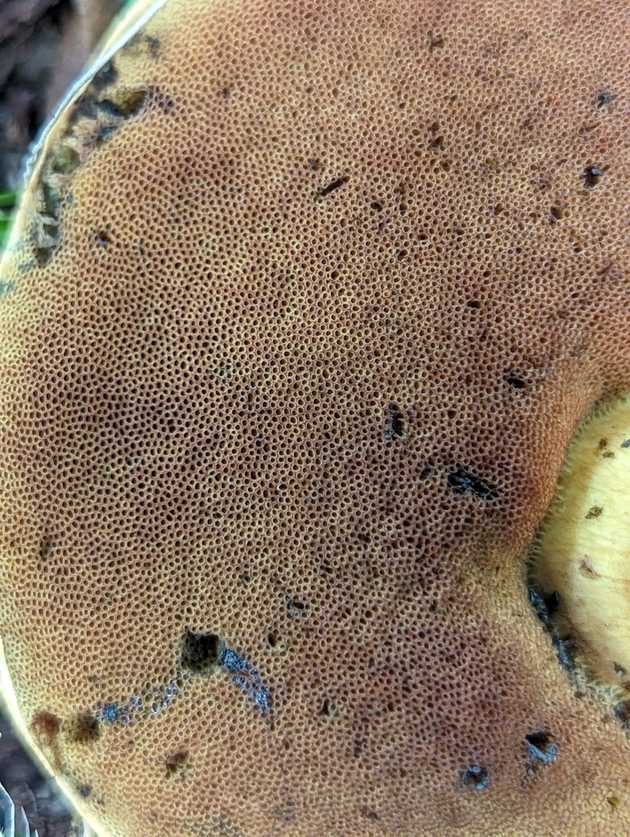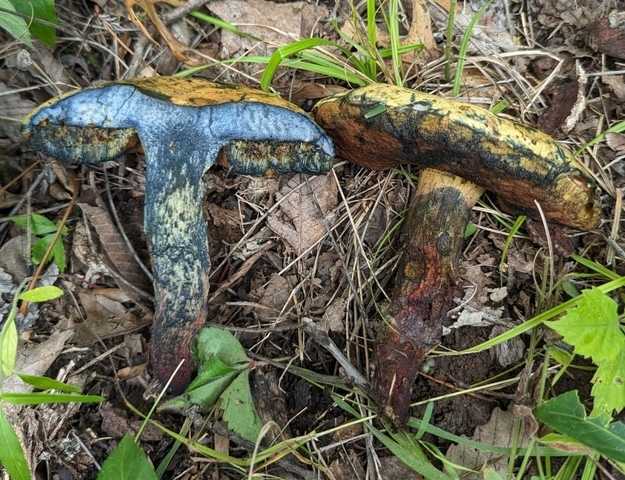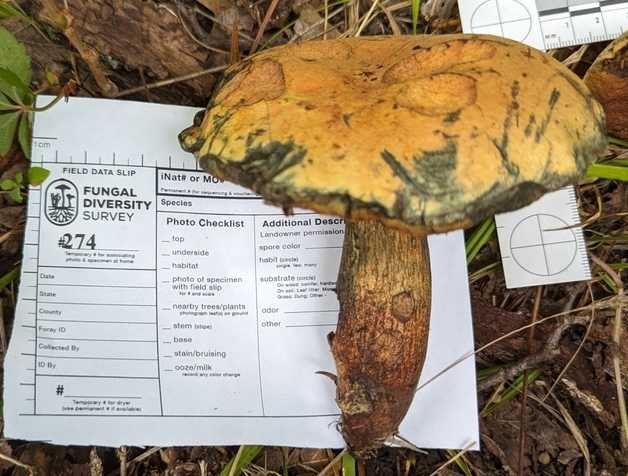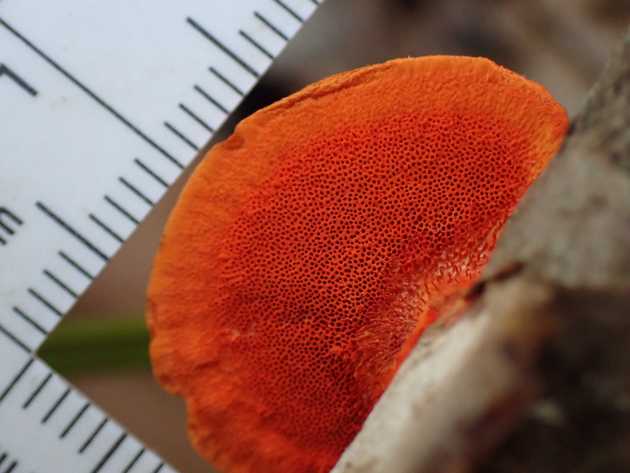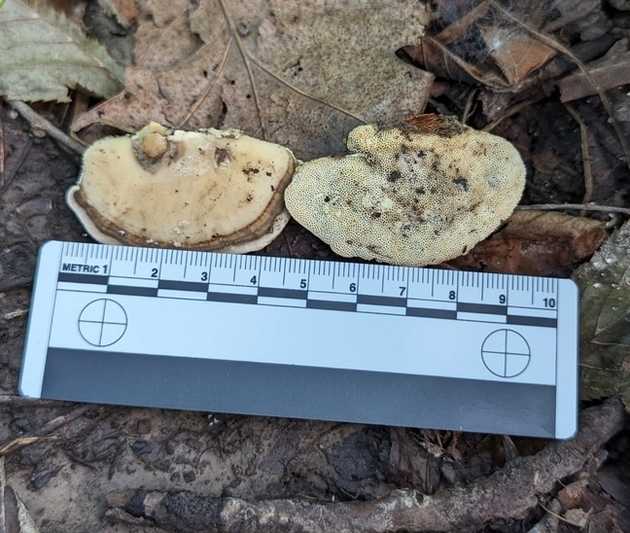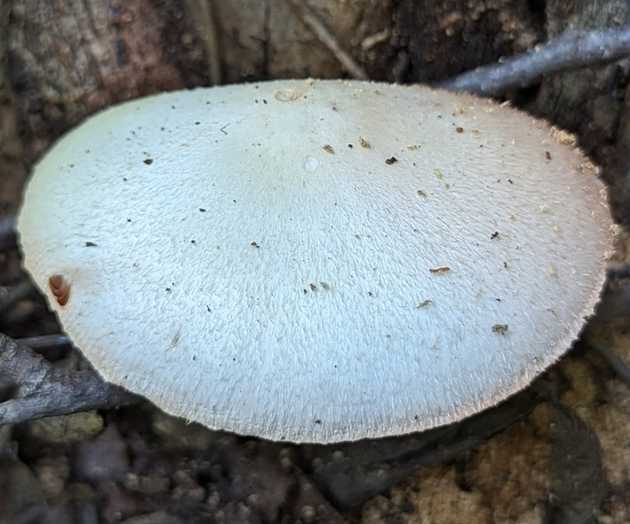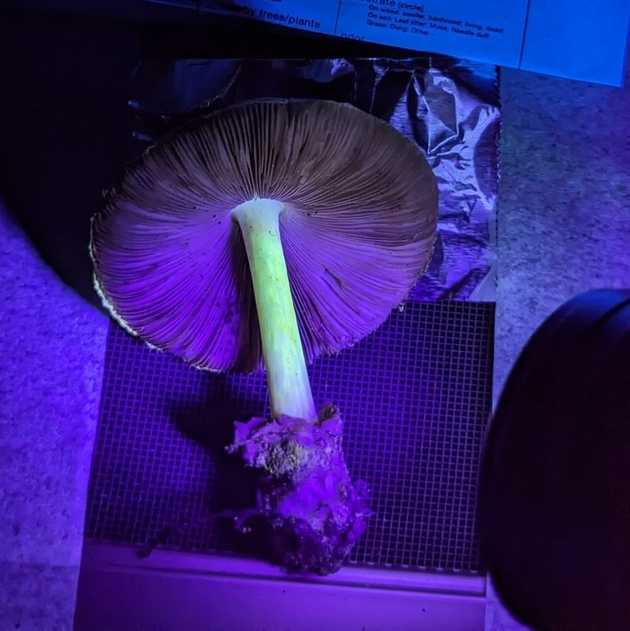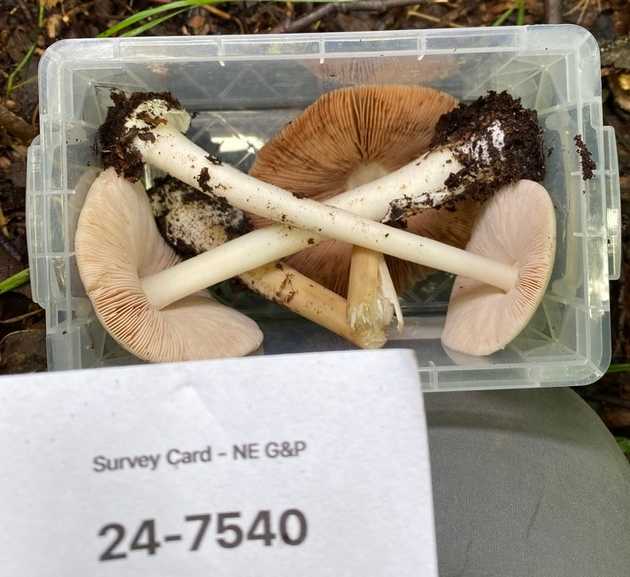Mushrooms of Nebraska
Important! Please read our disclaimer on edibility.
Guide Generator
The Nebraska Mushrooms field guide is a full collection of species observed in Nebraska and catalogued on this website. Each species includes a common name (if available), scientific name, up to three images, and a description. See the example field guide page below.
The field guide is designed to be printed or downloaded through the browser's print dialog. If you want to save the field guide as a PDF, select the "Save as PDF" destination option in the print dialog. To begin, click the print button below.
Heads up: This file is quite large and might take a moment to load, especially on slower internet connections. If you're interested in an easier download, consider downloading a past snapshot.
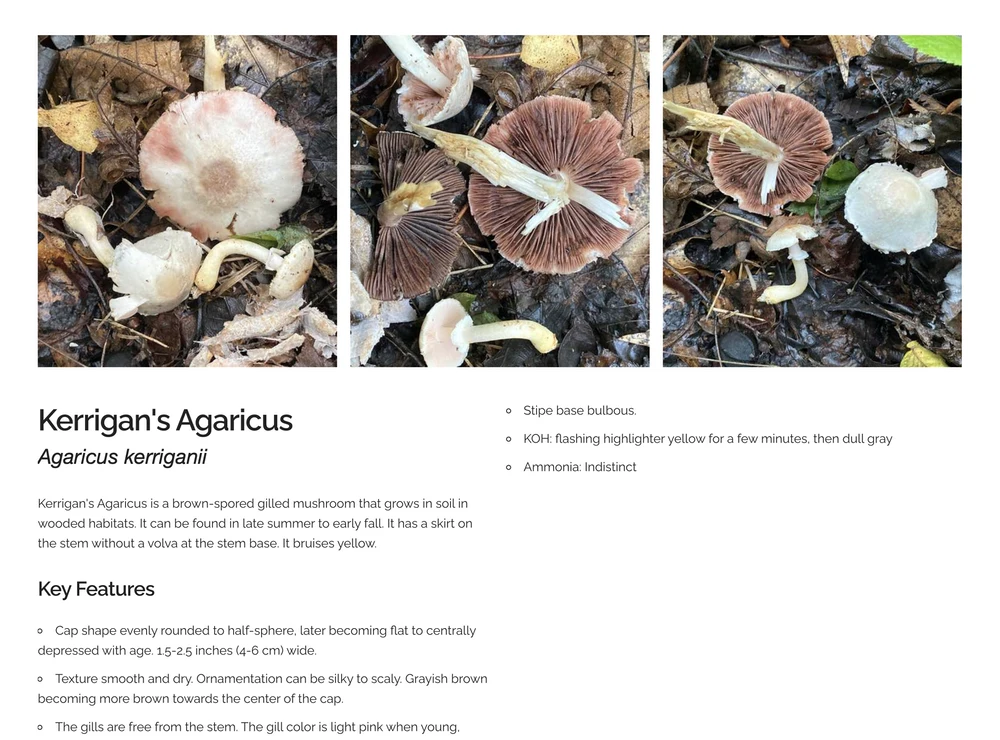
Mushrooms of Nebraska
Important: This guide is for informational use only. Do not use this guide as a singular source to determine edibility. Eat wild mushrooms at your own risk. We accept no responsibility for illness, injury, or other consequences resulting from mushroom consumption. Please do not use this PDF as a sole source for identification.
This PDF is a snapshot of NebraskaMushrooms.org generated 10/20/2025, 9:54:08 PM
Kerrigan's Champion
Agaricus kerriganii
Kerrigan's Champion (Agaricus kerriganii) is a brown-spored gilled mushroom that grows in soil in wooded habitats. It can be found from late summer to early fall in Oak and Pine forests. It has a skirt on the stem without a cup at the stem base. It bruises yellow.
Morphology
- Cap shape evenly rounded to half-sphere, later becoming flat to centrally depressed with age. 1.5-2.5 inches (4-6 cm) wide.
- Texture smooth and dry. Ornamentation can be silky to scaly. Grayish brown becoming more brown towards the center of the cap.
- The gills are free from the stem. The gill color is light pink when young, becoming darker pink, then becoming brown with age. This is due to brown spores maturing on the gill surface over time.
- Stem with a membranous skirt on the top half and a bulb on the base. Sometimes curved. 1.2-2 inches (3-5 cm) long.
- Bruising yellow where handled. Bruising red with age and decomposition.
- Spore print brown.
Slinder-Stemmed Champion
Agaricus leptocaulis
The Slinder-Stemmed Champion (Agaricus leptocaulis) is a decomposer that can be found in soil in mixed woods from late summer to early fall. It has been reported in the Midwest to the East Coast. It can be found growing alone or in small groups. The cap and stem bruise yellow where handled.
Morphology
The cap shape is evenly rounded to broadly rounded, becoming flat with age. Sometimes with a slight umbo. Sometimes splitting radially at the margin. The cap texture is smooth and dry. The color is grayish-brown with brown scales that are more densely collected at the center than the margin.
The gills are free from the stem. The gill color is light pink when young, becoming darker pink, then becoming brown with age. This is due to brown spores maturing on the gill surface over time.
The stem features an elastic pendant-shaped skirt on the top half and a small bulb on the base. Sometimes curved. 1.5-4.5 inches long (3.5-11.5 cm) × 0.3-0.5 inches wide (8-14 mm).
The odor ranges from indistinct to pleasant to phenolic (like band-aids or glue). The spore print is brown.
Wrinkled Fieldcap
Agrocybe rivulosa
The Wrinkled Fieldcap (Agrocybe rivulosa) is a brown-spored, gilled decomposer that grows in soil in woodland settings.
It has a wrinkled cap top surface that is mostly white becoming tan towards the center. The stem is relatively long, has a ring (annulus), and has an abrupt bulb at the base with white "roots" (pseudorhizomorphs). The gills are slightly attached to the stem and begin light-colored and turn more brown with maturity.
Scaber Stem Fieldcap
Agrocybe firma
The Scaber Stem Agrocybe (Agrocybe firma) is a decomposer that grows on dead hardwood logs in wooded areas and can be found summer through fall. It is mostly distributed west of the Great Plains.
It has a dark, firm cap without lines at the margin. Gills that are narrowly attached to the stem that start white-colored then turn dull brown. The stem is distinctly ornamented with scale-like tufts of white fibrils that turn brown with age. Annulus and volva are absent. It can be found fruiting in clusters or, rarely, alone.
Flat-Top Champion
Agaricus placomyces
The Flat-Top Champion (Agaricus placomyces) is a decomposer that can be found in soil from summer through fall. It can be found in mixed woods. This species of Agaricus grow quite large and mature caps can be flat (plane) with a darker-colored center. The gills start pinkish colored and turn to dark brown with age. It has a brown spore print.
Moth Urchin Fungus
Akanthomyces aculeatus
The Moth Urchin Fungus (Akanthomyces aculeatus) is a fungus that parasitizes and consumes adult moths. The mycelium creates a thick mat that encompasses the moth and sometimes adheres to adjacent surfaces. It can be found in the summer through fall in moist habitats. As the fungus grows, spear-shaped spikes protrude outward making it look like a sea urchin. The clubs produce spores in order to infect more insects. Spooky!
Smooth Patch Disease
Aleurodiscus oakesii
Oct 11, 2023 Field Characteristics:
- Growing locally abundant on American Hophornbeam tree in mixed oak/hickory woodland
- Sporocarps disc-shaped, slightly concaved, and light tan with a lighter ( almost white) margin.
- Spore Print: white
Spider Akanthomyces
Akanthomyces aranearum
The Spider Akanthomyces (Akanthomyces aranearum) is an entomopathogenic mushroom that can be found in the summer. Its preferred hosts are spiders and can be found in riparian areas.
This fungus is not found often because of its tiny size, making it not well understood. However, as North American mycology matures in the next decades we hope to understand more about this interesting organism. The name "aranearum" stands for "of the spiders". It refers to the order of true spiders, Araneae, which is the host of choice for this fungal parasite.
American Blusher
Amanita amerirubescens
The American Blusher (Amanita amerirubescens) is a mycorrhizal mushroom that can be found in Oak and Pine-dominated woods mostly during the summer but also into early fall. It is a gilled mushroom that can be found in the soil, has large membranous skirt, and has a bulbous base without a volva. It stains red and has a white spore print.
This species hasn't been described formally in North America yet, and is under the provisional name Amanita "rubescens-02".
Yellow Patches
Amanita flavoconia
This mushroom has not been formally described in North America yet and has the provisional name Amanita "flavoconia-03".
Amanita fuscozonata
Amanita fuscozonata is a mycorrhizal mushroom that can be found in the spring through summer. It is suspected to associate with a range of deciduous trees (especially Oak) and possibly conifers on occasion. It is widespread in Eastern North America. Also known as Amanita longicuneus.
The cap is colored brownish with a darker center. The cap has a lined pattern (striations) from the margin to about halfway to the center of the cap. The gills are free from the stem to narrowly attached (acutely adnexed). The stem has no ring (annulus), and has a unique sack like volva at the base.
The main distinguishing characteristic is what is called an "internal limb" (limbus internus) on its volva. From R. E. Tulloss:
"The distinguishing character of this species (within its known range) is the form of the internal limb of the volva. When the fruiting body is cut in half lengthwise, the volval sac is seen to have two limbs. The outer limb covered the entire mushroom during its early development. The inner limb (which also completely encircles the stem), was between the stem and what became the free edges of the gills during development. In this species, the shape of the cross-sectioned inner limb is that of a very long and narrow wedge." (Tulloss, 2024)
Great Felt Skirt Destroying Angel
Amanita magnivelaris
This is a deadly poisonous mushroom. Please see Deadly Mushrooms of Nebraska by C. Brueggemann where it is treated as Amanita bisporigera.
The Great Felt Skirt Destroying Angel is a mycorrhizal mushroom that grows in soil in wooded habitats in the summer. It is white, has a membranous skirt on the stem, and has a bulbous base with a volva.
Yellow American Blusher
Amanita flavorubens
White Panther
Amanita multisquamosa
The White Panther (Amanita multisquamosa) is a presumed toxic, mycorrhizal mushroom that fruits in the summer in woodland settings. These have been observed in Indian Cave State Park in eastern Nebraska in an Oak/Hickory woodland.
The fruiting body is mostly white, with a yellow or tan cap center. The cap is adorned with white, removable warts. The gill attachment is free to nearly attached (acutely adnexed), and the gill spacing is crowded. This species usually features a skirt of tissue on the stem (annulus), but sometimes the skirt falls off and/or is eaten by bugs. It has a bulbous base with a collar-like cup (volva) and sometimes transient velar tissue extending further up the stem.
Poplar-Loving Ringless Amanita
Amanita populiphila
Murrill's Slender Caesar
Amanita murrilliana
This is a mycorrhizal mushroom that grows in soil and can be found in the summer and fall east of the Rocky Mountains. It has a ring (annulus) on the upper side of the stem and a sack-like cup (volva) at the base. It can be found associating with Oak and other broadleaf trees.
Amanita sp-IN34
Amanita sp-NE01
Amanita sp-NE01 is a mycorrhizal mushroom that can be found in the summer in woodland settings. This one was found growing from a moss pad in an Oak/Hickory forest at Indian Cave State Park in eastern Nebraska.
The cap is colored light tan. The pattern on the cap are lines (striations) that go from the cap margin to 1/2 to the center of the cap. The gills are free from the stem to narrowly attached to it (acutely adnexed). The stem does not have a ring (annulus) and it has a cup at the base (volva). The volva looks like a sheath or a loose membranous sock on the base of the stem.
Garlic-Odored Death Cap
Amanita suballiacea
The Garlic-Odored Death Cap is a white to cream spore-colored mycorrhizal mushroom that associates mostly with Oak and Pine trees east of the Rocky Mountains. This species is considered deadly poisonous.
It has free, white gills. The stem has a ring (annulus) near the top and a sack-like cup (volva) at the base.
Pear-shaped Puffball
Apioperdon pyriforme
The Pear-shaped Puffball (Apioperdon pyriforme) is a decomposer of wood and can be found from the fall through the early winter. It can be recognized by its gregarious growth habit (growing in groups) and numerous mycelium ropes growing through the wood (rhizomorphs).
When young, the "pear-shaped" fruiting bodies have a white-colored interior that later turns brown with age. They split open at a single pore on the top of fruiting body from which they disperse their spores via wind, rain, and other disturbances. The spore print is brown.
White Honey Mushroom
Armillaria gallica
The White Honey Mushroom (Armillaria gallica) is a decomposer of wood and can be found in the fall. It has a widespread distribution in Eastern Nebraska from Indian Cave State Park to the Niobrara Valley Preserve (Mee-Sook & Klopfenstein, 2011). A. gallica can be found in areas of dead trees decomposing wood and buried roots and is common in wooded areas and occasional lawns (decomposing tree roots).
The cap is ornamented with distinct scaly hairs that are more abundant toward the center of the stem as the mushroom matures.
The gill color is whitish. The gills are attached to the stem and sometimes have a short bit that runs down the stem (decurrent tooth).
This species has a high degree of color variation. The specimen below has a whiter base color with darker cap scales than the one above.
Fruiting bodies grow alone or in small clusters. The stem shape has an enlarged base (bulbous). It has a ring (annulus) that is cobwebby to membranous in composition. It does not have a cup at the base (volva). The spore print is white.
October 24th, 2023 Field Notes - Indian Cave State Park
468
Observed At: Tuesday, October 24, 2023 10:31 AM Created At: Tuesday, October 24, 2023 10:31 AM Last Modified At: Tuesday, October 24, 2023 11:07 AM locations: 40.254601173049124 -95.55665001723096 Form Group: Smell: pencil eraser Form Group: agaric Substrate: Substrate: terrestrial, lignicolous Growth Habit: Growth Habit: gregarious Habitat: Habitat: ( Growth Habit: gregarious, Substrate: terrestrial, lignicolous, Associated Trees: ( Carya cordiformis ) ) Associated Trees: Associated Trees: ( Carya cordiformis ) Cap: Pileus: ( Shape: ( Top view: orbicular; Profile: convex to plane to umbo to broadly umbonate ); Surface: ( texture: squamose [1]; moisture: dry-silky; color: cinnamon to pinkish buff to buff to curry-yellow to clay-pink to peach to salmon to flesh-pink [2]; koh color: brownish red [3] ) ) Shape: Shape: ( Top view: orbicular; Profile: convex to plane to umbo to broadly umbonate ) Surface: Surface: ( texture: squamose [4]; moisture: dry-silky; color: cinnamon to pinkish buff to buff to curry-yellow to clay-pink to peach to salmon to flesh-pink [5]; koh color: brownish red [6] ) Gills: Lamellae: ( Attachment: uncinate to adnate [7] ) Stem: Stipe: ( shape: clavate to terete to compressed; surface: fibrous; flexibility: firm; interior: solid to stuffed with pith ) Annulus: Annulus: ( Shape: subperonate ) Footnotes: [1] White to brown scales [2] Curry yellow bruising at the base [3] Turning reddish brown at yellow stem base [4] White to brown scales [5] Curry yellow bruising at the base [6] Turning reddish brown at yellow stem base [7] Sinuate
Spore Print: white
Field Characteristics:
480
Observed At: Tuesday, October 24, 2023 2:50 PM Created At: Tuesday, October 24, 2023 2:49 PM Last Modified At: Tuesday, October 24, 2023 2:54 PM locations: 40.260730859128394 -95.55750996386556 Form Group: Form Group: agaric Substrate: Substrate: terrestrial Growth Habit: Growth Habit: connate Habitat: In low draw adjacent to creek in oak hickory woodland Cap: Pileus: ( Shape: ( Top view: orbicular; Profile: plane to broadly convex to convex ) ) Shape: Shape: ( Top view: orbicular; Profile: plane to broadly convex to convex ) Stem: Stipe: ( interior: stuffed with pith [1] ) Annulus: Annulus: ( Texture: membranous to fibrillose ) Footnotes: [1] Inner pith as cottony threads.
Yellow Honey Mushroom
Armillaria mellea
The Yellow Honey Mushroom (Armillaria mellea) is a decomposer and tree parasite that can be found growing in large clusters in wooded areas at the base of trees and fallen logs in the fall. It is widely distributed in the Northern Hemisphere.
This mushroom grows in large clusters at the base of trees and fallen wood. The cap shape is evenly rounded becoming flat with age. The cap is ornamented with brownish scales that are especially abundant towards the center. The scales can wear off with age.
The gill color is whitish. The gills are attached to the stem usually with a small tooth running down the stem.
The stem color starts out a golden yellowish when young generally turning whitish or brownish with age. There is a membranous ring (annulus) on the stem. The shape of the base of the stem is usually pointed due to the mushrooms growing in clusters. The spore print is white.
In addition to the mushroom, Armillaria mellea grows a network black rope-like structures of mycelium (rhizomorphs) that spread through the forest and are parasitic on trees.
September 19th, 2022 Field Notes - Indian Cave State Park
Growing at the base of dead northern red oak tree on open oak woodland ridge.
October 11, 2023 Field Characteristics:
- Primordial specimens growing at the base of hardwood tree in mixed oak/hickory woodland.
- Caps round, firm with yellow scaber-like structures on pileipellis.
- Stipes yellow and firm.
Crown-tipped Coral Fungus
Artomyces pyxidatus
May 17, 2023 Field Characteristics:
Growing on the logs of a large hardwood tree in a large moist oak/hickory woodland draw.
American Tree Ear
Auricularia americana
The American Tree Ear is a decomposer of dead broadleaf wood and can be found in the spring through fall. It is a common mushroom that is widely distributed in North America (and possibly further).
The fruiting body takes the form a jelly-like structure. The shape is "ear"-shaped, fan-shaped, cup-shaped, and variations in-between. The color is brownish to reddish-brown becoming darker colors as it dries out. The spore print is white.
A good time to search for this mushroom are after a period of consistent, heavy rains.
May 16th, 2023 Field Notes - Indian Cave State Park
Growing on fallen Shagbark Hickory limb in large oak/hickory woodland draw.
- Exidia glandulosa growing in close proximity on the same substrate.
Earpick Fungus
Auriscalpium vulgare
The Earpick Fungus (Auriscalpium vulgare) is distinctive mushroom can be found growing alone or in small groups on buried pine cones and in the spring, fall, and winter. It is widely distributed throughout North America. It is brownish-red, distinctively kidney-shaped from the top, with a stem attached to the side of the cap, and with white spines underneath. The spore print is white
June 18th, 2024 Field Notes - Niobrara Valley Preserve:
- Growing on Ponderosa pine cone on the upper slope of spring-branch canyon.
Beauveria brongniartii
Icing Sugar Fungus
Beauveria bassiana
The Icing Sugar Fungus (Beauveria bassiana) is a widespread insect pathogen that can be found year-round infecting various species of hosts. The fungi erupt out of the joints of the insect exoskeleton as a white, powdery mass full of reproductive spores. This species infects a wide range of arthropod species. It has been used as a natural insecticide to combat a wide range of insects.
In many Ascomycetes, species can have multiple life stages. A stage where they make asexual spores via mitosis (anamorphic phase) and a life stage where they make sexual spores via meiosis (teleomorphic phase). Beauveria species are an anamorph for matching Cordyceps teleomorph. Past mycological convention was to separate these two forms into different species (like Beauveria and Cordyceps), and modern convention is to group them into one species. In the future, we may see the genus Beauveria disappear in favor of their respective teleomorphic Cordyceps species.
Smoky Polypore
Bjerkandera adusta
The Smoky Polypore can be distinguished by its gray-to-black pore surface in contrast to its pale cap surface. It is widespread across the continent and can be found year-round. It grows in large, shelving clusters on wood that stack on top of each other at the same time growing as a crust (effused-reflexed). The specimens pictured here are relatively young.
October 24, 2023 Field Notes
- Effused-reflexed.
- Nonfertile surface white to buff yellow.
- Hymenophore grayish. Smell strong and pleasant. “Bringing fond memories of from the pool as a kid”-Chance “It’s not the chlorine, it’s the fresh, “watery” smell”
Hypoxylon Canker
Biscogniauxia atropunctata
Hypoxylon Canker (Biscogniauxia atropunctata) is a crust that grows on Oak and can be found year-round.
Viscid Bolbitius
Bolbitius viscosus
The Viscid Bolbitius (Bolbitius viscosus) is a small mushroom that grows on dead broadleaf trees. It can be found in spring through fall. Its cap width is generally no larger than 3/4 inch (2 cm). Cap surface colors range from gray-olive, to red, orange, and brown.
The cap surface can be slimy to tacky, so much so that it can literally stick to your hands. Its gills are attached to or pulling away from the stem. It has a cinnamon-brown spore print.
Dung-Loving Bolbitius
Bolbitius coprophilus
The Dung-Loving Bolbitius (Bolbitius coprophilus) is a widespread gilled mushroom that grows on... (you guessed it) dung! It can also be found on compost, and other nitrogen-rich organic substrates. It grows alone or in groups (singular or gregarious). Its gills are slightly attached to the stem (acutely adnexed). B. coprophilus has a brownish spore print (dull cinnamon brown).
Brown Goblet
Arrhenia epichysium
The Brown Goblet (Arrhenia epichysium) is a gilled mushroom that can be found on dead logs with moss spring through fall. It has a "belly-button" shaped cap that starts blackish or gray-brown and fades with age and is 1/2-2 inches (1.5-5 cm) wide. Its gills run down the stem (decurrent) and are light-colored. It has white spores.
Atkinson's Bolete
Boletus atkinsonii
The Atkinson's Bolete is a soft, fleshy mushroom with a separatable pore surface on the underside of its cap. The cap top surface is brownish and the flesh of the cap is white. The pore surface begins white color and later becomes yellow. It has a net-like pattern on its stem, which is indicative of the genus Boletus. It is associated with broadleaf trees east of the Rocky Mountains. Interestingly, it has a pinkish-to-purpleish reaction when ammonia is applied to the cap surface.
June 14th, 2023 Field Notes
Growing gregariously from soil on open oak/hickory woodland ridge near American Hophornbeam, Chinkapin oak, Black Oak, and ash. Ammonia flashes pinkish instantly around the area of contact. Portions of the cap (margin) and stipe slowly staining pinkish when handled. White pore surface, tan-brown cap.
August 2019 Field Notes
Found growing amongst red oak, chinkapin oak and ironwood trees.
Short and stout boletes with cream-white pore surface and prominent reticulation down the thick stem. Flesh unchanging when cut/bruised. Ammonia on the cap resulted in a spreading pink reaction.
Ash-tree Bolete
Boletinellus merulioides
Field Characteristics:
#171
-Growing gregariously from soil in open mixed oak woodland with a few Ash trees in close proximity.
-Hymenium and inner flesh instantly bruising blue, later fading back close to original color.
-Younger caps with tomentose pileipellis while older specimens matte to shiny.
-Taste: earthy, similar to dirt. Smell: not distinctive.
Berkeley's Polypore
Bondarzewia berkeleyi
Field Characteristics:
- Growing as rosette at the base of large Northern Red Oak in low mixed oak/hickory woodland slope, just above riparian area.
- Large fruiting body consisting of broad overlapping fronds, tan in the middle and whitish near the margins.
- Hymenium consisting of white irregular/angular (some maze-like) pores, becoming faint near areas of fresh growth.
- Smell: fragrant like banana or pawpaw fruit.
- Taste: not distinctive.
- Spore Print: white
Hesler's Lute
Callistosporium hesleri
Hesler's Lute (Callistosporium hesleri) is an exceptionally rare mushroom. It was first collected and described in 1983, and wasn't found again until a soil DNA study found the mycelium in a Pine plantation in South Carolina in 2014. As of August 2024, has been found a total of three times on iNaturalist, twice in Indiana and once in Nebraska.
Hesler's Lute grows on soil and decayed wood and can be found spring through late summer. It is a small, agaric with distant, notched, gray-colored gills. Not much is known about this mushroom due to its rarity.
Club-like Tuning Fork
Calocera cornea
The Club-like Tuning Fork is a decomposer that grows on wood. This specimen was found fruiting in the cracks of a chared Black Oak trunk. It is yellow to orange-colored and is tough and gelatinous (the same features are shared with many other Dacrymycetes). It can be found fruiting on Oaks and other broadleaf woods in the spring and fall.
Calocera furcata is similar, but fruits on conifer wood.
August 3rd, 2023 Field Notes
- Growing in large numbers from lateral cracks on a charred Black Oak trunk in open mixed oak woodland.
- Fruiting bodies are orange, gelatinous but fairly tough, spire-like with a fork near the tip.
- Smell: not distinctive
- Taste: not distinctive
Purple-edged Lute
Callistosporium purpureomarginatum
The Purple-edged Lute (Callistosporium purpureomarginatum) is a decomposer of fallen Oak wood and can be found widespread in eastern North America from mid-July to mid-September.
When found fresh and well hydrated, this mushroom's color is pronounced purplish red. A distinctive feature of the cap is that the cap margin maintains a dark reddish violet color as it dries out while the rest of it changes color. It starts dark red or grayish reddish brown when moist the center starts to dry out to grayish yellow and later dries to light yellowish brown.
Cap center:
Cap margin:
The gill attachment to the stem is directly connected to the intersection point (adnexed) or with a notch (emarginate) usually with a decurrent tooth running down the stem. The gills are fragile, especially toward the cap margin. The gill color is yellow or purple undertones and purple towards the cap margin. A color difference can be noticed on the gill margins (marginate) which is a more pronounced purple.
The stem is usually attached off-center to the cap (eccentric) and is usually curved. Usually the same color as the gill margins (concolorous) drying into similar colors as the cap with age.
The spore print is white. The odor is pleasant, but nondescriptive. The taste is slightly bitter with a metallic aftertaste (please spit it out after tasting). The name purpureomarginatum refers to the purple margins of the cap and gills as the mushroom dries out.
Purple-spored Puffball
Calvatia cyathiformis
The Purple-spored Puffball (Calvatia cyathiformis) is a grassland decomposer that can be found in summer through fall. It is a common mushroom widely distributed across the globe. It can be found alone, in groups, or in fairy rings.
Calvatia cyathiformis is generally pear-shaped to loaf-shaped. The exterior can be colored white to tan to brown and develops a "mud-cracked" pattern after being exposed to the sun. The interior begins white when young, transitioning to a purplish color towards the top and olive at the base when mature.
Calonarius caesiofulvus
Calonarius caesiofulvus is a mycorrhizal mushroom that forms a symbiotic association with trees in the Fagaceae (oaks, beech, etc.). This mushroom was recently described in 2024 (Liu, et al., 2024) and has so far been reported only from Gainesville, Florida, and Indian Cave State Park (ICSP) in Nebraska. It has been found fruiting at ICSP in late September, presumably associating with Oak trees. The Latin name refers to the changing colors of the fruiting bodies as they mature: caesi- meaning bluish-gray and fulv- meaning reddish-yellow or tawny (Borror, 1988).
Cap: hemisphereical when young becoming broadly convex to nearly flat with age. The surface texture is innately fibrillose (covered with fine, adhering fibers), viscid (slimy or tacky), and pale grayish purple when young, turning brown with a yellow margin as it matures. The flesh (context) is white to yellow.
Gills: crowded and yellow.
Stem: dry, with a cortina (a cobweb-like partial veil) that leaves a brown annular zone from spore deposits. The base is marginate (featuring a bulb with an angular ridge marking the attachment of the universal veil) and often bears remnants of a bluish-purple universal veil. The flesh is yellow, especially towards the base.
Basal mycelium: white to yellow.
Odor and taste: not distinctive.
Pale Brittlestem
Candolleomyces candolleanus
The Pale Brittlestem (Candolleomyces candolleanus) is a decomposer that can be found in the spring through fall. It can be found in lawns, mulch, and forests where it decomposes dead trees and their root systems. It is widely distributed and common.
The cap is brittle and is colored yellowish to tan when young, generally becoming lighter and whiter with age. The shape is evenly rounded becoming broadly conical with age, almost like a large umbrella. The gills are slightly attached (adnexed) and are white when young becoming grayish-pink then brownish-black with age. The stem is hollow and brittle. The spores are brownish-black.
Giant Puffball
Calvatia gigantea
Pale Yellow Brittlestem
Candolleomyces luteopallidus
Candolleomyces luteopallidus is a decomposer that can be found from late spring through fall in eastern Nebraska. It grows on rich soil, humus, or decaying wood, often in disturbed areas such as trailsides or forest edges. The species name luteopallidus refers to its pale yellow coloring — luteo meaning “yellow” and pallidus meaning “pale”.
The cap is pale yellow to cream-colored when fresh, often becoming lighter or slightly faded with age. It starts out bell-shaped and becomes broadly evenly rounded or nearly flat as it matures. The gills are slightly attached to the stem (adnexed), gray to cream when young turning dark brown to nearly black with age. The stem is thin, white, fragile, and with an annular zone at the top. The spore print is brown.
Prismatic Wavy Cup
Chlorencoelia torta
The Prismatic Wavy Cup (Chlorencoelia torta) is a decomposer of wood that can be found from July to mid-October growing on a wide variety of tree species. Generally found on well-decayed, barkless logs in central to north-eastern North America. The featured specimen was found on presumed American Linden.
The Prismatic Wavy Cup features a wide variety of unusual color transitions, from blue, to yellow, to olive-green, brown, and even orange. It can be found growing solidarity, in groups, and sometimes multiple cups growing from the same stem (caespitose). Fruiting bodies grow as a cup when young, later transitioning into a flattened disc with a wavy margin. This feature is how it gets its species name torta, meaning twisted or contorted (Dixon, 1975).
Chicago Chanterelle
Cantharellus chicagoensis
The Chicago Chanterelle (Cantharellus chicagoensis) is a mycorrhizal mushroom that can be found in Oak-dominated forests (though possibly associating with other broadleaf trees). It can be found across north central North America from July - September. This mushroom was once grouped into a different species called the Golden Chanterelle (Cantharellus cibarius) until DNA testing distinguished it to be a separate species (Leacock, et al., 2016).
The cap, fertile surface (hymenium), and stem are all yellow, though often greenish-yellow hues can be present when immature. This mushroom is not composed of true gills. Instead, the spore producing surface is constructed by wavy, forking ridges that run down the stem (decurrent). These ridges aren't easily separable from the mushroom which would be more typical of true "gills".
The Chicago Chanterelle grows from the soil and associates with Oak and other hardwoods. The featured specimen was found growing amidst a population of Chinkapin Oak, Elm, Northern Red Oak, Black Walnut, and Bur Oak. The smell and taste are faint to unnoticeable.
July 6th, 2023 Field Notes - Indian Cave State Park:
Growing gregariously (some fused) in mixed oak/hickory woodland.
Associated trees: Chinkapin oak, Elm, Northern Red Oak, Black Walnut, and Bur Oak.
- Smell: faintly floral
- Taste: not distinctive.
DNA Barcode ITS: GAACGCAAACGGCACCCTTCCAGTCCATTCCAAAGCGGTGGCGGAGGATGAAGACAAGGGTATCTCTGGCTGAGGGTAATGTAAACTGATCCGGTCGTACCACTGGTTGACTGGGGATTGGGCTCGCTTGGAGCGATATCGCTCTGGCTTGCCTTAAAATCAAGCGTTGTGTGGATTGGACTTTCAAGCGTGCATTGGGGACGCAGGCTCTGCGCTATATGGCAAGCCCTTGACCGTCATAGGTGCTTTGATTGGGGTCTTCAGTCTAGCCAACAAGGCTGGGTTGGACTTTGGGGCTGCATTGGGGGCGTAGGGCAGCTCTGTTCGTGGCGTCCGATGACCGTCATGGTGCATGATTGGACTTCAACTAGCAATTATTATCATTATCATTACTATGGGTTTACCTCAGGTCAGAGAAGACTACCCGCTGGACTTAA
Mossy Maze Polypore
Cerrena unicolor
Field Characteristics:
482
Nickname: Cerena unicolor
Sequence Number: #0482
Observed At: Thursday, October 26, 2023 10:11 AM
Location: 40.26033670408027, -95.56689605061773
Form Group: Polypore [1]
Habitat:
- Growth Habit: Single
- Substrate: Lignicolous
- Tree: [2]
Attachment: Sessile
Pileus:
- Surface:
- Texture: Hirsute
[1] Smell pleasant
[2] Growing from the base of Elm
Common Coral Slime
Ceratiomyxa fruticulosa
Dryad's Saddle
Cerioporus squamosus
Key features include:
- Flattened scales (squamules) on the cap surface. A feature from which the mushroom gets its name C. squamosus.
- Large, honeycomb-like pores under the cap that extend down the stem. The pore surface is not separatable from the cap.
- The distinctive smell of watermelon rind.
- White spore print.
This is a large and common mushroom in Nebraska. It's most noticable by its scales on the cap surface and the smell of watermelon rind. The cap color is pale tan to creamy yellowish with brown to black scales. When old, the cap color turns whitish with reddish to blackish scales sometimes with a dark brown to black patch in the center of the cap and black velvet extending from the base of the stem upwards. The cap shape is variable, but mostly semicircular to kidney-shaped to fan-shaped. The stem is generally tough and cork-like, especially with age. This species can get particularly large, generally a cap of 5-30 cm wide and 1-4 cm thick and stem 1-4 cm thick and 2-8 cm long.
Habitat
Dryad's Saddle can be found fruiting from decaying logs, stumps, and living trees on a wide variety of broadleaf trees (especially Silver Maple and Boxelder) in woodland settings, urban locations, and roadsides. It's known to be both saprobic and parasitic.
Abundance
Dryad's Saddle is the most commonly sighted mushroom in Nebraska, according to iNaturalist. It is generally found growing alone or in small groups.
Fruiting Period
This mushroom can be found fruiting from spring through fall. However, it prefers cooler weather and is most abundant in the spring and fall. This is a common mushroom to find while morel hunting. Although the mushroom is not perennial, its older forms can be found in the winter, slowly decomposing, making it discoverable year-round.
Similar Species
- Cerioporus varius is a close relative that is smaller in size.
Edibility
This is a good edible mushroom when collected young in its small button stage. It's easy to determine edible parts, as they will be soft, pliable, and break apart by hand. With age, the mushroom becomes leathery and undesirable. Older specimens can be collected for the table by cutting the softer edges on the cap margin with a knife. All wild mushrooms should be cooked thoroughly before eating. Please see our disclaimer before eating any wild mushrooms.
Toxicity
This mushroom is not known to be toxic. However, allergies and sensitivities may affect individuals differently. Please use caution when eating any wild mushrooms.
Ceriporiopsis sp-IN01
Ceriporiopsis sp-IN01 is a polypore originally found on decayed hardwood in southern Indiana. Species of Ceriporiopsis are characterized by resupinate, soft fruiting bodies with pale, round to angular pores and are known for decomposing dead wood and causing white rot.
Clavulina sp-IN01
This white, coral-like fungus was found in the summer at Indian Cave State Park in eastern Nebraska and was originally documented in southern Indiana. It is mycorrhizal and grows on the ground, forming upright, branched structures similar to antlers or coral. It closely resembles Clavulina cristata or Clavulina coralloides (Kuo, 2007). This is a provisional species name, used temporarily while it awaits formal description and a long-term placement.
Ergots
Claviceps sp.
Claviceps species grow on grass seeds in the summer and fall. It can be found after times of heavy rain during grass seed development. The visible black part is a sclerotium which is fungal growth that serves as energy reserves for the fungus. Like a "fungal potato".
Claviceps is highly poisonous. The resulting poisoning syndrome is known as ergotism and has also been named "St. Anthony's Fire" and "Devil's Curse".
"Convulsions, muscle spasms, vomiting, hallucinations, and a gangrenous pain where the victim’s limbs, fingers, toes, and nose were “eaten up by the holy fire that blackened like charcoal” characterize ergot poisoning. Victims often lost parts of their extremities or entire limbs due to blood vessel constriction associated with gangrenous ergotism." (U.S. Forest Service)
If you or someone you know has been poisoned by consuming wild fungi, call 9-1-1 and get the individual medical attention IMMEDIATELY. Afterwards, please report poisonings to the North American Mycological Association to contribute to our understanding of wild mushroom safety.
Green-spored Parasol
Chlorophyllum molybdites
The Green-spored Parasol (Chlorophyllum molybdites) is a widespread mushroom that can be found in lawns and fields from summer through fall. It sometimes fruits in fairy rings. This is a poisonous mushroom that is commonly misidentified as an edible species of Macrolepiota.
The Green-spored Parasol is the main source of poisoning in Nebraska. Although generally not deadly, it can cause severe gastrointestinal upset along with an uncomfortable hospital visit.
The main separating features of this species are free gills and an olive-green spore print. The gills will be greenish at maturity.
If you or someone you know has been poisoned by consuming wild mushrooms, call 9-1-1 and get the individual medical attention IMMEDIATELY. Afterwards, please report poisonings to the North American Mycological Association to contribute to our understanding of wild mushroom safety.
Blewit
Collybia nuda
Clavulina sp-IN06
Observed in the summer at Indian Cave State Park in eastern Nebraska, this small, white fungus had a coral/club-like form with minimal branching compared to other Clavulina species in the area. It was growing on the ground in a mixed hardwood forest, appearing to be mycorrhizal. The shape and stature were reminiscent of Clavulina rugosa. This collection is currently being referred to under the provisional name Clavulina “sp-IN06” while it awaits formal study and description.
Clavulina sp-IN05
Observed in the summer at Indian Cave State Park in eastern Nebraska, this small, white, coral-like fungus was growing gregariously among moss on the forest floor. Its branching form was compact but distinct, with multiple fruiting bodies locally abundant. It appeared to be mycorrhizal, associating with nearby hardwoods. This collection was originally documented in southern Indiana and is currently being referred to under the provisional name Clavulina “sp-IN05” while it awaits formal study and description.
Handsome Club
Clavulinopsis laeticolor-NE01
Clavulinopsis laeticolor-NE01 was found in Indian Cave State Park in late September on mossy soil in an Oak/Hickory woodland. It occurred in scattered but locally abundant clusters along a shaded trail.
Fruiting bodies are slender, unbranched, and vivid yellow to orange, usually under 2 inches (5 cm) tall, and smooth to the touch. They grow scattered or in small groups on soil or moss in woods, often among grasses or mosses, and may fade with age. The base is usually whitish, and the flesh is soft and pale. The spore print is white.
Fool's Funnel
Collybia 'rivulosa PNW07'
Fool's Funnel (Collybia 'rivulosa PNW07', also known as Clitocybe rivulosa) is a decomposer that can be found in the late summer through fall and seems to have a global distribution. Its habit is to grow in arcs and rings in grasslands. It is relatively common and is a toxic look-alike of the Fairy Ring Mushroom (Marasmius oreades). The latter being an edible mushroom inhabiting the same habitat and growth habit (Wood, 2015).
This mushroom contains a toxin called muscarine. Please review the list of symptoms below.
The symptoms usually occur within 15-30 minutes of ingestion, and are focused on the involuntary nervous system. They include excessive salivation, sweating, tears, lactation (in pregnant women), plus severe vomiting and diarrhea. These symptoms may be accompanied by visual disturbances, irregular pulse, decreased blood pressure, and difficulty breathing. Victims normally recover within 24 hours, but severe cases may result in death due to respiratory failure. Atropine is a specific antidote, but must be administered by a physician. Dogs are particularly susceptible to the toxin muscarine. (Beug, 2024)
If you or someone you know has been poisoned by consuming wild mushrooms, call 9-1-1 and get the individual medical attention IMMEDIATELY. Afterwards, please report poisonings to the North American Mycological Association to contribute to our understanding of wild mushroom safety.
August 9th, 2023 Field Notes - Indian Cave State Park:
Growing gregariously to clustered in a hemispherical fairy ring (only fruiting 1/4 of ring) in an open grassy area bordering an oak/hickory woodland. The mycelium ring is estimated to be 7 feet in diameter. Local trees: Ash, American Hop Hornbeam
- Growing 1-2 cm tall; 1.5-3 cm cap diameter.
- Gills: decurrent; cream-colored; partial gills present.
- Cap: convex to flattening, both with central depression. Cream to tan colored. Margin inrolled and undulating.
- Stipe: flexible; brushing lightly where handled; darkening at base;longitudinal striations; pink notes at base.
- Smell: indistinct to faintly fruity
- Taste: faint and slightly acrid.
- KOH: pileipellis: darkens surface
- Ammonia: pileipellis: indistinct.
- Not exuding latex.
- Spore Print: white
Fool's Funnel
Collybia rivulosa
The Fool's Funnel (Collybia 'rivulosa PNW07', also known as Clitocybe rivulosa) is a decomposer that can be found in the late summer through fall and seems to have a global distribution. Its habit is to grow in arcs and rings in grasslands. It is relatively common and is a toxic look-alike of the Fairy Ring Mushroom (Marasmius oreades). The latter being an edible mushroom inhabiting the same habitat and growth habit (Wood, 2015).
This mushroom contains a toxin called muscarine. Please review the list of symptoms below.
The symptoms usually occur within 15-30 minutes of ingestion, and are focused on the involuntary nervous system. They include excessive salivation, sweating, tears, lactation (in pregnant women), plus severe vomiting and diarrhea. These symptoms may be accompanied by visual disturbances, irregular pulse, decreased blood pressure, and difficulty breathing. Victims normally recover within 24 hours, but severe cases may result in death due to respiratory failure. Atropine is a specific antidote, but must be administered by a physician. Dogs are particularly susceptible to the toxin muscarine. (Beug, 2024)
If you or someone you know has been poisoned by consuming wild mushrooms, call 9-1-1 and get the individual medical attention IMMEDIATELY. Afterwards, please report poisonings to the North American Mycological Association to contribute to our understanding of wild mushroom safety.
Coltricia sp-IN01
Coltricia species can be found in forested soil along woodland trails during the summer. The species collected for this study is an undescribed North American species going under the cryptic name Coltricia sp-IN01. It has a circular shape in outline (from the top down) and is navel-shaped, sunken in the center, or somewhat funnel shaped. The flesh is quite thin and flexible. The pore-shaped to tooth-shaped reproductive surface on the bottom of the cap provide a unique distinguishing feature along with its central stem and terrestrial habit.
Stay tuned for more details once it gets described.
August 15th, 2023 Field Notes - Indian Cave State Park:
Growing gregariously from soil in open mixed oak/hickory woodland.
Nearby Trees: American Hophornbeam, Northern Red Oak, Bitternut Hickory, Bur Oak, Shagbark Hickory, and Black Walnut.
- Caps orange, fibrous, iridescent with concentric light bands, with a slight central depression and a fringed margin.
- Hymenium consisting of dark brown, irregular-shaped pores and a darker sterile margin.
- Stipe dark brown, subtomentose and tapering to a slightly bulbus base.
Additional Info
- Smell: not distinctive
- Taste: not distinctive
- KOH instantly black on all surfaces but stipe which turned a darker shade of brown.
August 16th, 2023 Field Notes - Indian Cave State Park:
Growing gregariously on soil in open (but well shaded) mixed oak/hickory woodland. North-facing slope.
- Pileipellis: iridescent, hirsute at center, enrolled margin which is violet
- Hyminum: irregular pores with diff growing through; bruising dark red
- Stipe: subtomentose.
- Smell: strong
Collybiopsis biformis
Collybiopsis biformis is small a decomposer that can be found growing on leaf/forest duff and dead wood east of the Rocky Mountains from summer through fall.
June 29th, 2023 Field Notes
- Growing solo on Northern Red Oak acorn shell in low mixed oak/hickory woodland.
- Compare to Gymnopus. Clitocyboid. Gills close and decurrent. Line margin. Hairy mycelium at the base of the stipe shortening in length to absent at the cap intersection. Depressed cap. Cap surface smooth with radial streaking. Growing from Northern red oak acorn shell.
- Smell: faint.
- Taste: slightly bitter.
- KOH: olive on pileipellis.
Milky Conecap
Conocybe apala
The Milky Conecap (Conocybe apala) is a decomposer that is common in lawns during the summer and fall months but can also be found in dung, compost, and woodchips. Widespread and common.
Conocybe can be distinguished by a cone-shaped cap, brown spores, and shallow gills. Although this species isn't known to be poisonous, other species in the genus can be deadly, so it's best to consider this species poisonous as well.
Coprinopsis pseudonivea
Coprinopsis pseudonivea is a small mushroom that grows on cow dung or compost, most often during the summer through fall. It appears alone or in small groups and belongs to the group of the inkcaps, which dissolve into black ink as they mature. The name pseudonivea means “false snow-white,” referring to its resemblance to Coprinopsis nivea, a similar species. It is known for its variable and often strong smell, described by different collectors as yeast-like, coconut, cinnamon, or fruity.
The cap starts out narrow and oval, then expands to about 1.5 inches (4 cm) wide. It is coated in a white to gray powdery layer and often splits around the edges as it opens. The gills are not attached to the stem and change from white to black with age. The stem is long and slender, white to grayish in color, sometimes slightly swollen at the base, and covered with soft white flakes. The spore print is dark purple-black.
Trooping Crumble Cap
Coprinellus disseminatus
The Trooping Crumble Cap (Coprinellus disseminatus) is a distinctive Ink Cap mushroom that can be found in soil or on decomposing wood. It is widespread and can be found in spring, summer, and fall. This mushroom is small, is quite fragile, does not transform into black ink (unlike most other Ink Caps), and is usually found in large groups (trooping).
The cap is pleated/grooved from the margin almost to the center. The gills start white when young, becoming gray-brown, then becoming black with maturity. The spore print is black. Attachments range from free, attached, or pulling away from the stem.
Common Ink Cap
Coprinopsis atramentaria
Coprinopsis atramentaria, commonly known as the Common Ink Cap or Tippler’s Bane, is a saprobic mushroom that grows in clusters or dense groups on buried wood, lawns, gardens, or disturbed soil—often in urban areas. It appears from spring through fall and is widely distributed across temperate regions. The species name atramentaria comes from the Latin atramentum, meaning “black ink,” referring to the dark liquid produced when the cap deliquesces with age (Kuo, 2004).
This mushroom contains the compound coprine, which causes a toxic reaction when alcohol is consumed within several days of ingestion. Symptoms include flushing, nausea, and rapid heartbeat (Beug, 2024).
The cap is gray to gray-brown, initially oval or bell-shaped, and reaches 1–4 inches (3–10 cm) wide. As it matures, the cap flattens, becomes grooved, and eventually dissolves into black ink. The surface may be slightly scaly near the center. Gills are free from the stem, crowded, and change from white to black as they liquefy. The stem is smooth, white to grayish, and hollow. The spore print is black.
Scaly Ink Cap
Coprinopsis variegata
The Scaly Ink Cap (Coprinopsis variegata) is a decomposer that can be found in the spring and fall (occasionally in the summer). It is widely distributed and common in North America and can fruit in substantial numbers. It grows on wood and can appear like it is growing from the soil, though it is actually originating roots underground. It is widespread and common.
The mushroom originates from an egg-shaped button stage. As it grows, it splits the veil open leaving bits of split tissue on the cap surface and remnants of the veil on the stem near the base. The gill color starts whitish, becoming black at maturity.
This mushroom will digest itself through a phenomenon called deliquescence or "the process of turning into a liquid". The inky mess is loaded with spores. Flies and other insects are attracted to it and get covered in the ink, which later disperse the spores by traveling to other areas. This is an amazing example of how mushrooms hack the behaviors of other organisms to complete their lifecycles and spread to new territories.
Hesler's Webcap
Cortinarius hesleri
Slinder-Footed Cordyceps
Cordyceps tenuipes
The Slinder-Footed Cordyceps (Cordyceps tenuipes) is an entomopathogenic mushroom that grows on cocooned month and butterfly pupae in the order Lepidoptera. The fruiting bodies grow in damp, shady wooded areas in the summer. It can be found eastern North America and can also be found in Mexico, China, and Australia.
The host is sometimes rolled up in a leaf on the forest floor to pupate. The fungus infects the pupa, consumes its body, then grows spore-producing structures (stroma) with white powdery tips out of the leaf "burrito". These fruiting bodies offer a noticeable neon-yellow white color contrast amidst the dark leaf duff for keen-eyed mushroom hunters.
Cortinarius sp-NE01
Cortinarius sp-NE01 is a cryptic name for a not yet described Webcap species documented from Indian Cave State Park in eastern Nebraska. It was found growing on the ground in mid to late fall, likely forming mycorrhizal associations with oaks or other nearby trees.
Cotylidia diaphana
Field Characteristics:
- Growing gregariously on woodland floor in open mixed oak/hickory woodland edge.
- Flesh thin and fairly tough.
- Smell: not distinctive.
- Taste: mildly bitter.
Tiffany's Webcap
Cortinarius tiffanyae
Cortinarius tiffanyae is a mycorrhizal mushroom that appears in mid to late summer (July–August) in hardwood forests of northeastern North America. It grows on the ground in association with trees like oak (Quercus), beech (Fagus), maple (Acer), basswood (Tilia), and elm (Ulmus) (Healy et al., 2020). This species was named in honor of Dr. Lois H. Tiffany, a pioneering mycologist from Iowa State University.
The cap starts out conical or rounded and flattens with age, often developing a small bump in the center. Its surface is dry, silky, and shiny when fresh, usually showing fine radial cracks as it matures. Colors range from dark reddish-brown to paler reddish-yellow as the cap dries. The gills are widely spaced and shift from pale purplish to reddish-brown, often with lighter edges. The stem can show a gradient of color—lavender near the top fading to cream, and ending in a yellow-orange to reddish base. A reddish-brown spore print and an unpleasant or fruity odor help set this species apart from others in the woods.
Saffron Oysterling
Crepidotus crocophyllus
The Saffron Oysterling (Crepidotus crocophyllus) is a wood-decaying fungus (saprotroph) that grows on dead wood. It fruits from spring through fall and is widely distributed across tropical, subtropical, and temperate regions. The fruiting bodies usually grow in clusters or scattered along fallen logs, often resembling small seashells.
The scientific name crocophyllus comes from the Greek krokos (‘saffron, orange-colored’) Latinized to croc-, combined with -phyllon (‘leaf’); literally meaning “saffron leaf.” In mycology, the suffix -phyllus refers to gills, highlighting the saffron-yellow gills of young specimens (Donald J. Borror, 1988).
When young, this mushroom is strikingly bright in color. The cap surface is woolly, covered with brown or wine-colored fibrils (tiny hair-like fibers), and the margin (edge of the cap) is rolled inward. The gills start out saffron-yellow with somewhat jagged edges. As the mushroom matures, the cap surface becomes smoother and dull brown, though it often retains a bit of woolly texture near the center. The cap margin straightens with age, and the gills fade to white, tan, or brownish tones.
This species lacks a true stem, produces a brown spore print, and is considered hygrophanous (it changes color based on its hydration level). It has no distinct odor, but the taste is reported as bitter.
A simple chemical test with potassium hydroxide (KOH) can help with identification. On young caps, KOH turns the surface red, while on older caps it produces gray to black reactions. Applied to the gills, KOH creates a vivid red color.
This species is not considered edible.
Discrete Birds Nest Fungus
Crucibulum parvulum
This bizarre decomposer is composed of a nest-like structure containing disc-like eggs, which are small spore sacks. This fungus has an interesting method of spore dispersal. The nest is structured so that it may catch falling raindrops which splash the eggs to other locations to seed future mycelium.
Crucibulum parvulum can be found growing on twigs, woodchips, and roots east of the Rocky Mountains from summer through fall.
The Discrete Birds Nest is considered a smaller version of the Common Birds Nest (Crucibulum laeve). The former is described with a nest 1.5-3mm wide and the latter 4-10mm wide. Interestingly enough, this specimen seems to be bigger than described, but the DNA results matched Crucibulum parvulum... It seems that DNA testing might be necessary to accurately separate the two species.
Fan-shaped Jelly Fungus
Dacrymyces spathularia
Field Characteristics:
#218
-Growing in troops (locally abundant) on charred portion of fallen oak tree in open mixed oak/hickory woodland.
Smell: Not distinctive Taste: Bitter
Cortinarius subpulchrifolius
Cortinarius subpulchrifolius is a mycorrhizal mushroom found growing on the ground among fallen leaves in hardwood and mixed forests. It appears in September and October, often in small clusters or scattered groups. The name subpulchrifolius means “somewhat beautiful-gilled,” referencing its dull purple gills, which are a distinctive feature that persists longer than in many similar species. It resembles Cortinarius pulchrifolius but can be separated by differences in spore size and cap color (Kauffman, 1918).
The cap is 1.5–4 inches (4–10 cm) wide and starts out rounded before flattening with age, sometimes with a slight bump in the center. It is dry and silky-looking, grayish-buff when young, and may become yellow-brown or rusty as it matures. The edge of the cap may show patches of a white veil in young specimens. The gills start dull purple and gradually turn cinnamon-brown with age. The stem is thick, 2–4 inches (5–10 cm) long, pale with a whitish to dingy veil that may leave a faint ring or patchy zone. A white cortina (web-like veil) may be visible in younger mushrooms. The spore print is rusty brown.
Dirty Bolete
Cyanoboletus cyaneitinctus
The Dirty Bolete (Cyanoboletus cyaneitinctus) is a mycorrhizal mushroom that can be found growing in woodland soil and lawns adjacent to Oaks and other symbiotic trees in Eastern North America. It can be found in the summer and fall growing singularly or (rarely) in small groups.
The cap shape is cushion-shaped to evenly rounded. The cap color is different hues of brown or maroon. The cap texture is finely powdery when young, turning smooth with age. When wet, it can be slightly tacky, with leaves or other debris commonly adhering to the surface as it dries. It bruises blue quickly and readily when handled.
The fertile surface under the cap is composed of yellow, circular to angular pores that also bruise blue where handled.
The stem is yellow commonly transitioning to a reddish color towards the base.
The inner flesh (context) of the mushroom is generally a similar color to the stem, which readily bruise blue when cut.
Though considered to be edible in the past, it has been determined to be a bio-accumultor of arsenic from the soil (Pavelle, 2015), which makes its edibility iffy.
July 26th, 2023 Field Notes - Indian Cave State Park:
Growing scattered in low East-facing mixed oak/hickory woodland.
- Cap brownish-tan with some maroon hues and velvety, bruising darker.
- Pore surface dingy yellow with irregular shaped pores that quickly turn dark blue when bruised.
- Stipe yellow at apex, quickly turning reddish brown clear to the base, also bruising dark blue.
- Basal mycelium white.
- Interior flesh yellowish, quickly turning dark blue where cut.
Additional Info
- Taste: acidic to mild
- Smell: not distinctive to reminiscent of Portabellas.
- KOH: orangish on pileipellis, dark buff-orange on pore surface.
- Ammonia darkening on pileipellis, pore surface, and stipe.
DNA ITS Barcode: GAACGCACCTTGCGCTCCTCGGTATTCCGAGGAGCATGCCTGTTTGAGTGTCATCGAATTCTCAACCATGCCCCTTTGTCAAAAGGACATGGCTTGGACTTTGGGAGCCTTGCTGGCCTTTTTGGTCAGCTCTCCTGAAATGCATTAGCGATGGGTGGGCAAGTCTTCATTAGAGACGTGCACGGCCTTCGACGTGATAATGATCGTCGTGGCTGGAGCGTCTTTATTCTTGCGATCCGTCCTCGCTCACAATCTCTGCTAGCCTTGGGTTAGCTTTTGGCTATTAGTTCGGTCACGAGACCTGACGAACGTCAGAGGTGCACCCCCAAGGACTGGTCGATTTCGAAACTTGACCTCAAATCAGGTAGGATTACCCGCTGAACTTAA
Dacryopinax elegans
Field Characteristics:
489
Nickname: Dacrypinax elegans
Sequence Number: #0489
Observed At: Thursday, October 26, 2023 1:48 PM
Location: 40.245803401857664, -95.53598855134709
Form Group: Dacrymycetales
Habitat:
- Growth Habit: Gregarious
- Substrate: Lignicolous
- Tree: Desciduous
Spores:
- Print color: [1]
[1] Light yellow
Thin-Walled Maze Polypore
Daedaleopsis confragosa
The Thin-Walled Maze Polypore is a decomposer of dead wood that can be found year-round, though mostly fruiting in the warm months. Widely distributed. It grows on deciduous wood and rarely coniferous wood. It grows on Oak less often than Daedalea quercina, which generally has thicker "maze" walls.
The cap surface color can be tan to brown to white. The cap pattern presents different zones of color in a "ripple" effect from the center outward (concentrically zoned). The pore surface has a great deal of morphological variation which can present pores, gill-like elongated pores, or (most commonly) maze-like structures. When fresh, it bruises salmon-pink to brownish where handled. KOH darkens surface colors, and ammonia changes surface colors pinkish, at least in fresh samples.
July 27th, 2023 Field Notes - Indian Cave State Park
September 28th, 2023 Field Notes - Indian Cave State Park
habitat: Lignicolous (on wood)
growth habit: Gregarious (growing as a group)
Cap: shape: flabelliform (fan-shaped) [1]; texture: zonate to velvety, velutinous (short, soft) to pubescent (finely fuzzy) to smooth to uneven (bumpy); surface moisture texture: dry - dull; margin shape: straight; margin: undulating (wavy) to entire, even, regular
Gills: thickness: tapering; spacing: crowded to close; edges: eroded (gnawed) to crisped (crinkled); misc features: arid (dry)
Stem: locations: eccentric (off-center) to sessile (missing)
[1] KOH dark gray Ammonia red
Growing on oak
Densocarpa shanorii
Densocarpa shanorii is a mycorrhizal truffle that can be found in Oak/Hickory forests in the fall.
Daldinia childiae
Daldinia childiae is a decomposer of wood and is common in Nebraska. The fruiting times are spring through fall, though the tough fruiting bodies will overwinter and can be found year-round. Though mostly found on broadleaf trees it is sometimes found on conifers.
The fruiting body is mostly ball-shaped with an outer surface that is black or brown. When broke in half, the contents feature charcoal-like concentric zones of black and gray. When these contents are mixed with dilute KOH the resulting color is brownish which distinguishes it from the European Daldinia concentrica which produces purple with the same test.
Cortinarius squalidus
Cortinarius squalidus is a mycorrhizal mushroom found in oak-hickory forests, appearing in scattered groups on the ground. It was observed in mid to late September at Indian Cave State Park in eastern Nebraska. The species name squalidus is from the Latin word squalere means “dirty” or filthy,” referring to its overall dull brown appearance. This species lacks bright or vivid colors, giving it a rather plain look compared to many other Cortinarius mushrooms (Smith, 1944).
The cap is 1–3 inches (3–8 cm) wide, convex when young and flattening with age. It is pale cinnamon to dull brown, sometimes with streaks or watery spots, and sticky when moist. The margin may have remnants of a white veil. Gills are pale brown when young and darken with age, closely spaced, and attached to the stem. The stem is 1–2 inches (3–5 cm) long and up to 0.6 inches (1.5 cm) thick, pale and silky with a slightly swollen base. A white cortina (web-like veil) may be present between the cap and stem in young specimens. The spore print is rusty brown.
Dung-Loving Deconica
Deconica coprophila
Deconica coprophila is a decomposer of dung that can be found in the summer. Mostly found on horse or livestock dung in Nebraska, it is a small mushroom that generally grows in large groups. It has what is known as a gelatinous pellicule, which means the top layer of the cap is jelly-like and stretchy. So much that can stretch beyond the point that the rest of the cap will break. It's almost like a "second skin" covering over the top of the cap. This feature is known to the genera Deconica and Psilocybe.
This mushroom was once included in the genus Psilocybe and was moved to its own genus due to the absence of the mind-altering substance Psilocybin and genetic differences.
The cap is brown and shiny when wet (due to the gelatinous pellicule) drying to a tanish color. Velar tissue can commonly be found on the cap margin. The stem is 'scurfy' featuring small groups (or tufts) of fibrils (hairs). The gills are horizontally attached to the stem (adnate). The spore print is blackish.
Dentocorticium portoricense
Dentocorticium portoricense is a wood-decay fungus found at Indian Cave State Park in eastern Nebraska, where it was observed growing on dead American Elm (Ulmus americana) and American Linden (Tilia americana). The species was originally described from Puerto Rico—its name portoricense referring to that origin—and has since been documented across the Americas, including the United States, Mexico, Central America, and Brazil (Ryvarden, 1982).
The fungus forms a flat, crust-like patch on wood, sometimes with edges that curl up into small shelf-like brackets. The upper surface is dark brown and finely hairy, sometimes showing faint zones. The pore surface is pale greenish white when fresh, later turning brown. Pores are shallow and angular, often breaking into maze-like or short tooth-like shapes as the fungus ages (Ryvarden, 1982). A white, powdery coating may be visible when young. Spores are smooth, transparent, and cylindrical, and the spore print is likely white (Liu et al., 2018).
Ringless Honey Mushroom
Desarmillaria caespitosa
The Ringless Honey Mushroom (Desarmillaria caespitosa) is a decomposer and tree parasite that can be found growing in large clusters from buried tree roots in late summer and fall. It may appear to be growing from the soil, but it is actually decomposing roots in the soil. It mostly grows from Oak (Quercus sp.) and Silver Maple (Acer saccharinum) and is distributed east of the Rocky Mountains in North America.
The cap color is a range of "honey"-like colors. The cap shape is evenly rounded, becoming flat, then pothole-shaped (depressed) or with a small bump (umbo) with age. The cap surface is ornamented with hair-like scales that are more abundant towards the center and rub off with age.
The gill color is whitish bruising pinkish. The gill attachment is running down the stem (decurrent) or attached with a small bit running down the stem (decurrent tooth). The stem shape is tapered at the base due to the clustering habit. The spore print is white.
September 11th, 2023 Field Notes - Indian Cave State Park
Growing tightly clustered at the base of dead American Hophornbeam tree on West-facing mixed oak/hickory woodland slope.
- Cap honey colored with dark orangish brown hairs towards the center, hygrophanous, and margins wavy and striated.
- Lamellae light tan, wavy, decurrent, with frequent partial gills.
- Stipe similar color to gills, fibrulose, slightly darkening where handled.
Additional Info
- Smell: not distinctive
- Taste: not distinctive
- KOH orangish on pileipellis.
White Jelly Fungus
Ductifera pululahuana
Field Characteristics:
39
Growing on fallen barkless hardwood log in moist oak/hickory woodland.
Black Witches' Butter
Exidia glandulosa
Exidia glandulosa appears in spring and fall on dead branches of broadleaf trees. It grows in scattered patches or loose clusters. The species name means "glandular," a reference to the jelly-like, lobed appearance of its fruiting bodies.
Fruiting bodies are black, shiny, and irregularly lobed. They are soft and gelatinous when fresh but shrink and harden as they dry, featuring fused brain-like patches. No stem is present. The spore print is white.
Donkia pulcherrima
Donkia pulcherrima appears in summer and early fall on decaying logs of broadleaf trees, often in shaded, moist forests. It grows in small clusters or alone. The species name means "most beautiful," a reference to its striking appearance. The genus Donkia was named in honor of mycologist Marinus Anton Donk.
Fruiting bodies are semicircular to fan-shaped, with caps that are dull yellow to orangish yellow, often fading to whitish or tan with age. The cap surface features a woolly texture. The underside bears densely packed spines. Flesh is tough and corky, becoming spongy when wet. There is typically no stem, or only a short lateral stub. The spore print is white.
Velvet Foot
Flammulina velutipes
Field Characteristics:
491
Nickname: Flammulina nigrapes
Sequence Number: #0491
Observed At: Thursday, October 26, 2023 2:34 PM
Location: 40.245976872668614, -95.53594591526966
Form Group: Agaric
Habitat:
- Growth Habit: Connate to Single to Gregarious
- Substrate: Lignicolous
- Tree: Desciduous
Spores:
- Print color: white
Beefsteak Fungus
Fistulina americana
The Beefsteak Fungus (Fistulina americana) is a wood-decaying mushroom that grows on oak and can be found in oak woodlands during summer and fall. In Nebraska it is considered uncommon, with surveys documenting it at the Niobrara Valley Preserve in the north-central part of the state. This species was once grouped under Fistulina hepatica, but genetic research (Zhou et al., 2022) clarified that F. hepatica is limited to Europe, while North American specimens represent a distinct species.
The cap is striking, colored pinkish to deep liver-red and usually shaped like a fan or tongue, which explains its common names “Beefsteak” and “Ox Tongue.” Young specimens may be rounded or lumpy before the cap grows. The cap often attaches laterally to the side of a short stem, giving it a flattened appearance. When cut or squeezed, the flesh exudes a blood-red juice. The pore surface is whitish to pinkish and made up of separate, tube-like structures—a hallmark of this genus and a feature that sets it apart from “true” polypores. Despite its pores, Fistulina is more closely related to gilled mushrooms (agarics) than to most other polypores.
Fomitopsis malicola
Fomitopsis malicola appears in spring and fall on dead wood of broadleaf trees; these collections were from shaded Oak–Hickory forests. It grows in shelves to gregarious clusters, reported on fallen branches including Chinqupin Oak (Quercus muehlenbergii) and Shagbark Hickory (Carya ovata).
Fruiting bodies are sessile and shelf-like to partially crust-like, with caps ranging from dull red-brown to yellow-tan or dull orange. Cap surfaces are smooth to bumpy and may show concentric zonation, with a hairy or uneven zone near the point of attachment. Pores on the underside are round to irregular, sometimes honeycomb-like, and range from white to cream or pale yellow. The fertile surface is hydrophobic. KOH applied to the cap produces a wine red reaction that later turns black; on the hymenium it produces a gray color. Ammonia applied to the cap first turns it orange-red, then dull dark red with a lighter margin; on the hymenium it produces a gray reaction. The spore print is white to pale yellow.
Fomitopsis meliae
Fomitopsis meliae appears from spring through fall on fallen hardwood, especially Ash (Fraxinus spp.), where it grows scattered along barkless portions of downed trunks. These observations were made near the edge of an open Oak–Hickory woodland. The species name meliae refers to ash trees, drawing from an old Latin name for the genus Fraxinus.
Caps are firm and damp, dingy white, and bruise dark gray when scratched. The pore surface is similarly colored, with tiny round pores that bruise gray and may elongate as the fruit body thickens. The flesh has a tough, leathery consistency when fresh, drying to a tough, corky texture. Odor is fragrant or fruity, and the taste is slightly bitter.
American Amber Jelly Fungus
Exidia crenata
The American Amber Jelly Fungus (Exidia crenata) is a decomposer of dead wood and can be found in the spring and fall. It is widespread east of the Rocky Mountains in North America.
The color is dark maroon to black. The consistency is elastic and jelly-like. It has a habit of growing in clusters. The spore print is white.
October 26th, 2023 Field Notes - Indian Cave State Parks
Spore Print: white
Cracked Cap Polypore
Fulvifomes robiniae
The Cracked Cap Polypore (Fulvifomes robiniae) is a parasite and decomposer of Black Locust (Robinia pseudoacacia). It is a tough perennial polypore that can be found year-round.
As the name suggests, the cap features cracked fissures. The cap color light brown when young and later transitions to black with age. The old fruiting bodies can get quite large. It's not uncommon to find specimens that are greater than a foot in diameter. The cap is sometimes covered with algae or moss. The cap is connected to its substrate without a stem (sessile).
The underside hymenophore presents a lighter brownish color, displaying a "sparkly" iridescence. It consists of tiny pores that might not be visible without a hand-lens.
Ethnomycology
The Cracked Cap Polypore can act almost as a "fire battery" or a way to store an ember overnight. Once the fruiting body has been ignited, it can keep an ember going for hours or days. From which future fires can be lit.
Green Cheese Polypore
Fomitopsis spraguei
The Green Cheese Polypore (Fomitopsis spraguei) is a decomposer and parasite of wood and can be found from spring through fall. It is commonly found on the base of broadleaf tree trunks growing in groups or alone. It bruises green when handled. Furthermore, it commonly exudes droplets of "mycosweat" or guttation which is a liquid secreted by the fungus that include digestive enzymes and antimicrobial compounds.
Ganoderma lobatum
Ganoderma lobatum is a sessile polypore found on buried roots, stumps, or compacted soil, often near woodland edges or along trails, appearing from late spring through fall. Fruiting bodies may collect debris as they develop, becoming partially embedded with soil and leaf litter.
The cap displays concentric zones of black, dark brown, and lighter brown, with a white growing edge. The surface is typically dull or slightly velvety. The pore surface is white and lumpy, bruising gray where damaged. The strong, sweet odor and bitter taste are notable. Chemical reactions include yellow staining on the hymenium with both KOH and ammonia.
Mustard Yellow Polypore
Fuscoporia gilva
The Mustard Yellow Polypore (Fuscoporia gilva) is a common decomposer of broadleaf wood that can be found year-round, but shows its most vivid colors during wet periods in the summer when it is actively growing. It is widely distributed in North America.
The cap surface color is reddish to yellow-mustard when young, becoming darker, then black with age. The fertile structure (hymenopore) color is similar or darker. The hymenopore consists of tiny pores.
This mushroom is easy to distinguish using drops KOH (black) and ammonia (darkening).
The inner flesh (context) is a yellow-mustard color and can be sometimes observed even when the mushroom is old and has turned black with age.
September 7th, 2023 Field Notes - Indian Cave State Park
Shelving gregariously on fallen Ash tree in open interface between riparian and mixed oak/hickory woodland areas.
- Caps thin with concentric zonation, brown with an orange-brown margin.
- Hymenophore finely poroid, primarily brown and orange-brown near margin.
Additional Info
- KOH blackish on all surfaces.
- Ammonia dark on all surfaces.
Ganoderma sessile
Field Characteristics:
#462
-Growing in overlapping shelves on the trunk of dead American Sycamore tree in open horse pasture.
- Caps red, semicircular, lacquered, wrinkled with radial zonation.
- Hymenium brownish with tiny circular/round pores.
- Stipe absent.
Additional Details
- KOH black on non lacquered areas.
- Spore deposits on cap brown.
Bicoloured Bracket
Gloeoporus dichrous
Field Characteristics:
#459
-Growing in shelves and resupinately on hardwood branch in mixed oak/hickory woodland.
- Caps round, flat and white.
- Hymenium whitish sterile surfaces and with brown round pores.
- Stipe absent
Additional Details
- Spore Print: white
Golden Reishi
Ganoderma curtisii
Ganoderma curtisii is a wood-inhabiting polypore found on hardwoods across the eastern and southeastern United States. The name honors Moses Ashley Curtis, a 19th-century American mycologist. Fruiting occurs from late spring through fall, and this collection was found growing alone at the base of a large Black Oak (Quercus velutina) along a horse trail in an upland Oak–Hickory woodland. The species is saprotrophic and can sometimes be confused with Ganoderma lucidum, though its range and morphological details differ.
The cap is red with hints of yellow near where it connects to the stem, has a slightly shiny surface, and is usually coated in brown spores. The underside is made up of tiny white pores that bruise brown when scratched. The stem is mostly wine red with patches of yellow and lighter red, shinier than the cap, and grows a few inches into the ground, where it’s wrapped in tan-colored mycelium. Inside, the flesh shows three layers: a corky, buff-colored center; a lighter brown zone just beneath the pores; and a darker brown spore tube layer. When chemicals are applied, the surface and inner flesh darken—especially with KOH or ammonia—and under UV light, the stem glows greenish yellow and the pore surface glows pink.
Collared Earthstar
Geastrum triplex
The Collared Earthstar (Geastrum triplex) is a decomposer that can be found growing alone or in groups under broadleaf trees in the summer and fall. It is widely distributed in North America and can be found in forest, urban, or suburban settings.
This mushroom produces spores enclosed within an egg-shaped case (sequestrate) fruiting body. It creates a star shape from an outer casing that splits radially and curls backwards to elevate the inner "egg" off the ground. This species creates a distinct "beak" at the top (apex) made of tiny threads that create a one-way passage for spore dispersal. The spores are brownish.
This mushroom utilizes disturbances in nature like rain drops as force to eject spores into wind currents to inoculate other areas. It is a fascinating example of nature using passive systems as a part of its lifecycle and function in the ecosystem.
September 1st, 2023 Field Notes - Indian Cave State Park
Growing gregariously from soil next to hardwood pile in low riparian woodland area.
- Smell: faint to not distinct.
- Taste: bitter
- Brown spores
Hen Of The Woods
Grifola frondosa
Field Characteristics:
#413
-Growing at the base of large Northern Red Oak tree in mixed oak/hickory woodland just above creek.
- Cap consisting of an irregular rosette pattern of overlapping brownish-gray fronds, all fused at base. The colors are more pronounced on along the margins of each frond.
- Hymenium white consisting of a network of small irregular shaped pores.
- Stipe absent
Additional Details -Spore Print: white
Beard Stem Gymnopus
Gymnopus barbipes
Gymnopus barbipes is a gilled mushroom that can be found in the summer and fall decomposing deciduous duff and leaf litter.
The stem is distinctively flattnened, hollow, and the basal mycelium binds to its substrate with white rhizomorphs. This mushroom gets its name from the felty white mycelium at the base of the stem (not shown).
The gills are white and shallow. They are attached to the stem or pulling away from it from drying.
The entire fruiting body is elastic and tough, which is distinctive of other Gymnopus as well.
July 7th, 2023 Field Notes - Indian Cave State Park
- Growing solitarily on woodland duff in low riparian woodland area near creek.
- Flat stipe with a red-tan color. Cap surface centrally brown turning white towards margin. Gills close.
- Smell: foul rubber smell.
- Taste: reminiscent of garlic. Long-lasting.
- KOH: slightly olive-gray on pileipellis; Slightly darkening on gills; indistinct on stipe.
- Microscopy: Dextrinoid in Melzer's Reagent.
August 16th, 2023 Field Notes - Indian Cave State Park
- Growing gregariously on Eastern Red Cedar and oak leaf litter on the edge of thin mixed oak woodland.
- Caps with soft pileipellis (mildy subtomentose).
- Gills marginate (white edges with light tan faces), frequent partial gills, not attached to stipe.
- Stipe tan with a white fuzz that matts down when handled, and hollow.
- Basal mycelium white, clinging to nearby duff.
- Smell: foul, like smelly rubber boots.
- Taste: also foul, enough to make breath smell.
Oak-Loving Gymnopus
Gymnopus dryophilus
The Oak-Loving Gymnopus can be found fruiting on sticks, twigs, and woodland duff and has a worldwide range. It can be found in spring, summer, and fall and is extremely common in wooded habitats.
Gymnopus dryophilus has a chestnut colored cap that is evenly rounded to flat. The gills are white, shallow, crowded, and are attached to the stem. It has a white spore print. The stem base is generally wider than the apex.
June 29th, 2023 Field Notes - Indian Cave State Park
- Growing scattered on oak woodland duff in small mixed oak/hickory woodland draw.
- Gills very shallow. Stipe somewhat elastic.
- KOH: slightly darkening pileipellis
- Taste: not distinctive.
Zoned Gymnopus
Gymnopus earleae-OH01
The Zoned Gymnopus is a widely distributed gilled mushroom that can be found in the springtime in soil and well decomposed wood.
It's closely related to the Oak-Loving Gymnopus, and can be separated by a few field characteristics:
- Its growth habit on soil or wood rather than leaf litter.
- Yellow gills rather than white.
- Occasonal color zonation on the cap (as compared to solid chestnut color in the Oak-Loving Gymnopus).
- Reddish rhyzomorphs rather than white.
July 12th, 2023 Field Notes - Indian Cave State Park
- Growing gregariously in moss in open mixed oak woodland edge.
- Nearby Trees: American Hophornbeam, Black Oak, Northern Red Oak, Chinkapin Oak and distant Black Cherry.
- Cap hygrophanous with slight rosecomb mutation on the center and light margin.
- Gills pale orange, short gills frequent, and notched with a decurrent tooth on stipe.
- Smell: rubbery
- KOH: darkening all surfaces.
Hairy-Stalked Gymnopus
Gymnopus spongiosus
The Hairy-Stalked Gymnopus is a decomposer of woodland duff that can be found from late summer through fall. It can be found east of the Rocky Mountains in woodland areas. As is true with many other species of Gymnopus, this species has an elastic consistency throughout, has shallow gills with occasional cross veins (see below), and grows on woodland duff.
The main distinctive characteristic of G. spongiosus is the dense reddish-brown hairs on the stem from the base extending to the apex.
August 18th, 2023 Field Notes - Indian Cave State Park
- Growing individually on well-decayed hardwood log in deep, wet mixed oak/hickory woodland draw.
- Gills adnexed to free.
- Stipe very hirsute near base.
- Smell: reminiscent of chocolate.
September 12th, 2023 Field Notes - Indian Cave State Park
- Growing scattered on woodland duff in mixed oak woodland edge.
- Caps light brown with a darker center.
- Lamellae adnexed, light tan, forking or with crossveins.
- Stipe colored similarly to lamellae at apex, transitioning to a reddish brown base covered in light brown wooly mycelium.
Red Gyroporus
Gyroporus purpurinus
Gyroporus purpurinus is a mycorrhizal bolete that appears in summer and fall in woodland settings, often growing singularly, scattered, or gregariously amidst broadleaf trees. It occurs on ridges and in shaded draws in oak–hickory forests, sometimes in shrubby undergrowth. Associated trees include Chinkapin Oak (Quercus muehlenbergii), Black Oak (Quercus velutina), Bur Oak (Quercus macrocarpa), Northern Red Oak (Quercus rubra), American Hophornbeam (Ostrya virginiana), and occasionally Black Walnut (Juglans nigra). The species name purpurinus refers to the purplish-red coloration of the cap.
The cap is deep red to wine-colored, sometimes with violet tones, fading toward a pale margin. Its surface is finely fuzzy when young and may develop cracks with age. The stem is hollow with a white central pith and white basal mycelium, showing red tones that split to reveal yellow beneath. The pore surface is white to cream, becoming yellow with age; pores are round and do not bruise distinctly, or if so, slightly brown. The flesh is white, sometimes browning faintly in age. Odor is mild; taste may be slightly bitter. The spore print is yellowish.
Chestnut Bolete
Gyroporus castaneus-IN07
The Chestnut Bolete (Gyroporus castaneus) is a mycorrhizal (and reportably saprobic) bolete that can be found in woodland soil and disturbed areas. Although boletes generally associate with a mycorrhizal host tree, this mushrooms has reportably been found in areas without a visible mycorrhizal symbiont. Otherwise, it has been associated with Oaks, other broadleaf trees, and conifers. It can be found growing alone or in small groups in July, August, and September in eastern North America.
2024 DNA results identified the survey specimen as Gyroporus "castaneus-IN07" suggesting it to be a genetically divergent species to Gyroporus castaneus in the strict sense. This cryptic name is a placeholder until it can be published formally.
The cap shape is evenly rounded, becoming flat with age. The flesh consistency is hard and brittle. It often splits at the margin at maturity. The cap texture is smooth to slightly velvety. The cap color features chestnut brown, yellowish brown, cinnamon brown to brownish orange.
The pore shape is circular to slightly angular. It is colored white to cream and doesn't bruise when handled:
The stem is brittle and becomes cottony hollow with age. It is colored similarly to the cap (concolorous), though sometimes paler.
Generally regarded as edible (Pavelle, 2025).
Tender Nesting Polypore
Hapalopilus rutilans
The Tender Nesting Polypore (Hapalopilus rutilans) is a decomposer of wood which is common on fallen Hickory (Carya sp.). It can be found from the spring through the fall. The cap is colored orangish to brownish and does not have a stem (sessile). There are angular pores underneath the cap. A distinctive feature of this mushroom is the vivid purple color that is displayed when a drop of KOH or Ammonia is applied on the surface (both are strong chemical bases that change the pigmentation).
Also known as Hapalopilus nidulans.
Ethnomycology
Due to this mushroom's vibrant colors in combination with chemicals, it is a common source of pigment for dying natural fibers (yarn, thread, etc.) making it a valuable mushroom for mycocrafting. (Bloom & Dye, 2024)
Sunray Sawtooth
Heliocybe sulcata
The Sunray Sawtooth (Heliocybe sulcata) is a widely distributed decomposer of wood (especially quaking aspen) that can be found from April to September.
The cap is distinctively pleated, with reddish scales in the center that form ridges on the top of the pleats toward the margin.
The gills are white, serrated, and are attached to the stem or pulling away from it. It's not uncommon to find two caps fused at together towards the base of the stem.
The spore print is whitish.
June 16th, 2024 Field Notes - Niobrara Valley Preserve
Spore Print: whitish
White Saddle
Helvella crispa
The White Saddle is a presumed mycorrhizal mushroom that can be found on soil or well-rotted wood in the spring to summer months. It can be found growing alone or in groups under deciduous and conifer trees.
The cap is generally saddle-shaped, but does present more chaotic shapes as the mushroom grows and folds on itself. The stem is ribbed, tough, and occasionally with tiny holes. The saddle portion is a spore-producing surface. The spore print is white.
Orange Faint Foot Mushroom
Heimiomyces tenuipes
The Orange Faint Foot Mushroom (Heimiomyces tenuipes) is a decomposer of dead wood and duff and can be found in the late-spring through early-summer. It is common in hardwood forests.
The fruiting body has a tough consistency and has a "felty" texture. The gills commonly possess cross-veins at the base of the gills. The gills are notched as they attach to the stem. The spore print is white.
Helvellosebacina concrescens-IN02
Helvellosebacina concrescens is a mycorrhizal fungus that fruits from soil in woodlands in the summer, often attached to the bases of herbaceous stems, usually grasses. It grows singularly to gregariously in shaded areas in forests with broadleaf trees. The genus name combines Helvella (referring to the vaguely saddle- or cup-shaped growth forms) and Sebacina (the typical genus for this form and niche), and includes species with variable forms ranging from crust-like to upright lobed structures (Oberwinkler et al., 2014).
Fruiting bodies are semi-transparent and cloudy in appearance, often forming upright, lobed, or irregular masses. They arise directly from soil and sometimes appear fused at the base. The texture is soft and gelatinous when fresh. Odor is sweet, bubblegum-like; taste is not distinctive. The spore print is white.
Destructive Pholiota
Hemipholiota populnea
The Destructive Pholiota (Hemipholiota populnea) is a decomposer of Cottonwood trees (Populus sp.) and can be found from late summer through winter. It has a tough consistency, stout stature, and is ornamented with noticeable scales and veil tissue on the cap surface and hanging from the margin (appendiculate). It commonly grows from natural splits in the wood and prefers to grow from trunks and larger branches. The fruiting bodies can be found growing alone, clustered, or in groups.
The gills are attached to the stem and commonly possess a decurrent tooth near the point of attachment. When young, the gills are protected by a veil that later breaks and leaving ring on the stem and the appendiculate margin. The gills are colored cinnamon-brown. The spore print is also cinnamon-brown.
Coral Tooth Fungus
Hericium coralloides
The Coral Tooth Fungus functions as a parasite of living trees and a decomposer of deadwood and fruits in the summer and fall. It is widespread across North America and grows on deciduous wood.
The color of the mushroom is white becoming yellow with age. It forms from a collection branches that possess short spines. The spines are generally no more than 1/3 inch (1 cm) long. It has a white spore print.
September 30th, 2023 Field Notes - Indian Cave State Park
Growing on large fallen hardwood tree (presumably Eastern Cottonwood) on East-facing oak woodland slope above large river.
- Sporocarp with branching structure and short downward hanging spines.
- Spore Print: white
Shadowy Oysterling
Hohenbuehelia grisea
Hohenbuehelia grisea, known as the Shadowy Oysterling, appears in fall in woodland settings. It usually grows directly on decaying hardwood debris, though also has been found on debris including Black Walnut (Juglans nigra) shells. The species name grisea refers to its typical gray coloration.
The cap is thin, gray, and bald, with an inrolled margin when fresh. The tissues are semi-translucent and delicate. Gills are pale gray to cream, wavy, and interspersed with many short gills. It is sessile (directly attached the substrate without a stem) or features a short pseudosteme. The spore print is white.
Lion's Mane Mushroom
Hericium erinaceus
The Lion's Mane Mushroom functions as a parasite of living trees and a decomposer of deadwood and fruits in the summer and fall. It is widespread across North America and grows on deciduous wood (especially Oak).
The color of the mushroom is white becoming yellow with age. It forms as collection of spines all coming out of a single obscured ball growing out of the wood substrate, as opposed to other Hericium species that grow in a branching pattern. They may be difficult to tell apart when the mushroom is young. It has a white spore print.
September 30th, 2023 Field Notes - Indian Cave State Park
- Growing from large Black Oak limb roughly 16ft up, on top of mixed oak/hickory woodland ridge.
- Sporocarp spherical, past prime, whitish with yellowing spines.
- Interior flesh white.
Woolly Oyster
Hohenbuehelia mastrucata
The Woolly Oyster (Hohenbuehelia mastrucata) is a rare decomposer of dead wood that can be found in the summer through fall. It can be found growing on Maple (Acer sp.) and other broadleaf trees throughout eastern North America. Fruiting bodies are often on bottom of fallen wood, which can create beautiful circular gill patterns. This specimen was growing on fallen Bitternut Hickory (Carya cordiformis).
The cap shape is evenly rounded (convex) becoming flat (plane) with age. The cap color can be different shades of gray. The consistency is rubbery and moist to the touch (when fresh). The cap is ornamented with distinctive gelatinous spines. The gills are colored whitish to grayish. The spore print is white.
October 24th, 2023 Field Notes - Indian Cave State Park
Form Group: Smell: faint, fungoid Taste indistinguishable Form Group: agaric Substrate: Substrate: lignicolous Growth Habit: Growth Habit: imbricate to gregarious Habitat: Growing in low shaded oak/hickory woodland. SE facing slope Growing on Tree: Tree: ( Carya cordiformis ) Decay Type: Decay Type: ( White Rot ) Cap: Pileus: ( Surface: ( texture: pubescent [1] ) ) Surface: Surface: ( texture: pubescent [2] ) Footnotes: [1] Similar to Rhodotus palmatus net venation [2] Similar to Rhodotus palmatus net venation
Hortiboletus sp-IN03
Hortiboletus sp-IN03 is a provisional name given to a larger species that has been found in Indian Cave State Park.
The cap has an outer red surface that cracks to reveal a whitish-yellow context. The pores are irregular and angular. The hymenophore attachment is free from the stem.
August 16th, 2023 Field Notes - Indian Cave State Park:
Growing solo at the base of a honey locust in low riparian mixed hardwood area.
Nearby trees: Honey Locust, Elm, Kentucky Coffee Tree, Black Walnut, American Hickory, Northern Red Oak, Red Mulberry, American Sycamore.
- KOH: pileipellis yellow; hymenium: wine red; stipe: orangish
- Ammonia: pileipellis: yellowish orange; hymenium: darkening; stipe: brownish
- Bruising blue on margin between hymenium and pileipellis (presumed flesh bruising)
- Flesh: sulfur yellow, slowly turning faded blue.
- Cap: 9.5 cm wide; brick red; cracking with yellow undersurface
- Pores: dull yellow-olive; bruising blue; pores irregular; pore surface sunken at stipe intersection and decurrent.
- Stipe: 1cm wide; yellow at base becoming red at apex
DNA Barcode ITS:
AAGTCGTAACAAGGTTTCCGTAGGTGAACCTGCGGAAGGATCATTATCGAACATCGAGGGGGACTGTCGCTGGCTTCGGAGCGATCTGGAGCATGTGCACGTCTCTTTTCTTACACACACTCGTGCACAATTTGTAGGCCCTCGAGAGAGGGACTACGTTTTTCCACATCACATCCTTACGGGTATGTAACATGTATGGCGAGAAGGTATCTAGGCTGTCGCTCGACTCCGGTCGGGCCATGGTCGAACAAATATTACAACTTTCAGCAACGGATCTCTTGGCTCTCGCATCGATGAAGAACGCAGCGAATTGCGATAAGTAATGTGAATTGCAGATTTTCAGTGAATCATCGAATCTTTGAACGCACCTTGCGCTCCTCGGTATTCCGAGGAGCATGCCTGTTTGAGTGTCATTTAATTCTCAACCATGTCTTGTGAAACGAGGCTTGGCTTGGACTTGGGGGTCGCTGGTGGCGAAGGCTGTCGGCTCTCCTGAAATGCATTAGCAAAGGGCAGCAAGTCCGTGACGTGGCACGGCCTTTTCGACGTGATAACGATCGTCGTGGGGCTGGAAGCGCCGGGCATGCATTGATTGTCTTGTTTGCTTCTAATTCATCCTTCGTCAATTGGACTCGGGACTCGACTGGGGGTTGGCTTAGCTATTAGTTGGTCGTGAGGCCGACGAACGCGGCCGGGCTCAGCTTCAGAGCGTTCGTGGTCTGGTTGTCGAAACTTTTTGACACTTTGACCTCAAATCAGGTAGGACTACCCGCTGAACTTAAG
Tapioca Club
Holwaya mucida
The Tapioca Club (Holwaya mucida) is a decomposer of wood and fruits in the fall. At Indian Cave State Park, it has found in great numbers (hundreds to thousands) between the bark fissures of fallen American Linden trunks (Tilia americana). It features a black club form with a cream-colored, tapioca pudding-like apex which is easily rubbed off when fresh. The apex later turns gray-colored and crusty with age. The species shape is polymorphic and can also be found in a black cup form amidst the clubs (not pictured).
Brown-haired White Cup
Humaria hemisphaerica
Brown-haired White Cup (Humaria hemisphaerica) is a cup fungus that can be found in the summer and fall. It can be found growing in the soil or sometimes growing on fallen wood. It grows alone or in small groups and known to be mycorrhizal with hardwoods.
The outer cup is brownish-colored with noticeable hairs or "eye-lashes" toward the cup margin. It sometimes has a short stem, but otherwise grows without a stem.
An easy field characteristic is the color contrast between the outer and inner parts of the cup, which are brown and white.
It is brittle and usually reaches a width of 2-3 cm (3/4 - 1 1/4 inches).
Long-Stalked Gray Cup
Helvella macropus
Helvella macropus appears in summer and fall in deciduous woodlands. It grows on the ground or from forest litter such as bark, duff, and rotted wood. Reported in shaded slopes beneath Bitternut Hickory (Carya cordiformis). The species name macropus means “long foot,” referring to its proportionally long stipe. Fruiting bodies may occur singly or gregariously.
The "cap" is shaped like a shallow cup, smooth and grayish on the inside, with a slightly fuzzy outer surface that’s about the same color. It sits on a long, narrow, white stem that’s smooth to the touch. The entire mushroom has a delicate, upright form. It doesn’t have any noticeable smell. The spore print is white.
Small-Spored Sunset Waxycap
Hygrocybe acutoconica var. microspora
The Small-Spored Sunset Waxycap (Hygrocybe acutoconica var. microspora) is a mushroom with an undetermined ecological role. It's uncertain if it is a decomposer, mycorrhizal, or some other type of mushroom. This mushroom can be found late sprint through fall under Oak and other deciduous trees. Hygrocybe acutoconica is widespread in North America but H. acutoconica var. microspora has only been found east of the Rocky Mountains and is differentiated by its more slimy cap surface and smaller spores. H. acutoconica was originally described from northeast Nebraska in the early 1900s.
The cap is conical to umbonate to flat, slimy to tacky, with colors ranging from yellow to orange to red. It does not bruise black some some other Hygrocybe sp.. The gills are free from the stem or narrowly attached to it, are yellowish or orangish, and have a slightly waxy texture. It does not have an annulus nor a volva. The spore print is white.
Bitter Waxcap
Hygrocybe mucronella
The Bitter Waxcap (Hygrocybe mucronella) can be found in grasslands and wooded areas summer through fall. The featured specimen was found growing a few inches in the entrances of small holes presumably dug by small animals. It can be found in eastern North America and Europe.
Woodwax NY03
Hygrophorus sp-NY03
Hygrophorus sp-NY03 was found in late fall growing among mosses at the edge of a mixed Oak woodland at Indian Cave State Park in eastern Nebraska. It was originally collected from New York. Nearby trees and shrubs included Northern Red Oak (Quercus rubra), Eastern Red Cedar (Juniperus virginiana), Black Oak (Quercus velutina), Roughleaf Dogwood (Cornus drummondii), and distant Chinkapin Oak (Quercus muehlenbergii).
Fruiting bodies were observed in mossy soil, but no detailed cap or gill coloration was recorded. The spore print is white.
Woodwax IN07
Hygrophorus sp-IN07
Hygrophorus sp-IN07 was found growing from soil in low mixed Oak–Hickory woodland near a creek in Indian Cave State Park in eastern Nebraska. It was originally collected from southern Indiana. Nearby trees included American Hophornbeam (Ostrya virginiana), American Hackberry (Celtis occidentalis), Red Mulberry (Morus rubra), Northern Red Oak (Quercus rubra), American Linden (Tilia americana), and Shagbark Hickory (Carya ovata).
Fruiting bodies have whitish caps with a light tan center and a sticky surface when wet. Gills are light tan and waxy. The stem is white, slightly discoloring tan with handling or age. The spore print is white.
Slender Hedgehog
Hydnum subtilior
The Slender Hedgehog is a mycorrhizal mushroom that can be found in the summer through fall in woods. It seems to be a generalist and can associate with many species of deciduous and conifers trees. Distributed east of the Rocky Mountains.
Under the cap are spines or teeth that set it apart from the gilled mushrooms (agarics). The odor is sweet and taste is pleasant. The spore print is white.
June 30th, 2023 Field Notes - Indian Cave State Park
- Growing in small group on north-facing slope amongst moss in a mixed oak/hickory woodland edge.
- Nearby Trees: Black Oak, American Hophornbeam, Ash, American Linden, Shagbark Hickory, and Elm.
- Cap bald, reminiscent of a bun, with rosecomb mutation and undulating margin.
- Hymenium consisting of small shallow white teeth.
- Stipe solid, bald, white with slight brown bruising where handled.
- Spore Print: white.
Oak Curtain Crust Fungus
Hymenochaete rubiginosa
The Oak Curtain Crust Fungus (Hymenochaete rubiginosa) is a common woodland crust fungi that can be found year-round on Oak. The fruiting body can grow as a crust or a shelf depending on what angle it is growing from its substrate.
The shelving caps feature concentric zones of color transitioning from black to brown from the cap attachment to margin. Sometimes the caps appear entirely black.
The hymenophore consists of microscopic pores too small to notice without a hand lens. The surface is rusty colored or tan, is bumpy, and can sometimes present a shiny iridescence.
A quick field test with dilute KOH or ammonia will turn it black on all surfaces.
Lobster Mushroom
Hypomyces lactifluorum
The Lobster Mushroom (Hypomyces lactifluorum) is a parasite that infects other mushrooms generally within the genera Russula and Lactarius. It can be found in the summer through fall.
The host is infected at the time of fruiting body development, which changes the DNA expression of an otherwise white-colored, gilled mushroom into a contorted orange-pimpled form. The spore print is white. The spores are distinctly pointed on two ends.
An easy field test for this mushroom is to drop some dilute KOH on the flesh. It should result in dark purple.
Sweet-Smelling Fibercap
Inocybe dulciolens
The Sweet-Smelling Fibercap (Inocybe dulciolens) is a mycorrhizal mushroom that can be found from summer through fall. It is distributed east of the Rocky Mountains and generally associates with deciduous trees in soils that are high in calcium carbonate. Occasionally fruiting in large numbers.
The species name dulciolens means "sweet-smelling" representing its sweet and spicy smell.
Members of these genus are known to be toxic. The toxin in question called muscarine. Please review the list of symptoms below.
The symptoms usually occur within 15-30 minutes of ingestion, and are focused on the involuntary nervous system. They include excessive salivation, sweating, tears, lactation (in pregnant women), plus severe vomiting and diarrhea. These symptoms may be accompanied by visual disturbances, irregular pulse, decreased blood pressure, and difficulty breathing. Victims normally recover within 24 hours, but severe cases may result in death due to respiratory failure. Atropine is a specific antidote, but must be administered by a physician. Dogs are particularly susceptible to the toxin muscarine. (Beug, 2024)
If you or someone you know has been poisoned by consuming wild mushrooms, call 9-1-1 and get the individual medical attention IMMEDIATELY. Afterwards, please report poisonings to the North American Mycological Association to contribute to our understanding of wild mushroom safety.
Inocybe sp-IN02
2024 DNA results of Inocybe sp-IN02 represent it as an undescribed species originally sequenced in Indiana. It is currently using the cryptic name "sp-IN02" until it can be formally described.
Members of these genus are known to be toxic. The toxin in question called muscarine. Please review the list of symptoms below.
The symptoms usually occur within 15-30 minutes of ingestion, and are focused on the involuntary nervous system. They include excessive salivation, sweating, tears, lactation (in pregnant women), plus severe vomiting and diarrhea. These symptoms may be accompanied by visual disturbances, irregular pulse, decreased blood pressure, and difficulty breathing. Victims normally recover within 24 hours, but severe cases may result in death due to respiratory failure. Atropine is a specific antidote, but must be administered by a physician. Dogs are particularly susceptible to the toxin muscarine. (Beug, 2024)
If you or someone you know has been poisoned by consuming wild mushrooms, call 9-1-1 and get the individual medical attention IMMEDIATELY. Afterwards, please report poisonings to the North American Mycological Association to contribute to our understanding of wild mushroom safety.
Inocybe sp-IN19
2024 DNA results of Inocybe sp-IN19 represent it as an undescribed species originally found in Indiana.
Members of these genus are known to be toxic. The toxin in question called muscarine. Please review the list of symptoms below.
The symptoms usually occur within 15-30 minutes of ingestion, and are focused on the involuntary nervous system. They include excessive salivation, sweating, tears, lactation (in pregnant women), plus severe vomiting and diarrhea. These symptoms may be accompanied by visual disturbances, irregular pulse, decreased blood pressure, and difficulty breathing. Victims normally recover within 24 hours, but severe cases may result in death due to respiratory failure. Atropine is a specific antidote, but must be administered by a physician. Dogs are particularly susceptible to the toxin muscarine. (Beug, 2024)
If you or someone you know has been poisoned by consuming wild mushrooms, call 9-1-1 and get the individual medical attention IMMEDIATELY. Afterwards, please report poisonings to the North American Mycological Association to contribute to our understanding of wild mushroom safety.
Inocybe sp-IN21
2024 DNA results of Inocybe sp-IN21 represent it as an undescribed species originally found in Indiana.
Members of these genus are known to be toxic. The toxin in question called muscarine. Please review the list of symptoms below.
The symptoms usually occur within 15-30 minutes of ingestion, and are focused on the involuntary nervous system. They include excessive salivation, sweating, tears, lactation (in pregnant women), plus severe vomiting and diarrhea. These symptoms may be accompanied by visual disturbances, irregular pulse, decreased blood pressure, and difficulty breathing. Victims normally recover within 24 hours, but severe cases may result in death due to respiratory failure. Atropine is a specific antidote, but must be administered by a physician. Dogs are particularly susceptible to the toxin muscarine. (Beug, 2024)
If you or someone you know has been poisoned by consuming wild mushrooms, call 9-1-1 and get the individual medical attention IMMEDIATELY. Afterwards, please report poisonings to the North American Mycological Association to contribute to our understanding of wild mushroom safety.
Inocybe sp-IN49
2024 DNA results of Inocybe sp-IN49 represent it as an undescribed species originally found in Indiana.
Members of these genus are known to be toxic. The toxin in question called muscarine. Please review the list of symptoms below.
The symptoms usually occur within 15-30 minutes of ingestion, and are focused on the involuntary nervous system. They include excessive salivation, sweating, tears, lactation (in pregnant women), plus severe vomiting and diarrhea. These symptoms may be accompanied by visual disturbances, irregular pulse, decreased blood pressure, and difficulty breathing. Victims normally recover within 24 hours, but severe cases may result in death due to respiratory failure. Atropine is a specific antidote, but must be administered by a physician. Dogs are particularly susceptible to the toxin muscarine. (Beug, 2024)
If you or someone you know has been poisoned by consuming wild mushrooms, call 9-1-1 and get the individual medical attention IMMEDIATELY. Afterwards, please report poisonings to the North American Mycological Association to contribute to our understanding of wild mushroom safety.
Inocybe sp-NE02
2024 DNA results of Inocybe sp-NE02 represent it as a new, undescribed species from Nebraska Oak/Hickory forests.
Members of this genus are known to be toxic. The toxin in question called muscarine. Please review the list of symptoms below.
The symptoms usually occur within 15-30 minutes of ingestion, and are focused on the involuntary nervous system. They include excessive salivation, sweating, tears, lactation (in pregnant women), plus severe vomiting and diarrhea. These symptoms may be accompanied by visual disturbances, irregular pulse, decreased blood pressure, and difficulty breathing. Victims normally recover within 24 hours, but severe cases may result in death due to respiratory failure. Atropine is a specific antidote, but must be administered by a physician. Dogs are particularly susceptible to the toxin muscarine. (Beug, 2024)
If you or someone you know has been poisoned by consuming wild mushrooms, call 9-1-1 and get the individual medical attention IMMEDIATELY. Afterwards, please report poisonings to the North American Mycological Association to contribute to our understanding of wild mushroom safety.
Inocybe velicopia
Inocybe velicopia is a mycorrhizal mushroom that associates with Oak, Hickory, Beech, and Chestnut trees and can be found in the summer and fall. It is distributed east of the Rocky Mountains and Costa Rica.
Members of these genus are known to be toxic. The toxin in question called muscarine. Please review the list of symptoms below.
The symptoms usually occur within 15-30 minutes of ingestion, and are focused on the involuntary nervous system. They include excessive salivation, sweating, tears, lactation (in pregnant women), plus severe vomiting and diarrhea. These symptoms may be accompanied by visual disturbances, irregular pulse, decreased blood pressure, and difficulty breathing. Victims normally recover within 24 hours, but severe cases may result in death due to respiratory failure. Atropine is a specific antidote, but must be administered by a physician. Dogs are particularly susceptible to the toxin muscarine. (Beug, 2024)
If you or someone you know has been poisoned by consuming wild mushrooms, call 9-1-1 and get the individual medical attention IMMEDIATELY. Afterwards, please report poisonings to the North American Mycological Association to contribute to our understanding of wild mushroom safety.
Milk-white Toothed Polypore
Irpex lacteus
Field Characteristics:
52
Inocybe sp-NE01
2024 DNA results of Inocybe sp-NE01 represent it as a new, undescribed species from Nebraska Oak/Hickory forests.
Members of these genus are known to be toxic. The toxin in question called muscarine. Please review the list of symptoms below.
The symptoms usually occur within 15-30 minutes of ingestion, and are focused on the involuntary nervous system. They include excessive salivation, sweating, tears, lactation (in pregnant women), plus severe vomiting and diarrhea. These symptoms may be accompanied by visual disturbances, irregular pulse, decreased blood pressure, and difficulty breathing. Victims normally recover within 24 hours, but severe cases may result in death due to respiratory failure. Atropine is a specific antidote, but must be administered by a physician. Dogs are particularly susceptible to the toxin muscarine. (Beug, 2024)
If you or someone you know has been poisoned by consuming wild mushrooms, call 9-1-1 and get the individual medical attention IMMEDIATELY. Afterwards, please report poisonings to the North American Mycological Association to contribute to our understanding of wild mushroom safety.
Resinous Polypore
Ischnoderma resinosum
The Resinous Polypore (Ischnoderma resinosum) is a decomposer of dead deciduous trees and can be found in the fall. It is widespread in North America with its greatest occurrence rate west of the Rocky Mountains.
The top-of-cap shape ranges from fan-shaped to kidney-shaped to semicircular. The cap texture is velvety. The cap color has a "ripple effect" (zonate) and ranges between reddish and darker brownish colors, with the youngest growth whitish toward the margin. The consistency is soft and spongy and can be easily sliced when young. As it ages, it becomes harder and more leathery.
The under surface is covered in small pores. The pore surface is whitish when young, bruising brownish with handling and with age. The spore print is white.
September 25th, 2023 Field Notes - Indian Cave State Park
Growing on fallen Basswood tree in low, moist woodland area.
October 24th, 2023 Field Notes - Indian Cave State Park
Form Group: Exudate transparent to yellow to orange to red Form Group: polypore Substrate: Substrate: lignicolous Growth Habit: Growth Habit: imbricate to single to gregarious Habitat: Low , shaded, oak/hickory forest along trail Growing on Tree: Possibly walnut Tree: ( Desciduous ) Decay Type: Decay Type: ( White Rot ) Cap: Pileus: ( Shape: ( Top view: dimidate ); Surface: ( texture: velvety, velutinous to zonate; moisture: dry-dull; color: reddish brown to orange-brown to white ) ) Shape: Shape: ( Top view: dimidate ) Surface: Surface: ( texture: velvety, velutinous to zonate; moisture: dry-dull; color: reddish brown to orange-brown to white )
Purple-and-white Deceiver
Laccaria ochropurpurea
Acrid Lactarius
Lactarius psammicola
The Acrid Lactarius is a mycorrhizal mushroom that associates with Oak trees and can be found in summer through fall. It is widely distributed and common east of the Rocky Mountains in North America.
This gilled mushroom exudes white latex when cut. The taste is exceptionally spicy (acrid). The cap shape is centrally depressed and regularly catches rain water like a funnel. The top of the cap has a repeating concentric zone pattern which alternate between different tones of yellow. The spore color is yellowish.
July 14th, 2023 Field Notes - Indian Cave State Park
- Growing gregariously in open mixed oak/hickory woodland edge.
- Nearby Trees: Bur Oak, Chinkapin Oak, Shagbark Hickory, Black Oak, and distant Northern Red Oak.
- Cap funnel-shaped, tacky (adhering to duff), with orange concentric ring zones and an inrolled margin.
- Lamellae exuding white latex when cut.
- Smell: faintly of burnt rubber.
- Taste: very acrid (spicy).
August 10th, 2023 Field Notes - Indian Cave State Park
Growing gregariously in needles and duff under Eastern Red Cedar and Chinquapin oak on the edge of a mixed oak/ hickory woodland. Trees: eastern red cedar, chinquapin oak, red oak, and Elm
- Cap: funnel shaped with deep central depression (catching rainwater); concentric zonation alternating between different shades of orange. Old specimens brittle. Tacky. Inrolled margin on young specimens, fanning out on older ones.
- Gills: decurrent, exuding white to cream latex. Latex scarce. Cutting tissue doesn’t result in latex. Existing latex on gills in seemingly random locations.
- Stipe: short (3cm); firm; tan colored.
- Smell: fruity; apricot-like
- Taste: EXTREMELY ACRID (spicy)
- KOH: pileipellis: faint yellow; gills: indistinct; stipe: darkens surface.
- Ammonia: pileipellis: indistinct to darkening; gills: indistinct; stipe: darkens
L. psamicola is a close taxon, however, it is described as having a hairy margin in young specimens (Kay, et al, 2022) and this one has a smooth to slightly flocose margin at best in young specimens.
Brittle Cinder
Kretzschmaria deusta
Brittle Cinder (Kretzschmaria deusta) is a decomposer of wood that can be found in the spring through fall. It has a spring and a summer form. The spring form is white or gray with a white margin and the summer form is black and bumpy. It can be found growing alone or in groups at the base of trees along fallen logs.
Clay-Gilled Milkcap
Lactarius argillaceifolius-IN02
The Clay-Gilled Milkcap (Lactarius argillaceifolius) is a mycorrhizal mushroom that can be found growing on Oak forests in the summer. This one was found growing alone in low open mixed Oak/Hickory woodland near Northern Red Oak, Ash, and American Hophornbeam trees at Indian Cave State Park in southeastern Nebraska. It's well camouflaged in its environment and easily blends in with the surrounding leaf duff and woodland debris.
The cap is dull colored, flat to depressed in the middle and the surface is tacky, often adhering to leaves as if attached by glue. The gills are attached and running down the stem (decurrent) and are cream-colored becoming darker with age. The stem tapers at the base. When cut, it exudes a cream-colored latex, which later turns dark gray, producing the same color when the mushroom is bruised. The taste is peppery/spicy (acrid). The spore print is pale-yellow.
Stout Pink-Staining Lactarius
Lactarius subvernalis var. cokeri
The Stout Pink-Staining Lactarius is a mycorrhizal mushroom that associates with deciduous trees (mostly Oaks) and can be found in summer through fall. It's widely distributed in eastern United States.
Lactarius subvernalis var. cokeri exudes white latex when cut that later turns a salmon-tan color. It also bruises pink where handled or cut similar to L. subplinthogalus, though the latter is more slender and has more distant gill spacing.
July 24th, 2023 Field Notes - Indian Cave State Park
- Growing gregariously in open mixed oak/hickory woodland edge.
- Nearby Trees: Black Oak, Northern Red Oak, American Hophornbeam, Eastern Red Cedar, and distant Bur Oak and Shagbark Hickory.
- Cap white with central depression and faint concentric zoning near the margin, and lightly bruising red where damaged.
- Lamellae exuding white latex that later turns a salmon-tan color.
- Stipe tapering towards base, bruising lightly pinkish to brown (especially at base).
- Flesh turning pink (slowly maybe 5 min), less on central stipe flesh.
- Smell: Not distinctive.
- Taste: Not distinctive.
Lactarius subplinthogalus
Lactarius subplinthogalus is a mycorrhizal mushroom that generally associates with Oaks and can be found in the summer and fall. It is widely distributed east of the Rocky Mountains and common in southern states.
Lactarius subplinthogalus exudes a white latex that later turns a salmon-tan color. The gills are noticeably distant. The spore print is cream to buff colored. It also bruises pink where handled or cut similar to L. subvernalis var. cokeri, though the latter is stouter with closer gill spacing.
July 27th, 2023 Field Notes - Indian Cave State Park
- Growing in small group along edge of trail in mixed oak/hickory woodland edge.
- Nearby Trees: Ash, Northern Red Oak, Elm, Shagbark Hickory and Bur Oak.
- Cap ochre buff with slightly darker depressed center.
- Lamellae slightly darker than cap, decurrent and widely spaced with frequent partial gills.
- Stipe same colored as cap with white basal mycelium.
- Latex white later turning salmon color. Flesh slowly stains pink when exposed.
- Smell: not distinctive
- Taste: mildly acrid (spicy)
- KOH darkening pileipellis and stipe.
Lactarius subserifluus
Lactarius subserifluus is a mycorrhizal mushroom that can be found in the summer. It primarily associates with Oak trees and can be found in woodland settings east of the Rocky Mountains in North America.
It exudes watery, clear latex when cut. The stem is firm and thin which separates it from other Lactarius stems which are more stout, soft, and chambered. The cap shape has a sharp umbo within a shallow depression. The smell and taste are pleasant to fruity.
July 17th, 2023 Field Notes - Indian Cave State Park
- Growing gregariously open, west-facing mixed oak woodland slope.
- Nearby Trees: Northern Red Oak, Ash, Bur Oak, Black Walnut, Elm, and Chinkapin Oak.
- Cap bald with central umbo on the majority of specimens, some with wavy margin.
- Gills attached, slightly running down stipe, bruising reddish brown where damaged.
- Stipe smooth, light tan at apex, becoming dark towards the base. Basal mycelium white and hairy.
- Flesh exuding clearish liquid when cut.
- Smell: fruity
- Taste: mildly fruity but not sweet
White-pored Chicken Of The Woods
Laetiporus cincinnatus
Field Characteristics:
#389
-Growing at the base of a Northern Red Oak in clearing on North-facing slope in large mixed oak/hickory draw.
- Caps overlapping in slight rosette fashion.
- Hymenium white and laden with tiny pores.
Yazoo Lactarius
Lactarius yazooensis-IN01
The Yazoo Lactarius is a mycorrhizal mushroom that associates with deciduous trees (especially Oaks) and can be found in the summer and fall. The name Lactarius yazooensis represents Yazoo, Mississippi, where it was originally described.
July 17th, 2023 Field Notes - Indian Cave State Park
- Growing gregariously in open oak/hickory woodland.
- Nearby Trees: Elm, Hackberry, Chinkapin Oak, Northern Red Oak, American Lindon, and distant Black Walnut.
- Cap viscid and funnel shaped with inrolled margin.
- Stipe viscid, with irregular shaped potholes, and hollow turning orange where damaged by insects.
- Lamellae crowded, exuding cream white latex when cut, later turning sulfur-yellow (5-10 mins).
- Smell: Not distinctive.
- Taste: Very acrid (spicy).
- KOH: Orange on trama tissues.
White-Margined Hebeloma
Hebeloma albomarginatum
Hebeloma albomarginatum appears in soil in the fall in woodlands associating with broadleaf trees. The species name means “white-margined,” referring to the pale edge of the cap. It is distinguished from similar species by spore shape and the color of the cap, which is “Light Cinnamon Drab” except for the margin (Hesler, 1967).
The cap is convex, sticky when moist, and pale cinnamon-brown with a bright white outer edge. Its surface is finely fibrous. The gills are white when young, becoming brown with age, and are adnate to rounded-adnate with slightly ragged edges. The stem is white, slightly swollen at the base, and covered near the top with fine white scales. The flesh is firm and white, with a strong radish-like odor and a sharp, earthy taste. The spore print is brown.
Chicken Of The Woods
Laetiporus sulphureus
Field Characteristics:
#383
-Growing gregariously in clusters on fallen Northern Red Oak in low, open oak/hickory woodland.
-
Caps fleshy, orange with lighter yellow margins on top.
-
Hymenium brilliant sulfur-yellow color laden with tiny pores.
Lanmaoa pseudosensibilis
Lanmaoa pseudosensibilis is a mycorrhizal bolete that can be found in forests (especially Oak forests) from July-September. Known to the eastern US. When sliced in half, the yellowish contents turn blue. It has a shallow pore surface which is characteristic of Lanmaoa. The pore surface turns from yellow then bruised blue then brownish with age.
The Bolete Filter considers this mushroom edible (Pavelle, 2015). Please take great care to get a solid identification to distinguish it from other toxic boletes.
July 9th, 2023 Field Notes - Indian Cave State Park:
Growing gregariously in low open mixed oak/hickory woodland.
Nearby trees: Red Mulberry, Elm, Red Oak, Chinkapin Oak, Eastern Redbud, Shagbark Hickory, and American Hophornbeam.
- Stipe with slight red blush at the base. Flesh in stipe where damaged by insects red.
- Tube layer shallow.
- Hymenium, stipe, and inner flesh quickly bruising blue (lighter blue on stipe). Bruises later turning brown, then later fading back around to original color.
- KOH: orange on pileipellis, flesh, and hymenium.
- Ammonia: blushing blue to pink around the area of contact on the pileipellis and hymenium.
DNA Barcode ITS:
GAACGCACCTTGCGCTCCTTGGTATTCCGAGGAGCATGCCTGTTTGAGTGTCATTGAATTCTCAACCCATGCCTTGATTGACTTTCGAGGCATGGCTTGGAGTTGGGGGTTGCTGGCAGCGAAAAGCTTGTCGGCTCTCCTGAAATGCATTAGCAAAGGACGGCAAGTCTTTGACGTGCACGGCCTTCGACGTGATAATGATCGTCGTGGCTGGAGCGTCGGACATGCATGAATCGTTCGTGCTTCCAATCCATATGCATTCCCTAGCTCAAGTGAGTTTTCTTAGCTACTAGTTGGTCGCGAGGCCGACGAACGTTGGGCAAGCTTGCTTTTGCTGGGTTGGCATTTTCGAAACTTGACCTCAAATCAGGCAGGACTACCCGCTGAACTTAA
July 11th, 2023 Field Notes - Indian Cave State Park:
Growing gregariously (locally abundant) from soil in mixed oak/hickory woodland edge.
Nearby Trees: Northern Red Oak, Bur Oak, Chinkapin Oak, Black Oak, and Ash.
- All surfaces bruising a light faded blue, later to brown.
- Pileipellis subtomentose, ranging from dull brick red in young specimens to a lighter shade when mature. Many specimens with a yellowish margin, enrolled on younger caps.
- Interior flesh turning blue from upper half of stipe to the cap while the other half turning red where insects damaged flesh.
- Smell: not distinctive
- Taste: not distinctive
- KOH: mustard yellow at apex of stipe and darer orange near the base. Orange on pileipellis with darkened brown margin around area of contact.
- Ammonia: Blue on hymenium, darkening upper stipe and yellowish-orange, and flashing blue, then dark brown on pileipellis.
Wrinkled Bolete
Leccinellum rugosiceps
Field Characteristics:
#181
-Growing gregariously (locally abundant) in narrow grassland surrounded by mixed oak/hickory woodland. -Nearby Trees: Black Oak, Northern Red Oak, and distant Bur Oak.
-Cap bald and wrinkled. -Stipe adorned with orangish-brown scabers that darken when handed and slightly wavy on mature specimens. -Inner flesh slowly turning red when cut.
-Smell: not distinctive. -Taste: slightly acidic to not distinctive. -KOH: dark orange on tube layer, orange on stipe and mustard orange on pileipellis. -Ammonia: flashing yellow on stipe and hymenium and slightly darkening pileipellis.
Blue-Staining Oak Leccinellum
Leccinellum quercophilum
The Blue-Staining Oak Leccinellum is a mycorrhizal mushroom associated with Oak trees that can be found in the summer. It can be found east of the Rocky Mountains.
The cap is bun colored, the surface is uneven to wrinkled, and the shape is evenly rounded. It bruises blue.
The pore surface is whitish to grayish when young, becoming brownish or yellowish with age.
The context bruises pink when cut.
The stipe is covered in blackish scales (scabers).
July 12th, 2023 Field Notes - Indian Cave State Park
- Growing solitarily on soil bank near trail in open mixed Oak/hickory woodland.
- Nearby Trees: American Hophornbeam, Butternut Hickory, Northern Red Oak, Black Oak, American Linden, and Ash.
- Cap light brown fading to pale tan at thin sterile margin and adorned with winkled pits.
- Hymenium tan turning lighter towards margin, bruising grayish-purple. Infected with hypomyces.
- Trama layer bruising grayish-purple when cut, thin compared to tube layer.
- Stipe thick, peeling frequently, with blackish-brown scabers that darken when handled.
- Smell: not distinctive.
- Taste: pleasant
- KOH: olive-yellow on pileipellis, light olive-yellow on hymenium, and darkening stipe.
- Ammonia: slight yellowing on stipe.
Beaver Lentinellus
Lentinellus castoreus
The Beaver Lentinellus is a decomposer of dead wood that can be found in the summer and fall. It's an uncommon Lentinellus sp. and has a great deal of morphological variability, so it can be difficult to distinguish between the more common Lentinellus ursinus.
It is a gilled mushroom without a stem (sessile). The cap can be many colors: white to multi-toned tans, reds, and blacks. The gills are saw-toothed and white to yellowish. The spore print is white. The taste is bitter and menthol-like.
July 25th, 2023 Field Notes - Indian Cave State Park
- Growing scattered on rotting Bitternut Hickory log in low mixed oak/hickory woodland, near creek.
- Cap subtomentose with a lobed margin and fringed edges. Darker brown at base, becoming lighter towards the margin.
- Gills crowded, serrated, short gills frequent and discoloring darker brown.
- Flesh tough and spongy.
- Smell: faint, almost sweet.
- Taste: Bitter initially, turning into a cooling menthol sensation.
- Spore Print: white
Spring Polypore
Lentinus arcularius
The Spring Polypore (Lentinus arcularius) is a spring-time polypore that can be found growing on fallen wood. It appears to be a generalist in its wood choices as has been found growing on Hophornbeam, Eastern Red Cedar, Oak, and Birch. It can be growing gregariously, clustered, or singularly. Quite common in woodland settings in the spring.
The cap has a central depression and is tan colored with brownish scales. The scales toward the cap margin can become pointy.
The hymenophore is composed of angular pores in a radial pattern. It extends down the stem (decurrent). The pores are whitish or cream-colored. The spore print is white.
The stem is darker colored than the cap with noticeable scales.
This mushroom has a tough, elastic consistency.
Bear Lentinellus
Lentinellus ursinus
The Bear Lentinellus is a decomposer that can be found on dead wood in the fall. Widely distributed across the Northern Hemisphere.
It is a gilled mushroom without a stem (sessile). The gills are saw-toothed and colored whitish to yellowish to pinkish. The spore print is white. The taste is bitter.
October 11th, 2023 Field Notes - Indian Cave State Park
- Growing on fallen Bitternut Hickory in mixed oak/hickory woodland.
- Caps semicircular, reddish-brown.
- Lamellae light yellowish-orange, close to crowded and eccentric.
- Stipe absent
- Spore Print: white
Jelly Babies
Leotia lubrica
Jelly Babies (Leotia lubrica) can be found in soil around broadleaf trees or conifers, but sometimes on decomposing wood. The season ranges from late spring through fall. It is also known as "Ochre Jelly Club".
Common Puffball
Lycoperdon perlatum
The Common Puffball (Lycoperdon perlatum) is a decomposer of wood and can be found in the spring through fall growing from broadleaf or conifer wood. These were found growing from the remains of an American Hop Hornbeam tree at Indian Cave State Park in southeastern Nebraska. This mushroom can be distinguished from other puffballs by its triangular scales.
The fruiting body pear-shaped and is gateroid (meaning the spores are produced on the inside rather than external facing gills or pores). It is ornamented with triangular scales, that become smaller and darker towards the apex. The mushroom will eventually produce a pore at the apex, from which it will release its spores. The contents of the puffball begin white colored when young becoming brown with age as the spores mature. White rhizomorphs can be found growing through the substrate. The spores are olive brown.
Shield Dapperling
Lepiota clypeolaria
The Shield Dapperling (Lepiota clypeolaria) is a decomposer that can be found under conifer trees in the summer. This one was found growing under Eastern Red Cedar at Indian Cave State Park in southeastern Nebraska. It can be found growing alone or in small groups in soil, presumably decomposing conifer tree debris.
The cap is adorned with soft yellow scales, and the scales split more readily towards the margin to reveal a white under surface. The gills are white and free from the stem. The stem is white to yellowish with fluffy veil material attached to all surface besides the apex. The taste is nutty - please don't eat Lepiotas... spit it out after a taste! Members of this genus are known to contain deadly toxins. The spore print is white.
Marasmius delectans
Marasmius delectans is a decomposer of woody debris and woodland duff and can be found in the late summer through fall. It features a whitish pale-yellow cap with minute stripes or pleats. The stem offers a beautiful color transition from black, to dark red, to orange, whitish from the stem base to the stem apex. The gills are pale yellow and are attached to the stem and break free at maturity (seceding). The spore print is white.
An interesting microscopic feature of this mushroom are sterile shapes that can be found on the gills known as broom cells. These cells look like a bundle of fingers on the end of a knob that sorta looks like a broom. Maybe someday we will learn what purpose (if any) these cells have. It has been suggested that non-reproductive cells on the gills are used as microscopic spacers between the gills to give the reproductive cells enough space to disperse spores without getting trapped.
Orange Pinwheel
Marasmius siccus
The Orange Pinwheel (Marasmius siccus) is a small decomposer that can be found in duff and leaf litter from summer through fall east of the Rocky Mountains.
The cap is pleated and shaped like a pinwheel. The gills are white and distant. The stems of Marasmius mushrooms are elastic. This one has a dark to black stem and white basal mycelium at the point of attachment to the substrate.
Marasmius sp-IN08
Marasmius sp-IN08 is a decomposer of woodland duff and wood that can be found in association with Oak in the summer. It is closely related to Marasmius sullivantii, though this mushroom is distinct enough to be considered its own species. This one has been found multiple times in an Oak/Hickory woodland at Indian Cave State Park in southeastern Nebraska growing from duff and from wood.
The cap is orange with a darker center, smooth textured, and evenly rounded. The gills are shallow with variable attachment (free, adnexed, notched). The stem is elastic with white basal mycelium. The spore print is white.
Metuloidea reniformis
Metuloidea reniformis is a decomposer of wood and can be found in groups from February through October. Named in 2021, older literature may reference species matching this morphology as Steccherinum reniforme, Steccerinum rawakense, or Steccerinum subrawakense.
The cap is thin and is attached to wood without a stem (sessile). Generally colored brown with zones of different color, though it can fade with age to be whitish with or without zones. The surface under the cap in young specimens can look like fine, reptilian scales (which are densely crowded teeth), which later grow into distinguishable tooth-like structures with age.
June 27th, 2023 Field Notes - Indian Cave State Park:
Additional photos found a day later in the same area and added to observation.
Growing gregariously in clustered on a rotting hardwood log in low mixed oak/hickory woodland slope. Flesh tough/leathery.
Smell: Faintly pleasant. Mealy, like oatmeal.
KOH: Organish-brown on cap surface and slightly yellow on hymenium.
DNA Barcode ITS: AAGTCGTAACAAGGTTTCCGTAGGTGAACCTGCGGAAGGATCATTATTGAATGAACTTGGGCAAAGCTGTCGCTGGCCTCAGCAATGGGGCATGTGCACGCTTTGTTCATCCACCTTCACACCTCTGTGCACTTCTCATGGGTTGGGTTGCGCTAGTAAAATAGCAAAGCCCTTCTCATGTGTTTACATCACATACTACAAAGTTTTTAGAATGTTACAATCATGCGTCAATGCATATAATACAACTTTCAGCAACGGATCTCTTGGCTCTCGCATCGATGAAGAACGCAGCGAAATGCGATAAGTAATGTGAATTGCAGAATTCAGTGAATCATCGAATCTTTGAACGCACCTTGCGCTCCTTGGTATTCCGAGGAGCATGCCTGTTTGAGTGTCATGGTATTCTCAACCCTCCTGCATTTTTTTTGCAGTTGGGCTTGGACTTGGAGGTTTTTTTGCTGGTGGTCAAACCTTGTGTTTGAACGCGGGCTCCTCTGAAAAGCATTAGCTGGAATATTACTGAGCACGTTTCAATGTGATAATTGTCTACGTTGCTACGTCTCGGTATTAAATGTGTTTCAGCTTCAAACCGTCCCTTGCGGACAATATATCTGAACATCTGACCTCAAATCAGGTAGGACTACCCGCTGAACTTAAG
Lycoperdon sp-NY02
Lycoperdon sp-NY02 is a decomposer that grows in the summer and fall in woodland settings under broadleaf trees and conifers. These were found fruiting in large numbers along an Oak/Hickory trail (Trail 2) at Indian Cave State Park in southeastern Nebraska.
This mushroom is gasteroid. Meaning it produces spores inside the fruiting body. When mature, a pore on the top opens and releases the spores in great numbers when hit by rain, wind, and forest elements. This species produces copious amounts of easily removable, soft white scales that unavoidably cover the mycologist's hand when inspected. The inside of the fruiting body is white when young, later turning brownish as the spores mature. The spores are olive brown.
This mushroom is similar in form to Lycoperdon marginatum.
Black-Staining Polypore
Meripilus sumstinei
The Black-staining Polypore (Meripilus sumstinei) is a parasite and decomposer of broadleaf trees and fruits in the summer and fall. It is often mistaken for Chicken of the Woods Laetiporus, though it can be distinguished by its black-staining nature and has much smaller pores. It grows in large clusters of rosettes at the base of broadleaf trees.
The black-staining can commonly be observed on the rosette margins and wherever it is bruised. The white pore surface underneath features tiny pores. The flesh is white and stringy. The spore print is white.
Pink Fringed Faery Cup
Microstoma floccosum
The Pink Fringed Faery Cup (Microstoma floccosum) is a cup fungus that can be found in the summer growing from partially submerged fallen wood. It has a pink cup or goblet shape on the end of a long white stem. It is covered in long hairs that join into pointed bundles. The hairs are prominent towards the margin of the cup.
Common Morel
Morchella americana
Also known as the White Morel.
- Hollow mushroom, with the cap fused to the stem at the cap margin possessing rounded, irregularly arranged pits. 2-4 inches tall at maturity, sometimes much larger.
- Cap shape: rounded, oval, or egg-shaped, cylindrical, or rounded triangular
- Color: Cap gray with white ridges when young, becoming yellow-brown to brown with age. Stem white to light yellow with age.
- Smell: reminiscent of Clorox.
- Usually mycorrhizal (exchanging nutrients with plants), but sometimes fully saprobic (decomposing matter in the soil)
Habitat
Common Morels occur in sites ranging from deep-shaded forest ravines to open Bur Oak hilltop prairies to floodplain Cottonwood forests. It commonly grows near recently dead Elms and Cottonwoods, feeding on the recently deceased roots, but is found near many other tree species. It can be found growing alone or scattered. If one is found, others may be close by within eyesight.
Abundance & Fruiting Period
This spring-time mushroom appears in mid-April through May at Indian Cave. In northern Nebraska, it can still be found in mid-June. It may not appear in dry years.
Indian Cave State Park: Common and abundant. Especially abundant along Trail 9 near the overlook.
Statewide Range: Common throughout Nebraska in wooded habitats. (Distribution Map)
North America: Widespread. (Distribution Map)
Similar Species in Nebraska
- The Half Free Morel (Morchella punctipes) fruits at similar times or soon after the Common Morel, but its cap is attached at the top and only extends halfway down the stem like a skirt if the mushroom is sliced lengthwise.
- The giant morel is a later-fruiting and less common species that grows up to 8 inches tall and is a duller yellow color.
- There are undoubtedly more species of Morels in the state that are less common.
Interesting facts
- The name americana describes the region where it can be found and separates it from the European Yellow Morel (M. esculena).
- Many mushroom hunters distinguish smaller, gray-colored morels as a separate species with the common name "Gray Morel". However, these individuals are Common Morels that are less mature (Kuo 2012).
- This common morel is among our most delicious edible mushrooms and is pursued by many Nebraskans. It can be cooked in numerous ways. People have gotten sick from eating this species undercooked.
- Native Americans used this species as a medical mushroom to treat whooping cough. Today, a compound from the mushroom is used to treat foot odor.
- A morel species in northeastern North America (M. cryptica) can't be distinguished from the Common Morel without DNA testing.
Edibility and Toxicity
Choice edible (Kay, Sikes, & Morse, 2022).
Morels must be thoroughly cooked to be safely eaten! Poisonings from raw or undercooked morels are serious and have led to death (Demorest, 2024).
Half-free Morel
Morchella punctipes
- This mushroom is hollow on the inside, brittle, and thin-fleshed. The inside texture is roughened.
- The cap is skirt-like, meaning that the bottom margin is halfway free from the stem and fused to the stem for the upper half. This feature separates it from other Morels in Nebraska.
- The cap shape is conic (cone-shaped), round, or oval when young, becoming mostly conic with age.
- The stem has an obvious rough, granular texture that rubs off and the color is white to light yellow
- When young, the mushroom's cap is generally taller than the stem. With age, the stem becomes significantly taller than the cap.
- The cap is composed of pits and ridges mostly tan colored when young. In mature specimens, the pits are yellowish-brown to brown to gray-brown and the ridges are darker than the pits. The ridges turn black with age. The ridges are mostly vertically oriented with occasional horizontal ribs.
- This mushroom is saprobic and mycorrhizal.
Habitat
Half-Free Morels occur in sites ranging from deep-shaded forest ravines to open Bur Oak hilltop prairies to floodplain Cottonwood forests. It commonly grows near recently dead Elms and Cottonwoods, feeding on the recently deceased roots, but is found near many other tree species. It can be found growing alone or scattered. If one is found, others may be close by within eyesight.
Abundance & Fruiting Period
This spring-time mushroom appears in mid-April through May at Indian Cave. In northern Nebraska, it can still be found in mid-June.
Statewide Range: Found in eastern Nebraska in wooded habitats, possibly found throughout the state. (Distribution Map)
North America: Found throughout central to northeastern North America. (Distribution Map)
This spring-time mushroom appears in mid-April through May at Indian Cave. In northern Nebraska, it can still be found in mid-June. It may not appear in dry years.
Similar Species in Nebraska
- The Common Morel is the most common morel in Nebraska.
Interesting facts
- punct-ipes means "spotted stem".
- This mushroom was once called M. semilibera in North America as the European version until DNA testing showed that the North American version was a distinct species.
Edibility and Toxicity
Edible, but taste not as exciting as other morels (Kay, Sikes, & Morse, 2022).
Morels must be thoroughly cooked to be safely eaten! Poisonings from raw or undercooked morels are serious and have led to death (Demorest, 2024).
Devil's Dipstick
Mutinus elegans
Field Characteristics:
#281
Growing clustered under brush in open mixed oak/hickory woodland edge.
- Egg thin, white and membranous.
- Smell: putrid
Wolf's Milk
Lycogala epidendrum
Clustered Bonnet
Mycena inclinata-IN01
Mycena inclinata-IN01 is a common decomposer of wood and fruits in the spring and fall. The featured specimens were found in an Oak/Hickory woodland at Indian Cave State Park in southeastern Nebraska. It grows on wood in clusters.
The cap is variable in color but mostly some shade between yellow, brown, tan, or white. The cap is egg-shaped when young becoming bell-shaped at maturity. When young, the cap margin features a serrated edge (or teeth). The gills are attached to the stem and develop cross-veins when mature. The stem is equal, fragile, and hollow. The spore print is white.
Walnut Mycena
Mycena crocea
The Walnut Mycena (Mycena crocea) is a decomposer of Walnut and Hickory shells and can be found from late summer through fall. It is distributed east of the Rocky Mountains in North America and can be found in wooded settings composed of Walnut (Juglans sp.) and/or Hickory (Carya) trees.
M. crocea is colored distinctly orange to yellow. It is easily distinguished by its color and habit of growing on buried nut shells. The gills are color whitish to yellowish. The gill attachment is attached to the stem or creating an "S"-like loop on attachment to the stem (sinuate). The stem is much longer than the width of the cap with white basal mycelium. The spore print is white.
The terminal ends of the mycelium on the mushroom's gills are quite unique. Below is a video tour of these structures.
September 12th, 2023 Field Notes - Indian Cave State Park
Growing gregariously on Black Walnut shells in low woodland area.
Red False Morel
Neogyromitra brunnea
Neogyromitra brunnea is a saprobic and mycorrhizal mushroom that can be found in spring-time forest settings under hardwoods. It can be found growing from the soil and well-decomposed stumps.
A field test for this mushroom is to slice it in half. If the inside is brain-like, the features lean more towards a False Morel like Neogyromitra rather than the True Morels (Morcella) which are hollow on the inside.
This mushroom should not be eaten. It contains a toxin call Gyromitrin that breaks down into what NASA uses as rocket fuel: monomethylhydrazine (MMH). It's highly toxic, carcinogenic, and easily evaporates into toxic fumes when cooking. Though some people still eat this mushroom as a delicacy, proper cooking requires a fume hood, many cycles of boiling and discarding water, and cultural experience to keep things safe.
Below are the effects of "Gyromitrin syndrome" defined by the North American Mycological Association:
"Symptoms appear within 2 to 24 hours and include headaches, abdominal distress, severe diarrhea, and vomiting. In severe cases, liver, kidney, and red blood cell damage may occur, possibly resulting in death. Treatment is largely supportive, and a physician should be consulted." (Beug, 2024)
If you or someone you know has been poisoned by consuming wild mushrooms, call 9-1-1 and get the individual medical attention IMMEDIATELY. Afterwards, please report poisonings to the North American Mycological Association to contribute to our understanding of wild mushroom safety.
Bleeding Fairy Helmet
Mycena haematopus
Field Characteristics:
#371
-Growing on hardwood log in mixed oak/hickory woodland.
-Caps relatively bell-shaped, wine red with a lighter scalloped margin.
- Lamellae whitish and adnate.
- Stipe similarly colored to cap, exuding dark red liquid when broken.
Mycena rutilantiformis
Mycena rutilantiformis was found growing gregariously from woodland duff at Indian Cave State Park the fall. It was living in along the crest of an Oak/Hickory woodland draw. Its non-typical for a Mycena, which are known for being small and brittle, this mushroom is large and robust. The striking color combinations make this mushroom a distinctive and unique find.
The cap is umbonate, a shade of light wine red, and bumpy with a lined margin. The gills are attached with a decurrent tooth and are the same color as the cap with a darker margin. The stem is yellow, has a fibrous texture, is rigid, and solid. The stem base attaches to small rhizomorphs with white basal mycelium. The spore print is white.
Cheeto Cordyceps
Ophiocordyceps variabilis
Trembling Crust
Merulius tremellosus
The Trembling Crust (Merulius tremellosus) is a decomposer of wood and is usually found growing on the side of large fallen tree trunks. It fruits in the late spring through fall and overwinters as a dried up version of its former self.
The hymenophore features an array of patterns appearing wrinkled, pocketed, or angularly poriod with colors of red, pink, or purple. The spore print is white.
It can sometimes form a cap when angled appropriately alongside the tree, appearing as both a shelf and a crust (a form called effused-reflexed).
Glasscup
Orbilia xanthostigma
The Glasscup (Orbilia xanthostigma) is a disc fungi and decomposer of wood that can be found from spring through fall. The cup is yellow to ochre-colored, round in outline, semi-transparent, and with a waxy texture. The cups are small (up to 1/8") and can grow in large groups on downed logs.
Antilles Mottlegill
Panaeolus antillarum
The Antilles Mottlegill (Panaeolus antillarum) is a widely distributed dung decomposer that can be found in the spring through fall. It can be found on a wide variety of herbivore dung, from those of horses, cows, buffalo, and elephant to name a few. The name is associated with where it was first described: in the Antilles archipelago bordered by the Caribbean Sea.
The cap is evenly rounded to bullet-shaped to bell-shaped, and colored gray to brown to white. The gills are distinctively "mottled" (two toned speckled, like granite stone), gray when young becoming black with age, and attached to the stem. The spore print is black. The stem has a constant width (even) has no annulus nor a volva.
Luminescent Panellus
Panellus stipticus
Field Characteristics:
#449
-Growing on rotting hardwood log in mixed oak/hickory woodland.
- Caps semicircular, pale buff color with dense matted hairs on pileipellis.
- Lamellae similarly colored as cap with frequent partial gills.
- Stipe attached off center, covered in short dense hairs.
Lilac Oysterling
Panus conchatus
The Lilac Oysterling (Panus conchatus) is a common decomposer of wood and can be found in the spring through the fall. It is commonly growing on fallen sticks. It can be recognized it tough consistency, purple margin, and by the presence of gills (though more closely related to polypores rather than "true" agarics).
The cap is smooth to slightly hairy, with a central depression or vase-shaped, with concentric zones of color from the center to the margin (a ripple effect). The gills are decurrent and are whitish, yellowish, or purplish when young, becoming brownish with age. The spore print is white.
Eastern American Jack-o'-lantern
Omphalotus illudens
Field Characteristics:
#439
-Growing clustered (fused at base) at the base of rotting hardwood stump in open mixed oak/hickory woodland.
- Caps yellowish-orange, planoconvex to depressed with wavy margin at maturity.
- Lamellae similarly colored as cap, close-crowded and decurrent.
- Stipe more dull colored compared to other portions, sturdy and not tapering much.
Additional Details
- KOH: greenish on pileipellis and stipe.
- Spore Print: white - copious amounts of spores deposited.
Hairy Oysterling
Panus lecomtei
The Hairy Oysterling (Panus lecomtei) is a decomposer of dead hardwood and can be found in the spring through fall. It can be found in woodlands and wooded interface areas with recently dead wood. The cap color transitions from purple to orange to tan with age. It is distinctively hairy on the cap surface, which it retains throughout its lifetime. The gills transition from white to orange with age. The spore print is cream-colored to slightly yellowish.
Also known as Panus neostrigosus.
Giraffe Spots
Peniophora albobadia
Giraffe Spots (Peniophora albobadia) is a decomposer of wood that can be found year-round. It is a crust fungus that features a distinctive pattern reminiscent of giraffe markings in large groups. The margin of the crust is white with a brownish or blackish center. It is a common occurrence in Nebraska woodlands and can be found growing alone or gregariously.
Ash Conk
Perenniporia fraxinophila
The Ash Conk (Perenniporia fraxinophila) is parasitic on Ash trees (Fraxinus sp.). These conks can be found year-round and appear slightly emerging from the wood. Many times it may go unnoticed as it blends in to the shape of the Ash bark.
The fertile surface is whitish and composed of small pores that are rounded or oblonged in shape; 3-5 pores per mm. The top if the cap is colored dark green to blackish.
May 16th, 2023 Field Notes - Indian Cave State Park:
- Growing on Ash tree (roughly 4ft up) in low creek bank in Oak/Hickory woodland.
- KOH orangish-brown on hymenium.
Pantropic Mottlegill
Panaeolus pantropicalis
The Pantropic Mottlegill (Panaeolus pantropicalis) is a dung decomposer that has a wide distribution across the world, though it has mostly been recorded in Florida. In Nebraska, it can be found fruiting on horse or bovine dung in the summer.
Perenniporia ohiensis
Perenniporia ohiensis is a common small conk that can be found year-round. It grows on the dead wood of broadleaf trees and is commonly found on fence posts. It's distinguishable by its small size and round pores. The cap turns from cream-colored to black with age. The cap will turn reddish with the application dilute KOH (potassium hydroxide).
June 20th, 2023 Field Notes - Indian Cave State Park:
- Growing on old wooden fence post (presumably Osage Orange) in mixed oak/hickory woodland.
- KOH on top of cap reddish-brown, darker brown on inner flesh, and orangish on hymenium.
DNA Barcode ITS:
GAACGCACCTTGCGCTCCTTGGTATTCCGAGGAGCATGCCTGTTTGAGTGTCATGAAAATCTTCAACCTGTAGTCCTTTGCGATCTATAGGCTTGGACTTGGAGGCTTGTCGGTGTAGTGCCGGCTCCTCTTAAATACATTAGCTTGATTCCTTGCGGATTGGCTGTTGGTGTGATAATTGTTTACGCCGCGACCATGAAGCGTTTGGCGAGCTTCTAATCGTCTTGTAAGAGACATTGTTATGACCTTTGACCTCAAATCAGGTAGGACTACCCGCTGAACTTAA
May 13th, 2024 Field Notes - Fontenelle Forest:
- Growing on rotting hardwood log in low spring fed oak woodland draw.
- Hymenophore comprised of small, well-spaced, circular pores.
June 16th, 2024 Field Notes - Niobrara Valley Preserve:
Spore Print: whitish
June 17th, 2024 Field Notes - Niobrara Valley Preserve:
Dune Stinkhorn
Phallus hadriani
Field Characteristics:
#372
-Growing alone (in egg stage) next to trail in an open mixed oak/hickory woodland.
- Peridium bruising purple.
Coral-pink Merulius
Phlebia incarnata
Field Characteristics:
#234
-Growing amongst Stereum species on fallen Northern Red Oak log in low mixed oak/hickory woodland, near creek.
-KOH: bright florescent yellow on top of cap, dark red with a yellow margin on hymenium. -Spore Print: white.
Bay Polypore
Picipes badius
The Bay Polypore (Picipes badius) is a saprobic mushroom that can be found on the deadwood of broadleaf trees. It fruits in the spring and fall.
The cap color is tanish when young, becoming brown, then reddish-brown. The color is most vibrant towards the center of the cap. The cap is generally shaped with a deep depression, becoming funnel-shaped.
The hymenophore consists of tiny, irregularly placed pores. Colored white when young, becoming cream-colored with age.
This mushroom is also called the "Black Footed Polypore" due to its black stem base developed with age.
Pholiota polychroa
Gilled Bolete
Phylloporus sp-NE01
Though mostly genetically similar to boletes, rather than having pores this mushroom has gills. Features like size, stature, and color might suggest that this is a ruby bolete until the underside of the cap is examined.
Similar in form to Phylloporus leucomycelinus.
July 31st, 2023 Field Notes - Indian Cave State Park:
Growing gregariously on east-facing open mixed oak/hickory woodland slope.
Nearby Trees: Chinkapin Oak, Northern Red Oak, and Ash.
- Cap reddish-orange, subtomentose and not bruising where damaged.
- Hymenium bright yellow with frequent short gills and cross-veins present.
- Stipe reddish upper 1/2 to 2/3, tapering to a light yellow base.
- Basal mycelium white.
- Smell: not distinctive.
- Taste: slightly acidic.
- KOH: dark orange with darker outline on pileipellis.
- Ammonia: quickly flashing green then darkening on pileipellis.
DNA Barcode ITS:
AAGTCGTAACAAGGTTTCCGTAGGTGAACCTGCGGAAGGATCATTATCGAACAGAATAGAACAGGGCAGAGGGATTGTCGCTGGCGGGTCTTTCTCTCGCATGTGCACGTCCTTCTGCTTTTACTCTATTCACACTCTTAACACCTGTGCACTTTTTGTAGGTCCCCCTCTTCGAAAGAAGAGGGATCTAGGATCTATGTATTTATCATATCACCTCACATGTATGGCCAGAATGAAAACATAATAAAATAAAAATACAACTTTCAGCAATGGATCTCTTGGTTCTCGCATCGATGAAGAACGCAGCGAATTGCGATAAGTAATGTGAATTGCAGATTTCCAGTGAATCATCGAATCTTTGAACGCACCTTGCGCTCCTTGGTATTCCGAGGAGCATGCCTGTTTGAGTGTCATTAGAATCAATCAACCATGCTTTCTTGACGGGAGAGCATGGCTTGGAGTTGGGGGTTGCTGGCGTTTCACCGTCAGCTCTCCTTAAATGCATTAGCGATCGAGTCGGGCTGGTCTTTCGACGTGCACGGCCTTGGACGTGATAAAGATCGTCCTGGGCTGGAGCGTTTGGTCGGCATGACATAGATCGATCGCGAAAGATATGGGAGGGGGGGAAGGTGATGGCGATGTGATCGGTCTGGTTGGAGCTTAGAGCTACTAGGCAGTCTTGAGAGAGGCTGGCGAAAACCGAGCGAAAGACAGATCGAGCTCAGAGCTTGAGCTTGAGCTTTCCTAATCGAAAAAGAAAAGATGGGGGAAGGGGATGGCGATGTGATCTGTCCGGCGGAGCTTTAGCTACTAGGCAGTCTTGAGAGAGGCTGGCGAAAACTGGAGCAAAGACGGACGGTGATCGGAGCTTGAGCTTTCCTTTGTTTGATCTTGGACCTGTTGACCTCAAATCAGGTAGGACTACCCGCTGAACTTAAG
Lynx Paw Oyster
Pleurotus levis
The Lynx Paw Oyster (Pleurotus levis) is a decomposer of wood that can be found in the spring through fall. It can become quite large compared to other Pleurotus sp.. It is colored white to cream to light yellow. The flesh bruises yellow when damaged or cut. The gills are cream to yellow colored and decurrent. The spore print is white.
Common Oyster
Pleurotus ostreatus
The Common Oyster is a decomposer and nematode hunter that can be found in the fall through the early summer. It grows on deciduous (and sometimes coniferous) dead wood and is widely distributed.
The top-view of the cap is circular, half-circular, fan-shaped, oyster-shaped to kidney shaped. The side-view of the cap is evenly rounded to flat, with an occasional central depression. The cap surface color is dark gray to tan to whitish. The white form can sometimes look similar to the closely related Pale Oyster. The featured specimens are among those that are confusing to separate.
The stem is usually quite sort or absent, but most often absent. Its attachment to the cap is variable, sometimes central bottom, off to the side on the bottom, or attached to the side of the cap (central, eccentric, or lateral, respectively). The gills run down the stem (decurrent). The pictured specimens don't have a stem.
Along with decomposing dead wood, this mushroom is interesting because it hunts for nematodes. It creates tiny loops of mycelium that it uses to trap the microscopic worm-shaped organisms in a grip of death. Please enjoy the video below describing the phenomenon in detail.
July 17th, 2023 Field Notes - Indian Cave State Park
- Growing on cut end of Bitternut Hickory log in low moist mixed oak/hickory woodland near small creek.
- Smell: mildly anise.
October 24th, 2023 Field Notes - Indian Cave State Park
Habitat:
- Growth Habit: Connate
- Substrate: Lignicolous
- Tree: Carya ovata
Attachment: Eccentric
Pileus:
- Shape:
- Top view: Conchate
- Profile: Convex to Plane
- Surface:
- Texture: Smooth to Rimose [1]
- Color: Buff to Cinnamon-Buff to Cream to Buff-Yellow
[1] Rimose towards margin.
Pleated Pluteus
Pluteus longistriatus
The Pleated Pluteus is a decomposer that can be found on dead deciduous trees and woody debris in the summer and fall. It is mostly found east of the Rocky Mountains, but is sometimes found in western North America.
The cap has distinctive, brownish striations that extend from the cap margin almost to the center, that separate with age to reveal whitish flesh underneath. The gills are free from the stem and turn from white when young to pink with age. The fruiting bodies are small and fragile. The spore print is pink.
July 27th, 2023 Field Notes - Indian Cave State Park
- Growing gregarious on fallen Ash in low, moist, open Oak/Hickory draw.
- Cap light colored with long striations from margin to disc, halfway to entire.
- Gills pink, free, with partial gills
- Stem iridescent fibrillose.
Pale Oyster
Pleurotus pulmonarius
The Pale Oyster is a decomposer of dead deciduous trees and can be found in spring through fall. It is widespread across North America.
The top-of-cap shape depends on whether it is growing along the side of its substrate or the top of it. If growing on the top, it is generally circular. If growing from the side, it is evenly rounded, half-circular, fan-shaped, to "lung-shaped" from which the mushroom gets its name "pulmonarius" (pulmo meaning "lung"). All of these shapes can be seen in the pictured specimen. The side-of-cap shape is evenly rounded to flat and commonly with a central depression. As the common name "Pale Oyster" suggests, the color is pale in comparison to other oyster mushrooms and is usually a one to two-toned whitish to cream (or tan to yellow in old specimens). It can sometimes be confused with the closely related Common Oyster when the latter expresses a white form.
The gills are attached to and run down the stem (decurrent), are whitish becoming yellow with age. The spore print is white.
The stem is generally quite short or absent, but more often present. Its attachment to the cap is variable, sometimes central bottom, off to the side on the bottom, or attached to the side of the cap (central, eccentric, or lateral, respectively). The below picture is eccentric, though, the specimen itself presents all three categories and is a great example of morphological variation in an individual specimen.
September 13th, 2023 Field Notes - Indian Cave State Park
- Growing scattered and clustered on fallen American Linden Tree in large mixed oak/hickory woodland draw.
- Caps tan, tacky with a lighter wavy and lightly striated margin.
- Lamellae decurrent white, close with frequent partial gills.
- Stipe white, centrally oriented or off to one side.
- Smell: classic oyster mushroom smell, slightly anise.
- Taste: not distinctive.
- Spore Print: white
Scaly Shield
Pluteus petasatus
The Scaly Shield (Pluteus petasatus) is a decomposer of wood is a decomposer of dead deciduous trees that can be found from spring through fall. It can sometimes be found growing from soil attached to buried wood or growing from wood chips or stumps in urban areas. It is widespread throughout North America growing alone or in small groups. This specimen was found growing from dead American Linden.
Pluteus petasatus has an evenly rounded to flat cap shape commonly with a small bump in the center (umbo). There are generally brown scales in the center of the cap, from which this mushroom gets its common name. The gills are free from the stem, generally white later into maturity (as compared to its closely related Pluteus cervinus), which later become pinkish with the development of pinkish brown spores. The stem generally has an enlarged base, without an annulus or volva. The spore print is brownish pink.
Veined Shield
Pluteus thomsonii-IN03
The Veined Shield is a photogenic decomposer of dead deciduous trees and woodland debris in the spring and fall. It can be found mostly distributed in eastern North America, but also has been reported in California. Pluteus thomsonii is better considered as "Pluteus thomsonii group" as many genetically distinct species have been found in North America alone, hence the provisional name for this specimen, Pluteus thomsonii-IN03, which is the third genetically distinct P. thomsonii-like species found in Indiana alone... Don't you love the chaos and confusion of North American mycology?
The most distinctive feature of Veined Shield is of course the veined pattern on the cap surface which is highly variable and always a fun find. Doesn't nature have the most bizarre patterns? The cap is evenly rounded to flat in shape with radially aligned lines at the margin.
The gills are free from the stem and start out white colored when young becoming pink with age. The stem is even and doesn't possess an annulus nor a volva. The spore print is pink, which can be seen on the stem in the following photo.
September 13th, 2023 Field Notes - Indian Cave State Park
- Growing on large brown-rot hardwood log in low shady, riparian woodland area.
- Cap with raised wrinkled texture on pileipellis.
- Lamellae pinkish and free from stipe.
- Stipe slightly gray-blue at apex.
Wine Velvet Shield
Pluteus seticeps
The Wine Velvet Shield is a small decomposer that can be found on dead deciduous wood (well-rotted, sometimes covered in moss) and can be found in the spring to summer. It is distributed east of the Rocky Mountains. This specimen was found on a hardwood log in low woodland area near creek.
The cap is a wine-color to orangish-brown with a velvety texture. The cap width is 1/3-1 inch (8-24 mm) The gills are white when young becoming pinkish with age, and free from the stem. The stem is translucent yellowish and does not possess an annulus nor a volva.
June 14th, 2023 Field Notes - Indian Cave State Park
- LBM on hardwood log in low woodland area near creek.
- Pileipellis velvety.
- Gills: Free from stipe, white when young, then turning to salmon-colored with age.
Hypercheeto
Polycephalomycetaceae sp.
This is a parasitic fungus that attacks parasitic fungi. Yes, you read that right. This is a parasite on top of another parasite. This is a phenomenon known has 'hyperparasitism'. The host of this hyperparasite is Ophiocordyceps variabilis. It is presumed by some mycologists that hyperparasites are quite common, but rarely observed.
This specimen is new to science confirmed by its DNA results and has yet to be formally described.
Maroon Brittlestem
Psathyrella bipellis
The Maroon Brittlestem (Psathyrella bipellis) is a decomposer of woody debris in wood and gardens that can be found in the spring through summer. It is widespread across North America. This specimen was found in a deep woodland valley with a great deal of woody debris.
The cap is purple, red, to maroon colored when young drying brownish with age. A drop of KOH/Drano on the cap should result in an instant dark gray reaction. Small bits of velar tissue can be found on the cap margin. The cap breaks with ease into pizza-slice-shaped radial sections.
The gills are attached to the stem, purplish when young becoming dark purplish brown to dark gray with age. The gill edges are whitish. The stem is exceptionally brittle (hence its name) with visible fibers. It does not have an annulus nor a volva. The spore print is purplish brown to purplish black.
Oak Bracket
Pseudoinonotus dryadeus
Field Characteristics:
Nickname: Pseudoinonotus dryadeus Alternate ID: 429 locations: 40.219732, -95.3921555 Observed at: 2023-09-28T19:09:33.006Z
habitat: Lignicolous (on wood)
growth habit: Gregarious (growing as a group)
Cap: surface moisture texture: dry - dull Ä1Ñ
Stem: locations: sessile (missing)
Ä1Ñ With potholes fill amber guttation
Saupe's Pluetus
Pluteus saupei
Saupe's Pluetus is a decomposer of dead deciduous wood and can be found in the summer. It can be found growing singularly or in groups, but never clustered together at the stem. It is a mushroom with few scientific collections, with only reported collections from the Great Plains in North America. It is named after Dr. Stephen G. Saupe, who collected the first specimen for the scientific description (holotype), and who discovered the presence of psilocybin in the genus Pluteus.
This mushroom is marked poisonous due to the presence of psilocybin, which causes the blue bruising. Although blue bruising doesn't always indicate psilocybin (as with many Boletes), it does in the genera Pluteus, Panaeolus, and Psilocybe. Psilocybin can generate intense hallucinations and mind-altering effects, so eating this mushroom should be avoided. Please see the North American Mycological Society's toxicology page for more information.
Pluteus saupei has a distinctive top-of-cap shape that is oblong/elliptical (but sometimes circular like other Pluteus), with a dark brown center with scales and noticeable grooves (striations) from the margin to the brown center. The side-view shape is evenly rounded to flat.
The gills are free from the stem, starting white when young and becoming pink with age. The stem is round, relatively even, and without an annulus or volva.
June 30th, 2023 Field Notes - Indian Cave State Park
- Pluteus americanus or sister taxa.
- Growing gregariously on well decayed hardwood log (potentially Ash) in low moist mixed oak/hickory woodland near small creek.
- Stipe and hymenium slowly bruising blue 10-15 minutes later after handling.
- Center of pileipellis adorned with small dark scales. See the photos of the small specimen, which was found a few days later in the same log.
- Taste slightly phenolic
- Smell not distinct to faintly pleasant.
Hawaiian Coincap
Rhodocollybia laulaha
Rhodocollybia laulaha is a decomposer of wood and can be found in the summer through fall. The gills are extremely shallow (narrow), maze-like, and crowded. The spore print is white.
This mushroom was first described in Hawaii, and it was believed at the time that it was isolated to the Hawaiian islands. Recent DNA results have also placed this mushroom in Nebraska, Missouri, and Indiana. More research is needed to understand why, which makes this mushroom a subject of active research.
The name laulaha is the Hawaiian word for ‘common and widespread’. The name was meant to describe that it was endemic to the islands, though it is showing to have a disjunct range that includes the Midwest.
Wooly Brittlestem
Psathyrella vinosofulva
The Wooly Brittlestem (Psathyrella vinosofulva) is an uncommon decomposer of woody debris and can be found in the spring and summer. It enjoys growing on soil amongst well-decomposed wood (especially ash), distributed (but uncommon) across the Northern Hemisphere. These specimens were found in a low, shaded woody area adjacent to a creek.
Psathyrella vinosofulva resembles the more common Maroon Brittlestem except for its cap color is brighter reddish to brownish, is more slender, and possesses a great deal more wooly velar tissue on the top of the cap. The cap is shaped evenly rounded, sometimes with a small umbo in the center ornamented with distinctive wool-like groups of fibers that wear off with age. The gills are attached to the stem and not crowded. The stem is exceptionally brittle with no annulus but sometimes wooly velar tissue at the base (similar to that on cap surface). It has a blackish spore print.
Wrinkled Peach
Rhodotus reticeps
Field Characteristics:
#250
- Growing solitarily on Hackberry in low Southwest-facing slope in mixed oak/hickory woodland near creek.
- Cap faded pink, wrinkled with a vein-like pattern.
- Lamellae pale pink with frequent partial gills.
- Stipe with white basal mycelium.
-Additional Info
- Smell: pleasant, fragrant
- Taste: slight acrid sensation
- KOH orange on pileipellis and hymenium.
Russula brevipes-IN01
Pseudosperma notodryinum
Pseudosperma notodryinum is a mycorrhizal mushroom that shows up in summer, usually July through August, in mixed forests with pine and oak (Zhang et al., 2022). It grows from the ground and blends in with the leaf litter, often going unnoticed. The cap is dry and yellow-brown to dark brown, with fine cracks or wrinkles across the surface — a feature called rivulose.
Caps start out cone-shaped and flatten with age, reaching about 3/4"-2" (2–4.5 cm) wide. Gills are closely spaced and transition from pale to tan or brownish with age. The stem is long and slender, with a slightly thicker base and a covering of fine white hairs that become fibrous over time. There’s no strong smell, which can separate it from other Inocyboid species. The spore print is brown.
Russula michiganensis
Russula michiganensis is a mycorrhizal mushroom that can be found in the summer in Oak woodlands. This one was found in the Oak/Hickory woodlands of Indian Cave State Park in eastern Nebraska. It is an overall white-colored mushroom that stains black/gray where bruised.
The cap is evenly rounded and becomes deeply depressed with age. The gills are white, crowded, and broadly attached to the stem. The stem is sturdy. The taste is acrid. The spore print is white.
Shrimp Russula
Russula fucosa
This mushroom was found growing in a well-decomposed pocket in a fallen broadleaf tree log. Not a typical place to find Russula, but why not? Russula fucosa falls within the Shrimp Russula group. Members of this group commonly smell like fish or shrimp, have red caps, and whitish or yellow spore print. This odd specimen was found at Indian Cave State Park in southeastern Nebraska during the summer.
Russula sp-IN1
Russula sp-IN1 is a mycorrhizal mushroom that can be found in woodland settings in the summer. It has been reported growing in proximity to Northern Red Oak, Bur Oak, Chinkapin Oak, and Elm trees. It has a red cap that is viscid (slimy) when wet. The fruiting body may have a phenolic or chemical-like smell when fresh. The cap leather can be easily pulled from the margin to about 1/3 to the center without ripping. The gills white, attached to the stem, and spaced sub-distant.
Russula sp-IN14
Russula sp-IN14 is a large mycorrhizal mushroom that can be found in the summer in woodland settings. This one was found in an Oak/Hickory woodland at Indian Cave State Park. It was found growing from soil near Ash, Shagbark Hickory, Bur Oak, and American Hop Hornbeam trees. It has a slightly acrid aftertaste and the cap leather will pull easily from the margin to 1/3 distance to the cap center. The tan cap features subtle notes of green and maroon.
Russula sp-IN13
Russula sp-IN13 is a mycorrhizal mushroom that can be found in the summer in woodland settings. It seems to fruit in clusters and has been reported growing adjacent to Bitternut Hickory, American Hophornbeam, Northern Red Oak, Ash, Chinkapin Oak, Elm, Eastern Red Cedar and Black Oak.
The caps are lumpy and yellow when fresh becoming lighter colored and cracked with age. The gills are serrated (finely saw-toothed) and fluoresce neon green under UV light. The whole mushroom seems to bruise brown or brownish-orange when handled. The taste is peppery/spicy (acrid).
Green Cracking Russula
Russula sp-IN162
The Green Cracking Russula (Russula sp-IN162) is a distinctive mycorrhizal mushroom that can be found in woodland settings in the summer. This one was found at Indian Cave State Park in eastern Nebraska growing from the soil near Ash, Chinkapin Oak, American Hophornbeam, Bur Oak, and Shagbark Hickory trees. There are other closely related species that share this morphology in Russula subsect. Virescentinae.
The cap is uniquely "green-cracked" and the cap leather will easily pull from the margin of the cap to 2/3 the distance to the center. The gills are close, cream to pink colored when fresh, and display a forking pattern close to the stem. The fruiting body is quite sturdy for a Russula.
Purple-Bloom Russula
Russula sp-IN22
The Purple-Bloom Russula (Russula sp-IN22) is a colorful mycorrhizal mushroom that can be found in woodland settings in the summer. This one was found in an Oak/Hickory woodland at Indian Cave State Park in eastern Nebraska growing from soil near Chinkapin Oak, Shagbark Hickory, Northern Red Oak, Bur Oak, Black Oak, distant Elm and Black Walnut trees.
The smell and taste are pleasant, reminding the mycologist of floral notes. It's distinctly purple with reddish hints and the gills are yellow. The large cap creates a bowl in the center (narrowly depressed) with age. It's not uncommon to find little pools of rainwater in these little "mushroom bowls".
Russula sp-IN44
Russula sp-IN44 is a mycorrhizal mushroom that can be found in the summer in woodland settings. This one was found in an Oak/Hickory woodland near Red Mulberry, Northern Red Oak, Eastern Red Bud, Chinkapin Oak, and Elm trees at Indian Cave State Park. It has cross-veins in the gills, smells mealy, and tastes peppery/spicy (acrid).
Russula sp-NE01
Russula sp-NE01 is a placeholder name for an as-yet-undescribed Brittlegill species recorded from Indian Cave State Park in eastern Nebraska. This fungus was observed growing on the forest floor growing from moss during the fall and is presumed to form mycorrhizal relationships with hardwoods, possibly oak or hickory.
Russula sp-IN75
Russula sp-IN75 is a small mycorrhizal mushroom that can be found in woodland settings in the summer. This one was found growing from woodland soil near Black Oak, Bur Oak, Elm, Northern Red Oak and Shagbark Hickory at Indian Cave State Park in southeastern Nebraska. It was found fruiting scattered in a small group.
The cap is bright red with color fading toward the cap margin becoming depressed or upturned with age. The gills are white to cream-colored. The stem is cream-colored with pinkish hues. The taste is distinctively peppery/spicy (acrid).
Russula sp-IN65
Russula sp-IN65 is a mycorrhizal mushroom that can be found in the summer in woodland settings. This one was found in an Oak/Hickory woodland growing from a moss patch near American Hophornbeam, Black Oak, Northern Red Oak, Chinkapin Oak and Black Cherry trees.
Sanghuangporus weirianus
Sanghuangporus weirianus is a parasite and decomposer of Black Walnut (Juglans nigra) and can be found year-round. The top of the cap is black with fissures that look similar to the way bark splits on a tree. This conk is hard, perennial, and exclusively favors Walnut (Juglans). The top of the cap is black, and the bottom pore surface is cream to orange-brown with tiny pores with an iridescent shine. It has a pale-yellow spore print.
Also known as Phellinus weirianus.
Compare to Fulvifomes robiniae which grows on Black Locust (Robinia pseudoacacia).
Dudley's Elf Cup
Sarcoscypha dudleyi
Dudley's Elf Cup (Sarcoscypha dudleyi) is a decomposer that can be found in the spring and fall. It grows on twigs and branches submerged in soil and duff in wooded areas and is distributed east of the Rocky Mountains in North America.
Sarcoscypha dudleyi is scarlet colored (neon reddish-orange) on top and a lighter color on the bottom of its disc. It is uncommon in comparison to other Elf Cups and is most easily distinguished from the others by its "clam-shape" when young. It sometimes flattens with age.
Stalked Scarlet Cup
Sarcoscypha occidentalis
The Stalked Elf Cup (Sarcoscypha occidentalis) is a decomposer of deciduous twigs and duff (sometimes submerged in soil) and can be found in the spring through summer. It can be found east of the Rocky Mountains in North America through Mexico.
The Sarcoscypha occidentalis group can be distinguished from other Sarcoscypha by the presence of a stem. North America may see the group split into several distinct species in the coming decades, as DNA testing suggests that Sarcoscypha occidentalis-IN03 could be a different species than others in the group. The fruiting body is saucer-shaped, scarlet colored on top and whitish on the bottom (the scarlet color shows through creating a muted scarlet effect). The stem is white, with cottony basal mycelial threads commonly present.
Russula sp-NE02
Russula sp-NE02 is a temporary name for a yet to be described Brittlegill species recorded from Indian Cave State Park in eastern Nebraska. This mushroom was observed growing from compacted soil covered in moss in an open mixed oak woodland.
Splitgill Mushroom
Schizophyllum commune
The Splitgill Mushroom (Schizophyllum commune) is a decomposer of wood that is possibly the most common mushroom on the world. It can be found in more areas than most other mushrooms possibly due to the species having around 23,000 mating types (genders), which presumably increases its success of finding a mate.
In the correct conditions, the gills will open up or "split" to increase exposed area. Hence, the name "Split Gill". The specimen collected here is not split open at the moment.
Leopard Earthball
Scleroderma areolatum
The Leopard Earthball (Scleroderma areolatum) is a mycorrhizal sequestrate fungi that can be found in the summer and fall. It features a brown mud-cracked pattern of scales that can be brushed off (areolate) across a yellowish ball shape. The contents are white when young, later turning purplish and blackish, and responding with an orange color when KOH is applied. The smell is sweet or similar to a #2 pencil eraser. The spores are spiked.
This genus is known to be poisonous.
Samsoniella hepiali
Enveloping Crust
Sebacina incrustans
Field Characteristics:
#194
Growing (locally abundant) on stems of nearby herbaceous plants, like Desmodium, and encapsulating woodland duff.
-Nearby Trees: Bur Oak, Chinkapin Oak, Shagbark Hickory, Black Oak, and distant Northern Red Oak.
-Areas of fresh growth white. -Flesh slightly tough and leathery.
Smell: not distinctive. Taste: not distinctive.
White Coral Jelly Fungus
Sebacina sparassoidea
Field Characteristics:
#267
-Growing solitarily in open mixed oak/hickory woodland. -Nearby Trees: Black Oak, Bur Oak, Ash, Shagbark Hickory, American Hophornbeam, and Elm.
-Fruiting body composed of flexible lobes appearing to be hollowed, viscid and subtransparent. -Tapered pseudostem underneath attached to soil.
-Smell: reminiscent of pine trees. -Taste: not distinctive.
-Spore Print: white.
Crowded Parchment
Stereum complicatum
The Crowded Parchment is a common, widespread decomposer of dead deciduous wood (especially Oak) in wooded areas. Although persisting year-round, new growth can be most easily observed in the spring and summer after times of extended rainfall. Growing generally out of the cracks of bark, it can be distinguished by its orange color and chaotic shelving pattern. It has a white spore print.
July 27th, 2023 Field Notes - Indian Cave State Park
- Growing in a shelving and resupinate matter on a downed Bur Oak branch on Southwest-facing oak/hickory slope above creek.
- Caps variable colors (reddish-gray/orange).
- Hymenium orange with concentric zonation, and a loped margin.
Sporothrix epigloea
Sporothrix epigloea is a tiny parasite that grows on Snow Fungus (Tremella fuciformis) and can be found in the fall. It features tiny pointed clubs that can be difficult to see to the naked eye.
Lobed Stereum
Stereum lobatum
The Lobed Stereum is a decomposer of deciduous wood and can be found year-round, but grows in the spring and summer in heavy rains. Widely distributed.
Stereum lobatum can be distinguished by its thick zonation, bruising yellow on the bottom surface, and thin matting of hairs on the top of the cap (when fresh, the hairs rub off with age to create a smooth surface). Widely variable in color based on age and hydration level.
Compare to Stereum fasciatum. Historically placed in the possibly deprecated "Stereum ostrea complex" or "False Turkey Tail". Commonly mixed up with Turkey Tail (Trametes versicolor), which has visible pores on the bottom to the naked eye, whereas this species is smooth.
Fasciating Stereum
Stereum fasciatum
The Fasciating Stereum is a decomposer of deciduous wood and can be found year-round, but grows in the spring and summer in heavy rains. Widely distributed.
Stereum fasciatum can be distinguished by its coarse hairs in thin zones (before rubbing off with age), not bruising on the bottom surface, and thin zonation (if at all). Widely variable in color based on age and hydration level.
Compare to Stereum lobatum. Historically placed in the possibly deprecated "Stereum ostrea complex" or "False Turkey Tail". Commonly mixed up with Turkey Tail (Trametes versicolor), which has visible pores on the bottom to the naked eye, whereas this species is smooth.
June 29th, 2023 Field Notes - Indian Cave State Park
- Growing on the limb of dead Northern Red Oak in large oak woodland draw.
- KOH: darkening hymenium slightly. Cap surface negative.
- Finely hairy.
- Colors: blue, red, green.
Hard's Stropharia
Stropharia hardii
American Lurid Bolete
Suillellus ameriluridus
The American Lurid Bolete (Suillellus ameriluridus) is a mycorrhizal mushroom that is distributed east of the Rocky Mountains and associated with Oak trees. It can be found in the summer and fall. This mushroom is vividly colored and bruises blue where handled. Suillellus ameriluridus is a provisional name. It is awaiting final publication distinguishing the European Suillellus luridus from this species. More bolete news to come!
The word lurid gives credence to its absurd coloration.
Lurid (adjective): Vivid in a way that is intended to shock or be sensational, often by emphasizing details that are shocking, gruesome, or exaggerated (Merriam-Webster, 2025).
The stem is yellow/red and has a reddish fish net-like pattern (reticulation) easily bruising blue to the touch. It is generally more red towards the base of the tapering stem.
Stem Color:
Its pore color starts a dark red or orangish when young, transitioning into an orange to yellow color when mature. Quickly staining blue when cut.
Pore color:
S. ameriluridus promptly turns blue where cut, later transitioning to blackish.
Edibility for this species is currently considered iffy (Pavelle, 2015) and not advised by the authors of this webpage.
August 1st, 2023 Field Notes - Indian Cave State Park:
- Growing gregariously in open mixed oak woodland edge.
- Nearby Trees: Black Walnut, American Linden, Bur Oak, Northern Red Oak, Elm, Ash and Black Oak.
- Cap light orange, bald, slowly bruising dark blue where handled/damaged. Pileipellis color rubbing off on fingers and collection bag.
- Hymenium dingy orange, with large circular pores that quickly bruise dark blue where handled/damaged, sunken at stipe apex.
- Stipe light yellow at apex with numerous small reddish-brown scabers, turning wine red and subtomentose at base.
- Basal mycelium pale yellowish.
- Tube layer easily separable from orange trama.
- Outer flesh staining wax bags yellow.
- Smell: not distinctive
- Taste: not distinctive
- KOH: Dark orange on pileipellis, stipe flesh and tube layer, and pale orange on trama.
- Ammonia yellowish-green on pileipellis, pale orange on trama, yellowish on tube layer and stipe flesh.
- FeSO4 dark gray on pileipellis.
- Spore Print: light olive brown.
DNA Barcode ITS: GAACGCACCTTGCGCTCCTTGGTATTCCGAGGAGCATGCCTGTTTGAGTGTCATCGAATTCTCAACCATGTCTTGATCGATTTCGAGGCCATGGCTTGGAGTTGGGGGTTGCTGGCGGCGACGAGCCGTCGGCTCCCCTGAAATGCATTAGCGAAGGGCAGCAAGTCTCTCGACGTGCACGGCCTTCGACGTGATAATGATCGTCGTGGCTGGAGCGTTCGGACTGCATGAATGGTCCTGTGCTTCTAATGTCCCCCATCGCCTTATGGCGTGTGTTTCGAAACTTGACCTCAAATCAGGTAGGACTACCCGCTGAACTTAA
Oyster Rollrim
Tapinella panuoides
Snaketongue Truffleclub
Tolypocladium ophioglossoides
Northern Cinnabar Polypore
Trametes cinnabarina
The Northern Cinnabar Polypore is a decomposer of dead deciduous trees (usually Oak) and can be found spring through fall. It is widely distributed.
The top-view of the cap is kidney-shaped to half-circular. The side-view of the cap evenly rounded to flat with age, and measures 3/4 to 6 inches (2-13 cm) in width. The color is bright orangish to reddish. The pore surface a similar color to the cap and the pores are rounded to slightly angular. It does not have a stem (sessile). It is sometimes confused with Trametes sanguinea, but the latter is found in more tropical climates.
September 28th, 2023 Field Notes - Indian Cave State Park
habitat: Lignicolous (on wood) [1] growth habit: Gregarious (growing as a group)
Cap: shape: convex (evenly rounded) to plane (flat) to dimidiate (half-circle) to flabelliform (fan-shaped) [2]; texture: smooth to glabrous (bald) to zonate; surface moisture texture: dry - dull
Stem: location: sessile (missing)
[1] Growing on downed hardwood branch in open, west facing slope in Oak/hickory woodland. [2] Applanate
Little Nest Polypore
Trametes conchifer
The Little Nest Polypore (Trametes conchifer) is a common decomposer fallen woody debris that can be found from the spring through the fall. This fungus starts out looking like a small white cup growing out of fallen branches and twigs, and later extends to be more "shelf-like" with age, resembling Turkey Tail (Trametes versicolor) with concentric zones of dull colors. It can commonly be found growing on dead or dying Elm (Ulmus sp.). The consistency is tough, and the spore print is white.
Lumpy Bracket
Trametes gibbosa
The Lumpy Bracket (Trametes gibbosa) is a decomposer of wood that can be found year-round. Common in woodlands, it features a mostly white or cream-colored lumpy cap that sometimes cultures algae appearing vivid green.
The cap is shaped like a half-circle or kidney-shaped when viewed from the top (in outline), and is generally quite flat (other than the "lumpiness"). It is a tough perennial polypore (aka gargoyle) and can be found growing alone or in small to large groups. Some caps can grow up to a foot in diameter or larger. The caps are tough and leathery.
The hymenophore consists of elongated, sausage-shaped, or maze-like pores. It has a white spore print.
Turkey Tail
Trametes versicolor
Turkey Tail (Trametes versicolor) is a common decomposer of wood and can be found year-round. The caps present concentric zones of color and are sometimes quite vivid. They are commonly velvety or fuzzy on top, especially when fresh. The zones contrast with varying degrees of fuzziness. It grows in groups that "shelf" or overlap on top of each other.
The hymenophore presents small round pores when young, commonly transitioning into more angular or "tooth-like" pores with age throughout the season. The spore print is whitish.
Many other small shelf fungi can look similar, therefore Michael Kuo offers the Totally True Turkey Tail Test to separate other species.
Ethnomycology
Turkey Tail Tea and other extractions have been used as an immunity booster during times of cold and infection.
Latte Bracket
Trametes lactinea
The Latte Bracket is a decomposer of deciduous wood and pines that can be observed year-round, but only grows in times of heavy, warm rain. It is widespread in eastern North America.
The top surface of the fruiting body is slightly hairy (tomentose), and white to cream to brown in a zoned pattern. The top-view shape of the cap is half-circular to kidney-shaped, and the side-view shape is evenly rounded to flat. The consistently is tough and corky. The pores on the underside are round to oblong to angular, but never maze-like. Trametes lactinea was considered a tropical mushroom, but has more recently been found across eastern North America suggesting that it may have extended its range over the last few decades.
July 10th, 2023 Field Notes - Indian Cave State Park
- Growing on hardwood twig (possibly Elm) in low, mixed oak/hickory woodland.
- Top of cap slightly tomentose and damp (due to recent rains).
- Hymenium composed of white irregular/angular pores.
- Smell: strong unpleasant rubber aroma, reminiscent of Scleroderma citrinum.
- Taste: strongly bitter.
- Spore Print: white
Deer-Colored Trametes
Trametopsis cervina
The Deer-colored Trametes (Trametopsis cervina) is a decomposer of wood and can be found from spring through fall. It grows somewhat lumpy and crust-like until it develops cap shapes. The caps are irregular in outline (not smooth toward the cap margin) and does not have a stem (sessile). The cap is orangish, brownish, or "deer-colored" and features zones of slightly different color and texture. The pore surface is whitish and turns brown with age. The pores begin slot-like, becoming toothed with age.
Witch's Butter
Tremella mesenterica
Field Characteristics:
102 Growing gregariously down the length of fallen hardwood branch in low oak woodland area near creek. Some specimens were becoming liquified by something (presumably a slime mold)
Violet-Toothed Polypore
Trichaptum biforme
Snow Fungus
Tremella fuciformis
The Snow Fungus (Tremella fuciformis) is a jelly fungus that grows on hardwood logs after heavy rains. It fruits from the summer through fall. It can sometimes become parasitized by Sporothrix epigloea.
Trichaptum byssogenum
Tricholoma acris
White-Banded Bitter Knight
Tricholoma amarissimum
The White-Banded Bitter Knight (Tricholoma amarissimum) is a mycorrhizal mushroom that associates with Oak (especially Red Oak) and can be found from July to early November. It grows alone or in clusters from the soil in Oak woodlands. Its range extends from eastern Nebraska eastward to New York and Montreal.
Tricholoma amarissimum is a gilled mushroom with an orange-brown cap that is viscid or tacky to the touch when moist. Leaf debris often sticks to the cap surface as it dries. The gills are notched at the point of attachment to the stem (emarginate), white or orange-white in color, and bruise orange-brown. The stem is fibrous and distinctly colored, with a white band at the apex, in contrast to the orange-brown coloring below. It has a mealy (farinaceous) odor and a strongly bitter taste.
The scientific name amarissimum comes from the Latin root amar (‘bitter’) combined with -issimum (‘to the highest degree’), referring to its extreme bitterness. The name suggests that this is the most bitter Tricholoma (Donald J. Borror, 1988).
The key features for this species are:
- The orange-brown viscid cap
- Notched gills
- A bitter taste
- The clearly delimited white band at the apex of the stipe
- Association with oak from July to early November
This species is not known to be edible, and most Tricholomas should not be eaten due to known toxicity in the genus (Beug, n.d.).
Tricholomopsis sp-IN01
Red Raspberry Slime Mold
Tubifera ferruginosa
The Red Raspberry Slime Mold (Tubifera ferruginosa) is a slime mold that can be found growing on well-decomposed wood often covered with bryophytes (small moss-like plants). On closer inspection, the individual "clubs" are shaped like an egg or water droplets and can be found growing alone or in larger groups. It starts a pinkish orange color and later fades to gold then to black with age.
Tubifera ferruginosa is not a true fungus, but rather a slime mold. Slime molds are different from fungi in how they live their lives. Most mushroom producing fungi are composed of tiny threads, whereas slime molds start their lives as individual single-celled organisms that join together to make larger reproductive groups.
Silky Rosegill
Volvariella bombycina
The Silky Rosegill is a decomposer found a the base of dead trees but occasionally growing out of wounds of living trees. Widespread, but exceptionally common east of the Rocky Mountains. It can be found from late spring through fall.
The cap shape ranges from conical, to evenly rounded, to almost flat. The cap texture is slightly hairy.
It features free, pink gills, a brownish-pink spore print, and a sac-like volva at the base of the stem. Interestingly, it glows neon green on the stem under UV light.
September 21, 2023 Field Notes - Indian Cave State Park
- Growing at the base of large Bitternut Hickory tree in low mixed oak/hickory woodland just above creek.
- Cap planoconvex, dingy white color and adorned with dense short white hairs on pileipellis.
- Lamellae pink, close, and free from stipe.
- Stipe white emerging from a sac like volva.
- Spore Print: light to pinkish-brown
- UV: light green on stipe (forgot to test top of cap).
Reddish Brown Bitter Bolete
Tylopilus rubrobrunneus
Devil's Urn
Urnula craterium
The Devil's Urn (Urnula craterium) is a decomposer of buried twigs and logs that can be found in the spring in woodland settings. It's dark-colored, urn-shaped, and generally grows in clusters.
Rosegill
Volvariella sp-IN03
Xylaria sp-IN02
Ceramic Parchment
Xylobolus frustulatus
Field Characteristics:
50
Growing from fallen red oak log Oak and hickory woodland in a ravine
Xylaria sp-IN01
Eastern Tangerine Athena
Atheniella leptophylla
The Eastern Tangerine Athena (Atheniella leptophylla) is a decomposer of duff and wood, and can be found in September in woodland areas. It is small, grows alone or in small groups, and has a Mycenoid stature, sharing features with the genus Mycena.
Cap: convex or bell-shaped, and sometimes papillate (with a nipple-shaped umbo). The surface is smooth and presents a striped pattern when moist from the gills underneath (translucent-striate). It is pale reddish-yellow, brighter toward the center (disc), and becomes pleated at the margin with age.
Gills: close, narrow, and attached to the stem with a decurrent tooth (uncinate), yellowish to whitish in color.
Stem: slender, hollow, smooth at the apex and center with coarse fibrils towards the base.
Spore Print: white.
Etymology: leptophylla comes from the Greek roots lepto- meaning "slender" and -phylla meaning "leaf" or "gill," referring to its thin gills.
